नामलिङ्गानुशासनम्
2. Dvitīyaṃ kāṇḍam
9. siṃhādivargaḥ
(Über Tiere)
2. Vers 4c - 12b
(Säugetiere II und Warane)
Übersetzt von Alois Payer
mailto:payer@payer.de
Zitierweise | cite as: Amarasiṃha <6./8. Jhdt. n. Chr.>:
Nāmaliṅgānuśāsana (Amarakośa) / übersetzt von Alois Payer <1944 - >. -- 2.
Dvitīyaṃ kāṇḍam. -- 9. siṃhādivargaḥ. --
2. Vers 4c - 12b (Säugetiere II und Warane). -- Fassung vom 2011-03-06. --
URL: http://www.payer.de/amarakosa2/amara209b.htm
Erstmals hier publiziert: 2011-01-16
Überarbeitungen:
2011-03-06 [Ergänzungen]
©opyright:
Creative Commons Lizenz (Namensnennung, keine kommerzielle Nutzung, share
alike)
Dieser Text ist Teil der Abteilung
Sanskrit
von Tüpfli's Global Village Library
|

Meinem Lehrer und Freund
Prof. Dr. Heinrich von
Stietencron
ist die gesamte
Amarakośa-Übersetzung
in Dankbarkeit gewidmet. |
|

Meiner lieben Frau
Margarete Payer
die all meine Interessen teilt und fördert
ist das Tierkapitel in
Dankbarkeit besonders gewidmet |
Falls Sie die diakritischen Zeichen nicht dargestellt bekommen, installieren Sie
eine Schrift mit Diakritika wie z.B. Tahoma.
Die Devanāgarī-Zeichen sind in Unicode kodiert. Sie benötigen also eine Unicode-Devanāgarī-Schrift.
|
"Those who have never considered the subject are
little aware how much the appearance and habit of a plant become
altered by the influence of its position. It requires much
observation to speak authoritatively on the distinction in point of
stature between many trees and shrubs. Shrubs in the low country,
small and stunted in growth, become handsome and goodly trees on
higher lands, and to an inexperienced eye they appear to be
different plants. The Jatropha curcas grows to a tree some 15
or 20 feet on the Neilgherries, while the Datura alba is
three or four times the size in>n the hills that it is on the
plains. It is therefore with much diffidence that I have
occasionally presumed to insert the height of a tree or shrub. The
same remark may be applied to flowers and the flowering seasons,
especially the latter. I have seen the Lagerstroemia Reginae,
whose proper time of flowering is March and April, previous to the
commencement of the rains, in blossom more or less all the year in
gardens in Travancore. I have endeavoured to give the real or
natural flowering seasons, in contradistinction to the chance ones,
but, I am afraid, with little success; and it should be recollected
that to aim at precision in such a part of the description of plants
is almost hopeless, without that prolonged study of their local
habits for which a lifetime would scarcely suffice."
[Quelle: Drury, Heber <1819 - 1872>: The useful
plants of India : with notices of their chief value in commerce, medicine, and
the arts. -- 2d ed. with additions and corrections. London : Allen, 1873. -- xvi,
512 p. ; 22 cm. -- S. VIII f.] |
2. dvitīyaṃ kāṇḍam - Zweiter
Teil
2.9. siṃhādivargaḥ - Abschnitt über
Löwen und andere Tiere
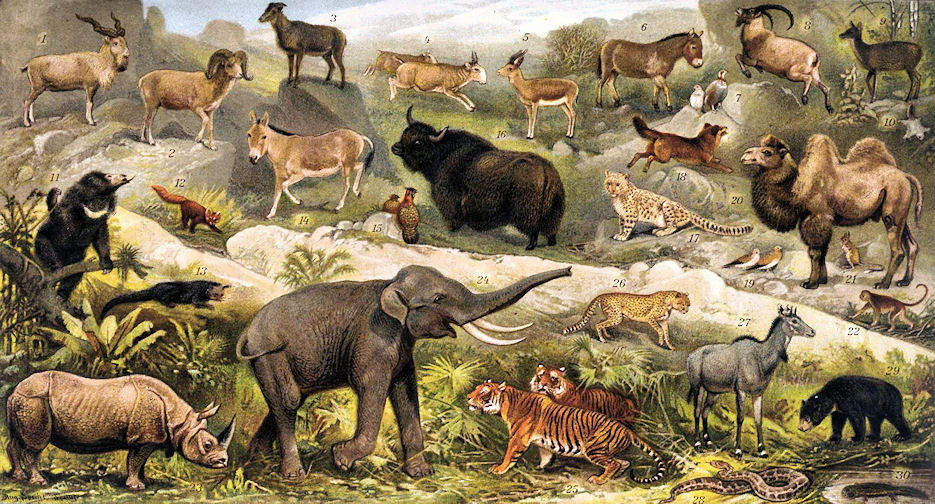
Abb.: Asiatische Tierwelt
[Bildquelle: Brockhaus' Kleines Konversationslexikon, 1906]
Referenzwerke:
Mammal species of the world : a taxonomic and
geographic reference / ed. by Don E. Wilson and DeeAnn M. Reeder. -- 3. ed.
-- Baltimore : John Hopkins Univ. Pr., 2005. -- 2 Bde. : 2142 S. -- ISBN
0-8o18-8221-4 [Normierend für lateinische und englische Säugetiernamen]
Menon, Vivek:
Mammals of India. -- New Jersey : Princeton UP, ©2009. -- 201 S. : Ill. --
ISBN 978-0-691-14067-4 [Sehr gute Übersicht über die wichtigsten Säugetiere
Indiens]
Walker's mammals of the world
/ Ronald M. Nowak; John L. Paradiso. - Baltimore, Md. [u.a.] : Johns Hopkins
Univ. Pr., 1999. -- 2 Bde. -- ISBN 0-8018-3970-X [Referenzwerk für
Säugetiere]
Übersicht
- 2.9.9. Bubalus bubalis arnee Kerr, 1792. - Wilder
Wasserbüffel -
Wild Water Buffalo
- 2.9.9.1. Domestizierter Wasserbüffel
- 2.9.9.2. Mahiṣāsuramardinī
- 2.9.10. Canis aureus indicus Hodgson, 1833 -
Indischer Goldschakal - Indian Golden Jackal
- 2.9.11. Wildkatzen und Hauskatze
- 2.9.12. Varanus sp. - Warane - Monitor lizards
- 2.9.13. Stachelschweine
- 2.9.13.1. Stachelschweinborsten
- 2.9.14. Eine schnelle Antilopenart
- 2.9.15. Canis lupus pallipes
Sykes, 1831 -
Indischer Wolf - Indian Wolf
- 2.9.16. Antilopen und Gazellen
- 2.9.17. Adjektivbildung zur Eṇa-Antilope
- 2.9.18. Fell-Lieferanten
- 2.9.19. Verschiedenerlei Wild
- 2.9.19.1. कृष्णसार - kṛṣṇasāra m.: Schwarzscheckiger, schwarzscheckige
Antilope (Moschiola indica Gray, 1843 - Indian Spotted Chevrotain +
Moschiola meminna Erxleben,
1777 ?)
- 2.9.19.2. रुरु - ruru m.:
Rucervus duvaucelii G.
Cuvier, 1823 - Barasingha / Zackenhirsch - Barasingha (Swamp Deer)
- 2.9.19.3. न्यङ्कु - nyaṅku m.:
Axis porcinus Zimmermann, 1780 - Schweinshirsch - Hog Deer
- 2.9.19.4. रङ्कु - raṅku m.: Raṅku
- 2.9.19.5. शम्बर - śambara m.:
Rusa unicolor Kerr, 1792 - Sambar
- 2.9.19.6. रौहिष - rauhiṣa m.: Rauhiṣa
- 2.9.19.7. गोकर्ण - gokarṇa m.: "Kuhohr"
- 2.9.19.8. पृषत - pṛṣata m.: Gesprenkelter =
Axis axis Erxleben, 1777 - Axishirsch - Chital
- 2.9.19.9. एण - eṇa m.:
vielleicht = Moschiola indica Gray, 1843 - Indian Spotted Chevrotain (Mouse Deer)
- 2.9.19.10. ऋश्य - ṛśya m.:
Moschus leucogaster Hodgson, 1839 - Himalaya-Moschushirsch -
Himalayan Musk Deer
- 2.9.19.11. रोहित - rohita m.: Roter
- 2.9.19.12. चमर - camara m.:
Bos grunniens Przewalski, 1883 - Yak - གཡག་ (männl.) / འབྲི (weibl.)
- 2.9.19.13. Wild, für das ich keine eindeutige Zuordnung zu
obigen Sanskritbezeichnungen machen konnte
- 2.9.19.13.1. Hirsche, Moschushirsche, Hirschferkel
- 2.9.19.13.2. Wildziegen, Wildschafe, Ziegenantilopen
- 2.9.20 Gandharva
- 2.9.21. Śarabha
- 2.9.22. राम - rāma m.: Boselaphus tragocamelus Pallas, 1766 - Nilgauantilope - Nilgai
- 2.9.23. सृमर - sṛmara m.: Ein großes Wildschwein (Sus scrofa
var.)
- 2.9.24. Bos frontalis Lambert, 1804 - Gaur
- 2.9.25. Hasen und Kaninchen
- 2.9.25.1. Der Hase im Mond
- 2.9.26. Vieh
- 2.9.26.1. Paśupati, der Herr der Tiere
- 2.9.27. Ratten und Mäuse
2.9.9. Bubalus bubalis arnee Kerr, 1792. - Wilder Wasserbüffel -
Wild Water Buffalo
|
4.c./d. lulāyo mahiṣo vāhādviṣat-kāsara-sairibhāḥ
लुलायो महिषो वाहाद्विषत्-कासर-सैरिभाः ॥४ ख॥
[Bezeichnungen für Bubalus bubalis arnee Kerr, 1792. - Wilder Wasserbüffel -
Wild Water Buffalo:]
-
लुलाय -
lulāya m.: Wasserbüffel
- महिष -
mahiṣa m.: Gewaltiger, Wasserbüffel
- वाहाद्विषत्
- vāhādviṣat m.: der kein Feind des Zugtier(seins) ist, der
kein Feind des Wagens ist
- कासर -
kāsara m.: Kāsara
- सैरिभ
- sairibha m.: Pflug-Elefant
|
Colebrooke (1807): "A buffalo."
Eines der für den Menschen gefährlichsten Tiere. Paart sich mit
domestizierten Wasserbüffeln.
Kommt mit zwei verschiedenen Hornformen vor (siehe Abb.)
Schulterhöhe: 155 - 180 cm
Gewicht: 800 - 1200 kg
Lebensraum: früher ganz Indien, heute in der Wildform nur noch Assam und
Zentralindien
Noch in Freiheit lebende Individuen: über 1200
Lebt als Einzelgänger oder in Herden von bis zu 20 Tieren
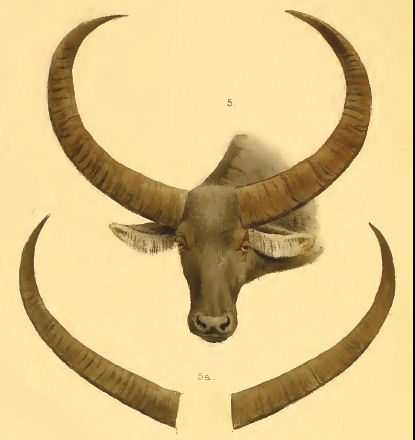
Abb.: महिषः ।
Bubalus bubalis Kerr 1792. -
Wasserbüffel - Water Buffalo
[Bildquelle: Lydekker, Richard <1849 - 1915>: The great and small
game of India, Burma, & Tibet. -- London, 1900. -- Pl. 2]
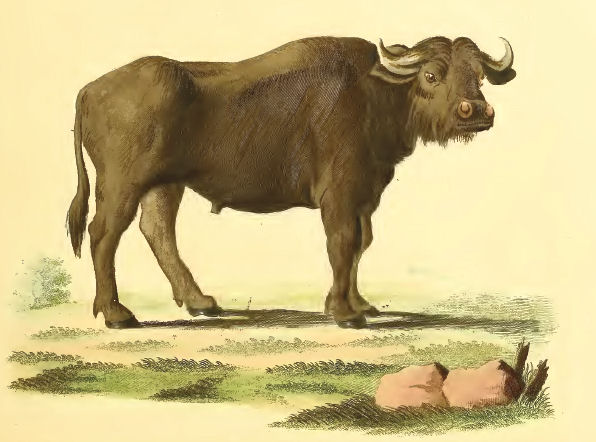
Abb.: महिषः ।
Bubalus bubalis Kerr 1792. -
Wasserbüffel - Water Buffalo
[Bildquelle: Die Säugthiere in Abbildungen nach der Natur, mit
Beschreibungen von Johann Christian Daniel von Schreber ... Fortgesetzt von d.
August Goldfuss ..., 1797 - 1861. -- Tafel CCC.A]

Abb.: महिषः ।
Bubalus bubalis arnee Kerr 1792. - Wilde Wasserbüffel -
Wild Water Buffalos, Kaziranga National Park -
কাজিৰঙা ৰাষ্ট্ৰীয় উদ্যান, Assam
[Bildquelle: Janani. --
http://www.flickr.com/photos/jannysooria/4211604792/. -- Zugriff am
2010-12-15. --
Creative Commons Lizenz (Namensnennung, keine kommerzielle Nutzung)]
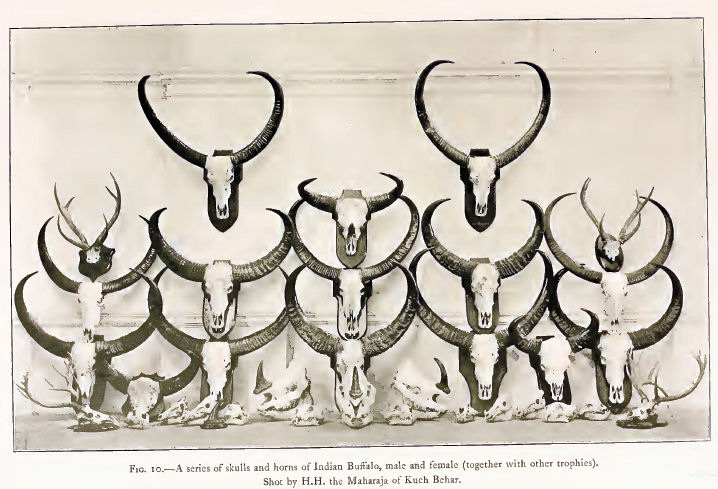
Abb.: Sammlung von Hörnern von Wilden Wasserbüffeln, die Seine Königliche Hoheit, der Maharaja von Kuch Behar (কোচবিহার)
ermordet hat
[Bildquelle: Lydekker, Richard <1849 - 1915>:
The great and small game of India, Burma, & Tibet. --
London, 1900. -- Fig. 10]
|
"The wild buffalo is found in the swampy Terai
at the foot of the hills, from Bhotan to Oude ; also, in the plains of
lower Bengal as far west as Tirhoot, but increasing in numbers to the
eastwards, on the Burrampooter, and in the Bengal Sunderbuns. It also occurs
here and there through the eastern portion of the table-land of Central
India, from Midnapore to Raepore, and thence extending south nearly to
the Godavery. South and west of this it does not, to my knowledge,
occur in India, but a few are found in the north and north-east of Ceylon.
"The Arna," says Mr. Hodgson, "inhabits the margin rather than the interior of primaeval forests. They never
ascend the mountains, and adhere, like the Rhinoceros, to the most swampy sites
of the districts they inhabit. It ruts in autumn, the female
gestating 10 months, and produces one or two young in summer. It lives in large
herds, but in the season of love, the most lusty males lead off and
appropriate several females, with which they form small herds for the time. The
bull is of such power and vigour as by his charge frequently to
prostrate a good-sized elephant. They are uniformly in high condition, so
unlike the leanness and angularity of the domestic buffalo, even at its best."
Mr. Blyth states it as his opinion that,
except in the valley of the Ganges and Burrampooter, it has been introduced and
become feral. With this view I cannot agree, and had Mr. Blyth seen
the huge buffaloes I saw on the Indrawutty river (in 1857), he would,
I think, have changed his opinion. They have hitherto not been recorded
south of Raepore, but where I saw them is nearly 200 miles south. I
doubt if they cross the Godavery river.
I have seen them repeatedly, and killed
several in the Purneah district. Here they frequent the immense tracts of long
grass abounding in dense, swampy thickets, bristling with canes and
wild roses; and in these spots, or in the long elephant-grass on the bank of jheels, the buffaloes lie during the heat of the day. They feed chiefly at
night or early in the morning, often making sad havoc in the fields, and
retire in general before the sun is high. They are by no means shy (unless
they have been much hunted), and even on an elephant, without which they
could not be successfully hunted, may often be approached within good
shooting distance. A wounded one will occasionally charge the elephant,
and as I have heard from many sportsmen will sometimes overthrow the
elephant. I have been charged by a small herd, but a shot or two as
they are advancing will usually scatter them.
Hodgson remarks that "there is no animal
upon which ages of domestication have made so small an impression as upon the
Buffalo, the tame species being still most clearly referrible
to the wild ones." He also states that the tame buffaloes when driven to the
forests to be depastured have intercourse with the wild bulls, and the
breed is thus improved. In Purneah I was informed, however, that the
wild buffalo dislike the presence of tame ones exceedingly, and will even
retire from the spot where the tame ones are feeding.
The domestic buffalo is extensively used in
India both for draught and as milch cattle, and its milk is richer than
that of the cow of India. Some of the hill races, such as those on the
Neelgherries, are very fine animals resembling the wild buffalo ; and many along
the crests of the Western Ghats, and elsewhere, are seen with white
legs like the Gaur."
[Quelle: Jerdon,
Thomas Claverhill <1811-1872>: The mammals of India : a natural history of
all the animals known to inhabit continental India. -- London, 1874. -- S.
308f.] |
2.9.9.1. Domestizierter Wasserbüffel

Abb.:
महिषः ।
Bubalus bubalis Kerr 1792. - Domestizierte
Wasserbüffel - Water Buffalo, Indien
[Bildquelle:
Brian Gratwicke. --
http://www.flickr.com/photos/briangratwicke/3596848274/. -- Zugriff am
2010-12-09. --
Creative Commons Lizenz (Namensnennung)]
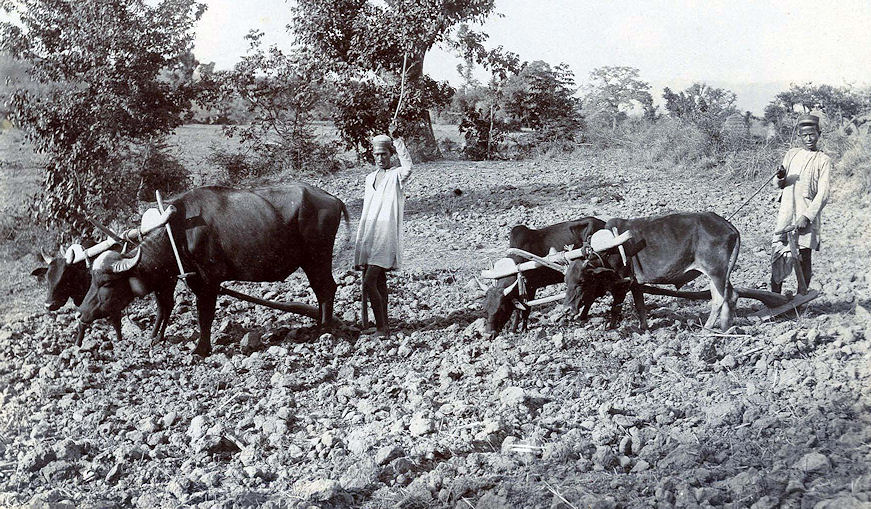
Abb.: सैरिभः ।
Domestizierte Wasserbüffel als Pfluggespann, Punjab
[Bildquelle: Northampton Museum. --
http://www.flickr.com/photos/northampton_museum/5043373393/. -- Zugriff am
2010-12-09. --
Creative Commons Lizenz (Namensnennung)]

Abb.:
सैरिभः ।
Domestizierte Wasserbüffel als Pfluggespann, Sri Lanka
[Bildquelle:
James Manners. --
http://www.flickr.com/photos/jmanners/1013173792/. -- Zugriff am 2010-12-09.
-- Creative Commons
Lizenz (Namensnennung, keine kommerzielle Nutzung)]
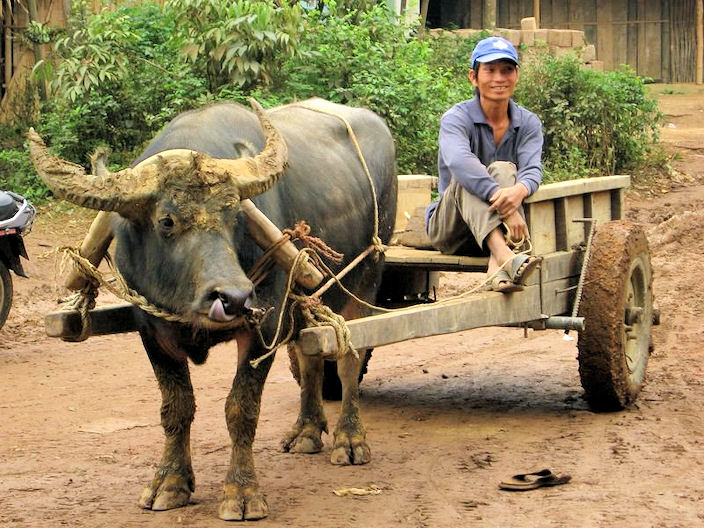
Abb.: वाहाद्विषन्तौ
। Domestizierte Wasserbüffel, Vietnam
[Bildquelle:
Mark
Robertson. --
http://www.flickr.com/photos/riverdaleto/111056662/. -- Zugriff am
2011-01-16. --
Creative Commons Lizenz (Namensnennung, keine kommerzielle Nutzung)]

Abb.: Verbreitung der Domestizierten Wasserbüffel nach Ländern 2004 (Indien = 100% = t (India -
97.700.000)
[Bildquelle: Anwar saadat / Wikimedia. -- Public domain]
Siehe
Carakasaṃhitā: Ausgewählte Texte aus der Carakasaṃhitā
/ übersetzt und erläutert von Alois Payer <1944 - >. -- Anhang B: Tierbeschreibungen. --
Bubalus bubalis. -- URL:
http://www.payer.de/ayurveda/tiere/bubalus_bubalis.htm
2.9.9.2. Mahiṣāsuramardinī
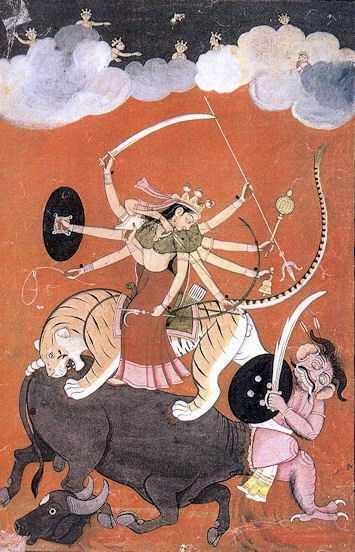
Abb.: महिषासुरमर्दिनी - Mahiṣāsuramardinī: Durgā als Vernichterin
des Dämons Mahiṣāsura, 19. Jhdt
[Bildquelle: Wikipedia. -- Public domain]
| "According to a narrative in the Devi Mahatmya story of the
Markandeya Purana text, Durga was created as a warrior goddess to fight an asura
(an inhuman force/demon) named Mahishasura. He had unleashed a reign of terror
on earth, heaven and the nether worlds, and he could not be defeated by any man
or god, anywhere. The gods went to Brahma, who had given Mahishasura the power
not to be defeated by a man. Brahma could do nothing. They made Brahma their
leader and went to Vaikuntha — the place where Vishnu lay on Ananta Naag. They
found both Vishnu and Shiva, and Brahma eloquently related the reign of terror
Mahishasur had unleashed on the three worlds. Hearing this Vishnu, Shiva and all
of the gods became very angry and beams of fierce light emerged from their
bodies. The blinding sea of light met at the Ashram of a priest named Katyan.
The goddess Durga took the name Katyaayani from the priest and emerged from the
sea of light. She introduced herself in the language of the Rig-Veda, saying she
was the form of the supreme Brahman who had created all the gods. Now she had
come to fight the demon to save the gods. They did not create her; it was her
lila that she emerged from their combined energy. The gods were blessed with
her compassion. It is said that upon initially encountering Durga,
Mahishasura underestimated her, thinking: "How can a woman kill me, Mahishasur —
the one who has defeated the trinity of gods?" However, Durga roared with laughter, which caused an
earthquake which made Mahishasur aware of her powers.
And the terrible Mahishasur rampaged against her, changing
forms many times. First he was a buffalo demon, and she defeated him with her
sword. Then he changed forms and became an elephant that tied up the goddess's
lion and began to pull it towards him. The goddess cut off his trunk with her
sword. The demon Mahishasur continued his terrorizing, taking the form of a lion,
and then the form of a man, but both of them were gracefully slain by Durga.
Then Mahishasur began attacking once more, starting to
take the form of a buffalo again. The patient goddess became very angry, and as
she sipped divine wine from a cup she smiled and proclaimed to Mahishasur in a
colorful tone — "Roar with delight while you still can, O illiterate demon,
because when I will kill you after drinking this, the gods themselves will roar
with delight". When Mahishasur had half emerged into his buffalo form, he
was paralyzed by the extreme light emitting from the goddess's body. The goddess
then resounded with laughter before cutting Mahishasur's head down with her
sword.
Thus Durga slew Mahishasur, thus is the power of the
fierce compassion of Durga. Hence, Mata Durga is also known as
Mahishasurmardhini — the slayer of Mahishasur. According to one legend, the
goddess Durga created an army to fight against the forces of the demon-king
Mahishasur, who was terrorizing Heaven and Earth. After ten days of fighting,
Durga and her army defeated Mahishasur and killed him. As a reward for their
service, Durga bestowed upon her army the knowledge of jewelry-making. Ever
since, the Sonara community has been involved in the jewelry profession.
The goddess, as Mahisasuramardhini, appears quite early in
Indian art. The Archaeological Museum in Matura has several statues on display
including a 6-armed Kushana period Mahisasuramardhini that depicts her pressing
down the buffalo with her lower hands.
A Nagar plaque from the first century BC - first century AD depicts a 4-armed
Mahisamardhini accompanied by a lion. But it is in the Gupta period that we see
the finest representations of Mahisasuramardhini (2-, 4-, 6-, and at Udayagiri,
12-armed). The spear and trident are her most common weapons. A Mamallapuram
relief shows the goddess with 8 arms riding her lion subduing a buffalo-faced
demon (as contrasted with a buffalo demon); a variation also seen at Ellora. In
later sculptures (post-seventh Century), sculptures show the goddess having
decapitated the buffalo demon."
[Quelle:
http://en.wikipedia.org/wiki/Mahishasuramardini. --
Zugriff am 2011-01-16] |
2.9.10. Canis aureus indicus Hodgson, 1833 -
Indischer Goldschakal - Indian Golden Jackal
5. striyāṃ śivā bhūrimāya-gomāyu-mṛgadhūrtakāḥ
śṛgāla-vañcaka-kroṣṭu-pheru-pherava-jambukāḥ
स्त्रियां शिवा भूरिमाय-गोमायु-मृगधूर्तकाः ।
शृगाल-वञ्चक-क्रोष्टु-फेरु-फेरव-जम्बुकाः ॥५॥
[Bezeichnungen für Canis aureus indicus Hodgson, 1833 -
Indischer Goldschakal - Indian Golden Jackal:]
-
शिवा - śivā f.: die
Gnädige, Gattin Śivas (fem. auch für Männchen!)
- भूरिमाय
- bhūrimāya m.: Täuschung auf der Erde1
- गोमायु
- gomāyu m.: wie ein Rind Brüllender
- मृगधूर्तक
- mṛgadhūrtaka m.: Wild-Betrüger
- शृगाल
- śṛgāla m.: Schakal
- वञ्चक
- vañcaka m.: Betrüger
- क्रोष्टु
- kroṣṭu m.: Schreier
- फेरु -
pheru m.: Schakal
- फेरव -
pherava m.: Schakal
- जम्बुक
- jambuka m.: Jambuka (zu jambu f.: Syzygium jambos (L.)
Alston 1931 - Rosenapfel - Malabar Plum / Rose Apple)2
|
Colebrooke (1807): "A shakal."
1 भूरिमाय
- bhūrimāya m.: Täuschung auf der Erde
|
"MĀYĀ. 'Illusion, deception.' Illusion
personified as a female form of celestial origin, created for
the purpose of beguiling some individual Sometimes identified with
Durgā as the source of spells, or as a personification of
the unreality of worldly things. In this character she is called Māyā-devī or
Mahāmāyā."
[Quelle: Dowson, John
<1820-1881>: A classical dictionary of Hindu mythology and
religion, geography, history, and literature. -- London, Trübner,
1879. -- s.v. ] |
2 जम्बुक
- jambuka m.: Jambuka (zu jambu f.: Syzygium jambos (L.) Alston 1931 - Rosenapfel - Malabar Plum /
Rose Apple)
Vielleicht wegen seiner Farbe
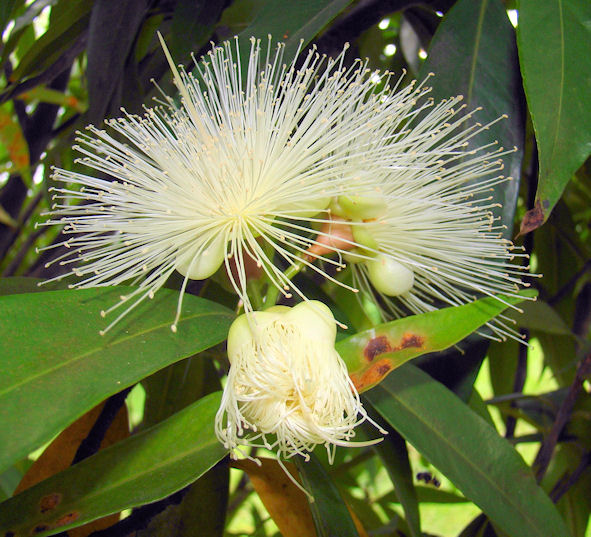
Abb.: जम्बुः । Syzygium
jambos (L.) Alston 1931 - Rosenapfel
- Malabar Plum / Rose Apple
[Bildquelle: mauroguanandi. --
http://www.flickr.com/photos/mauroguanandi/3320773767/. --
Zugriff am 2011-01-16. --
Creative Commons Lizenz (Namensnennung)]
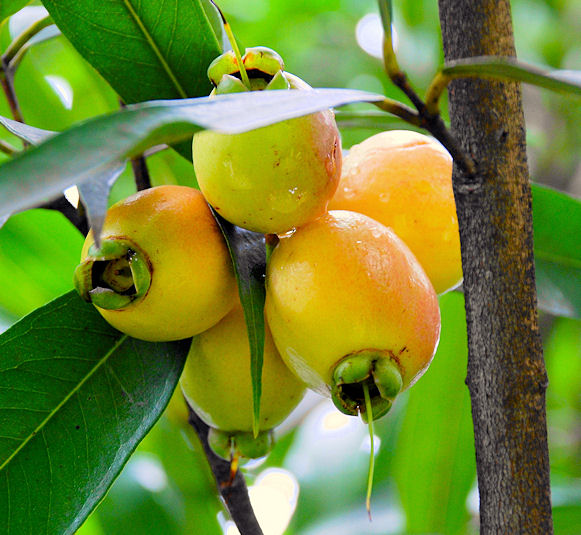
Abb.: जम्बुः । Syzygium
jambos (L.) Alston 1931 - Rosenapfel
- Malabar Plum / Rose Apple
[Bildquelle: mauroguanandi. --
http://www.flickr.com/photos/mauroguanandi/3321640922/ . --
Zugriff am 2011-01-16. --
Creative Commons Lizenz (Namensnennung)]
Canis aureus indicus Hodgson, 1833 - Indischer Goldschakal -
Indian Golden Jackal
Sein Geheul ist typisch für den indischen Dschungel.
Körperlänge: 60 - 75 cm
Gewicht: 7 - 15 kg
Lebensraum: ganz Indien, bis 3000 m ü. M., Städte und Siedlungen
Noch in Freiheit lebende Individuen: unbekannt
Lebt als Einzelgänger, oder paarweise oder in Rudeln
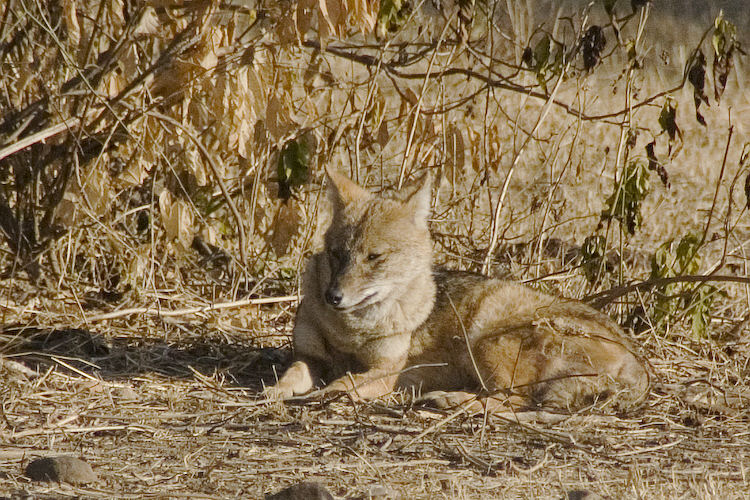
Abb.: शृगालः
।
Canis aureus indicus Hodgson, 1833 - Indischer Goldschakal -
Indian Golden Jackal, Sariska Tiger Reserve - सरिस्का राष्ट्रीय उद्यान, Rajasthan
[Bildquelle:
Digital.Knave. --
http://www.flickr.com/photos/digitalknave/344220065/. -- Zugriff am
2007-07-15. --


 Creative
Commons Lizenz (Namensnennung, keine kommerzielle Nutzung, keine
Bearbeitung)]
Creative
Commons Lizenz (Namensnennung, keine kommerzielle Nutzung, keine
Bearbeitung)]
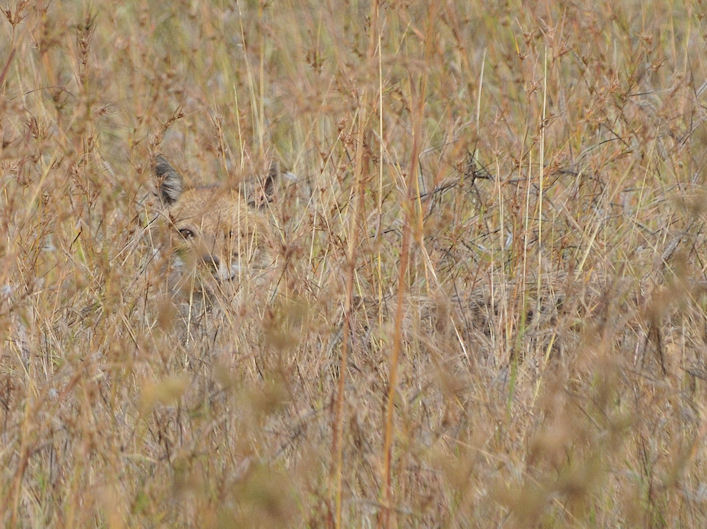
Abb.: भूरिमायः
। मृगधूर्तकः । वञ्चकः । Canis aureus indicus Hodgson,
1833 - Indischer Goldschakal - Indian Golden Jackal, Seoni, Madhya Pradesh
[Bildquelle:
Tarique Sani. --
http://www.flickr.com/photos/tariquesani/3716555124/. -- Zugriff am
2011-01-16. --
Creative
Commons Lizenz (Namensnennung, keine kommerzielle Nutzung, share alike)]
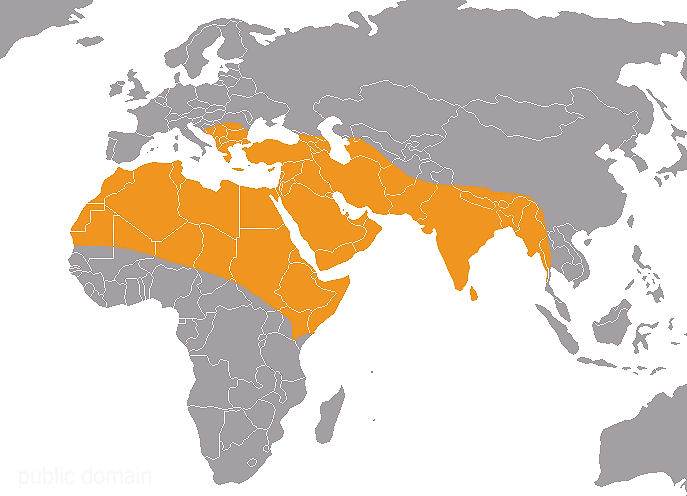
Abb.: Ungefährer Lebensraum des Canis aureus
Linnaeus, 1758 - Goldschakal - Golden Jackal
[Bildquelle: Jonathan Hornung / Wikipedia. -- GNU FDLicense]
Siehe:
Carakasaṃhitā: Ausgewählte Texte aus der Carakasaṃhitā
/ übersetzt und erläutert von Alois Payer <1944 - >. -- Anhang B: Tierbeschreibungen. --
Canis aureus. -- URL:
http://www.payer.de/ayurveda/tiere/canis_aureus.htm
|
"The Jackal varies considerably in the colour
of its fur according to season and locality. A black variety is by no
means rare in Bengal ; but I never saw or heard of it in the south
of India.
This well-known animal abounds throughout all
India, and its habits are too well known to require much notice. It
occurs also in Ceylon, but is rare in lower Burmah, and said to be
only of recent introduction there. It is a very useful scavenger,
clearing away all garbage and carrion from the neighbourhood of large towns,
but occasionally committing depredations among poultry and other domestic
animals. Sickly sheep and goats usually fall a prey to him ;
and a wounded antelope is pretty certain to be tracked and hunted to
death by jackals. They will however partake freely of vegetable food.
Sykes says he devastates the vineyards in the west of India ; in
Bhagulpore he is said to be fond of sugar-cane ; and he everywhere consumes large
quantities of the bēr fruit, Zizyphus jujuba. In Wynaad, as well as
in Ceylon, he devours considerable quantities of ripe
coffee-berries : the seeds pass through him, well pulped, and are found and picked up
by the coolies : it is asserted that the seeds so found make the
best coffee !
The female jackal brings forth about four
young in holes in the ground, occasionally in dry drains in cantonments.
The Jackal is easily pulled down by greyhounds, but gives an excellent
run with foxhounds. They are very tenacious of life, and sham dead in
a way to deceive even an experienced sportsman. I have seen one, after
being worried by a pack of hounds, and getting a good rap or two on
its head with a heavy whip, limp off some time afterwards when
unobserved, with apparently a good chance of affording another run on a future
day. I have known a jackal come to the aid of his comrade (or
mate perhaps) when seized by greyhounds, and attack them furiously, whilst
I was close by on horseback. The call of the jackal is familiar
to all residents in India, and is certainly the most unearthly and
startling music. The natives assert that they cry after every watch of the
night. Jackals not unfreqently get hydrophobia, especially in
Bengal, and I have known several fatal cases from their bite.
Connected with the old name of the "lion's
provider" are the generally credited tales about one always attending the
tiger. Mr. Elliot says, "Native sportsmen universally believe that
an old jackal, which (in the South of India) they call Bhālū is in
constant attendance on the tiger, and whenever his cry is heard, which is
peculiar and different from that of the jackal generally, the vicinity of a
tiger is confidently pronounced. I have heard the cry attributed to the Bhālū,
frequently." The " Kole bhaloo" is frequently referred to by
Lieutenant Rice, in his very interesting work on "Tiger-shooting in Rajpootana," as
having been frequently heard and seen by him in company
with the tiger. In Bengal the same jackal is called " Phēall" or
Phao, or Pheeow, or Phnew, from its call, and in some parts Ghog,
though that name is said by some to refer to some other (fabulous)
animal. "It is," says Johnson, in his Field Sports of India, as
quoted in the India Sporting Review, N.S. vol. I., "a jackal following the scent of the tiger
and making a noise very different from their
usual cry, which I imagine they do for the purpose of warning their species
of danger." Again, "Soon after the tiger passed within a few yards of
us. In a minute or two after he had passed, we plainly saw the
jackal, and heard him cry when very near us. I have often heard it said that
the Pheall (or provider, as it is sometimes called) always goes before
the tiger, but in this instance he followed him, which I have also
seen him do at other times. "Whether he is induced to follow the tiger
for the sake of coming in for part of the booty, or whether he merely
follows as small birds often follow a bird of prey, I cannot say. Evidently his
cry is different from what it is at other times, which indicates danger
being near, particularly as whenever that cry is heard the voice of no
other jackal is, nor is that particular call ever heard in any part of the
country where there are not large beasts of prey. Pheall, I believe, was
the original, and is now the usual name, from its resembling the cry they
make ; but they are better known in Ramghur by the name Phinkar, which
means crier proclaimer or warner." Mr. Blyth records that, "some time ago I heard a pariah dog, upon sniffing the collection of
live tigers, before referred to, set up the most extraordinary cry I have ever
heard uttered by a dog, and which I cannot pretend to record more
intelligibly, but it was doubtless an analogous note to the Pheall cry
of the jackal." I have often heard this peculiar cry, and seen a
jackal following a tiger in various parts of the country ; and I have
already noted my turning a jackal out of the same bush as a cheeta.
A horn is supposed by the natives in the same
parts of India to grow on the head of some jackals, which is of
great reputed virtue, ensuring prosperity to its possessor. The same idea is
prevalent in Ceylon.
The Jackal is found over a great part of
Asia, in Southern Europe, and in Northern Africa."
[Quelle: Jerdon,
Thomas Claverhill <1811-1872>: The mammals of India : a natural history of
all the animals known to inhabit continental India. -- London, 1874. -- S.
142ff.] |
2.9.11. Wildkatzen und Hauskatze
|
6.a./b. otur biḍālo mārjāro vṛṣadaṃśaka ākhubhuk
ओतुर् बिदालो मार्जारो वृषदंशक आखुभुक् ।६ क।
[Bezeichnungen für Wildkatzen und Hauskatze:]
-
ओतु - otu m.: Katze (zu
av 1: erquicken, fördern, schützen)
- बिदाल
- biḍāla m.: Katze
- मार्जार
- mārjāra m.: der Abwischer, der (sich) Waschende
- वृषदंशक
- vṛṣadaṃśaka m.: der Männer beißt; der potente Beißer
- आखुभुज्
- ākhubhuj m.: Maus-Fresser
|
Colebrooke (1807): "A cat."
Die wichtigsten Wildkatzen Indiens sind:
- Felis chaus Schreber, 1777 - Rohrkatze - Jungle Cat
- Felis silvestris ornata Gray, 1832 - Asiatische Wildkatze - Asiatic Wild Cat / Desert Cat
- Prionailurus bengalensis Kerr, 1792 - Bengalkatze - Leopard Cat
- Prionailurus rubiginosus I. Geoffroy
Saint-Hilaire, 1831- Rostkatze - Rusty-Spotted Cat
- Prionailurus viverrinus Bennett, 1833 -
Fischkatze - Fishing Cat
Dazu kommt
- Felis catus Linnaeus, 1758 - Hauskatze - Domestic Cat
Felis chaus Schreber, 1777 - Rohrkatze - Jungle Cat
Körperlänge: 60 cm
Gewicht: 5 - 6 kg
Lebensraum: ganz Indien, bis 2400 m ü. M.
Noch in Freiheit lebende Individuen: unbekannt
Lebt als Einzelgänger oder paarweise
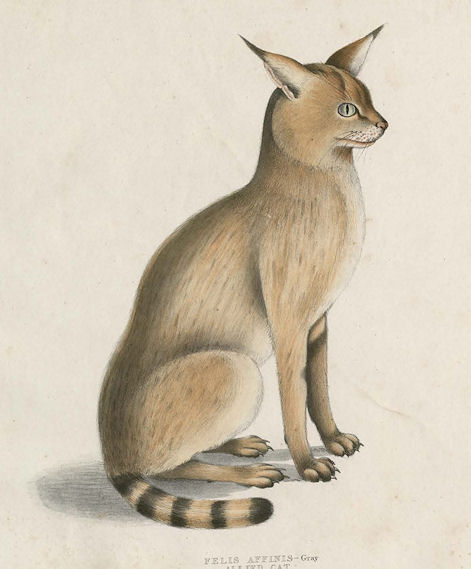
Abb.: Felis chaus Schreber, 1777 - Rohrkatze - Jungle Cat
[Bildquelle: Hardwicke I, 1830. -- S. 18.]
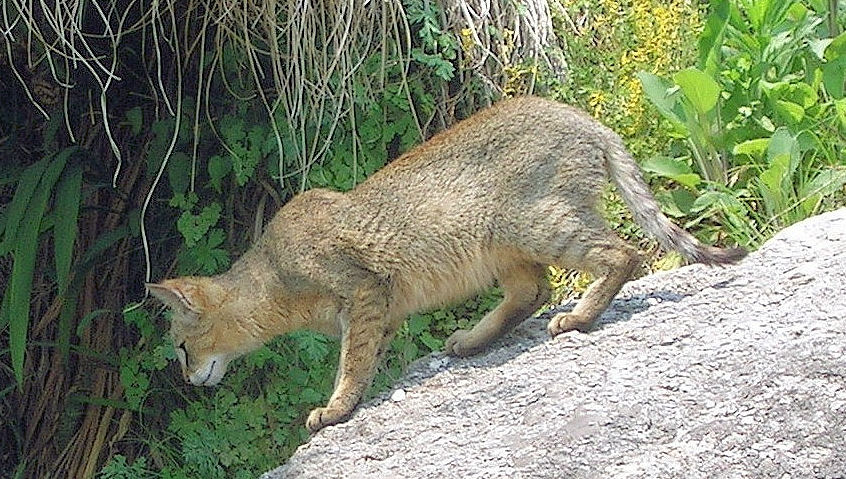
Abb.: Felis chaus Schreber, 1777 - Rohrkatze - Jungle Cat, Munsiyari,
Uttarakhand
[Bildquelle: L. Shyamal / Wikipedia. --
Creative Commons Lizenz (Namensnennung, share alike)]
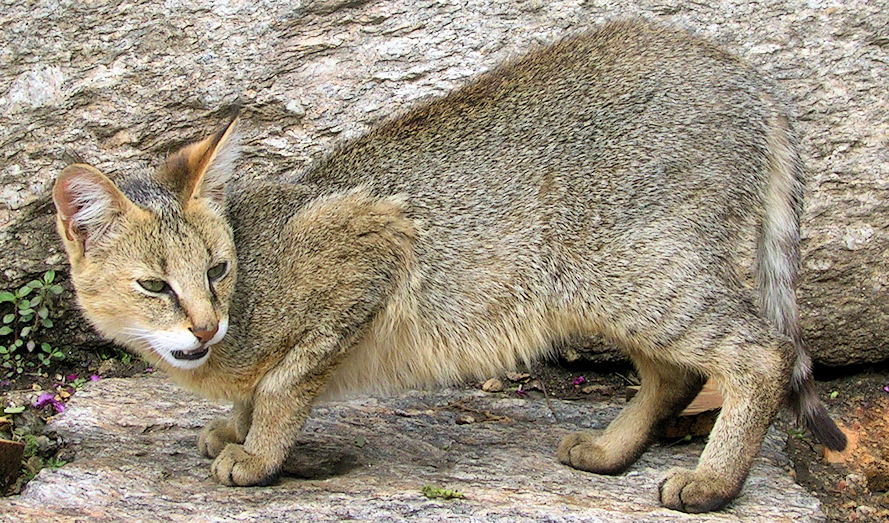
Abb.: Felis chaus Schreber, 1777 - Rohrkatze - Jungle Cat, Munsiyari,
Uttarakhand
[Bildquelle: L. Shyamal / Wikipedia. --
Creative Commons Lizenz (Namensnennung, share alike)]

Abb.: Lebensraum von Felis chaus Schreber, 1777 - Rohrkatze - Jungle Cat
[Bildquelle: Chermundi - IUCN / Wikipedia. --
Creative Commons
Lizenz (Namensnennung, share alike)]
|
"This is the common wild cat over all India,
from the Himalayas to Cape Comorin, and from the level of the sea
to 7,000 or 8, 000 feet of elevation. It frequents alike jungles and the
open country, and is very partial to long grass and reeds, sugar-cane
fields, corn-fields, &c. It does much damage to game of all kinds hares,
partridges, &c., and quite recently I shot a peafowl at the edge of a
sugar-cane field, when one of these cats sprang out, seized the peafowl,
and after a short struggle (for the bird was not dead) carried it off before
my astonished eyes, and in spite of my running up, made good his escape
with his booty. It must have been stalking these very birds, so
immediately did its spring follow my shot. It is occasionally very destructive
to poultry.
It is said to breed twice a year, and to have
three or four young at a birth. I have very often had the young
brought me, but always failed in rearing them, and they always evinced a
most savage and untameable disposition. I have seen numbers of cats
about villages in various parts of the country, that must have been hybrids
between this cat and tame ones ; and Mr. Elliot, as quoted by Blyth,
says the same.
A melanoid variety is not very rare in some
parts. Dr. Scott has procured it both near Hansi and in the
neighbourhood of Umballa.
This jungle-cat appears to be found
throughout Africa, most abundant perhaps in the north."
[Quelle: Jerdon,
Thomas Claverhill <1811-1872>: The mammals of India : a natural history of
all the animals known to inhabit continental India. -- London, 1874. -- S.
112.] |
Felis silvestris ornata Gray, 1832 - Asiatische Wildkatze - Asiatic Wild Cat / Desert Cat
Wird wegen ihres Fells gejagt (für einen Pelzmantel müssen mindestens 30
Katzen sterben).
Körperlänge: 47 - 54 cm
Gewicht: 2 - 4 kg
Lebensraum: Maharashtra, Madhya Pradesh, Gujarat
Noch in Freiheit lebende Individuen: unbekannt
Lebt als Einzelgänger
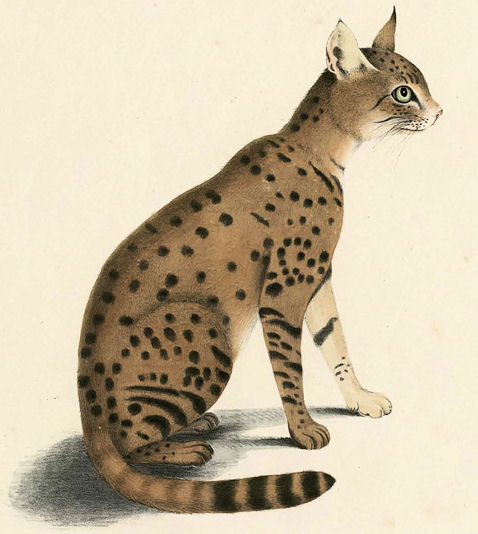
Abb.: Felis silvestris ornata Gray, 1832 - Asiatische Wildkatze - Asiatic Wild Cat / Desert Cat
[Bildquelle: Hardwicke I, 1830. -- S. 16.]
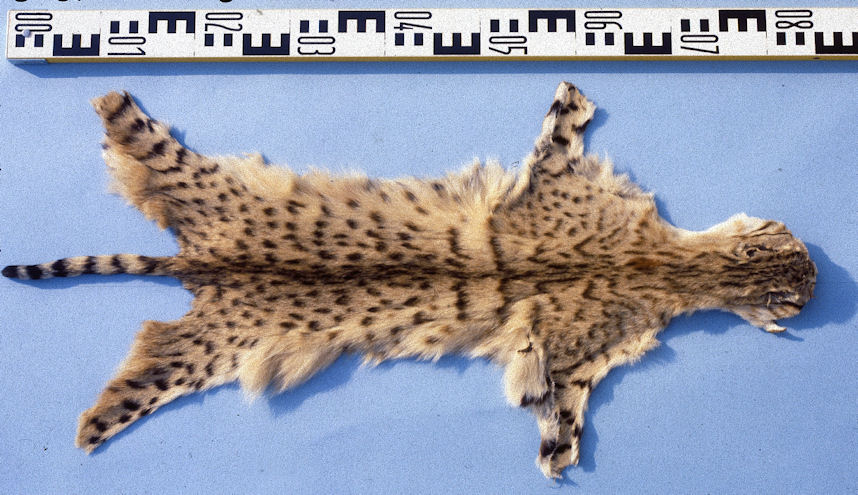
Abb.: Ermordete Felis silvestris ornata Gray, 1832 - Asiatische Wildkatze - Asiatic Wild Cat / Desert Cat, ehemalige Bundes-Pelzfachschule, Frankfurt/Main
[Bildquelle: Mickey Bohnacker / Wikipedia. -- Public domain]
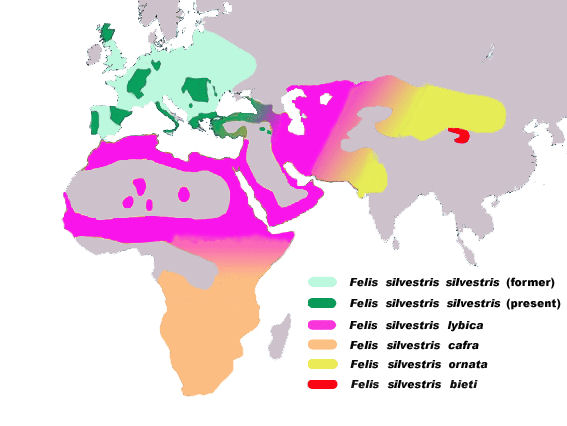
Abb.: Lebensräume der 5 Unterarten von Felis silvestris Schreber, 1775 - Wildkatze - Desert Cat
[Bildquelle: Christophe cagé / Wikipedia. -- GNU FDLicense]
|
"Mr. Blyth first obtained it from the district
of Humana, near Hansi ; and Dr. Scott, who sent the specimens, stated
that "it is very common at Hansi, frequenting open sandy plains,
where the field-rat must be its principal food. I hardly ever remember
seeing it in what could be called jungle, or even in grass. One of these
spotted cats lived for a long time under my haystack, and I believe
it to have been the produce of a tame cat by a wild one. The wild
one I have seen of half a dozen shades of colour, and you also
frequently see a tendency in these cats to run into stripes, especially on
the limbs."
I have procured it at Hissar, where it is
common ; at Mhow, far from rare ; also at Saugor, and near Nagpore,
rarely; but it does not appear to extend into the Gangetic valley, and is
rare south of the Nerbudda. Those I obtained at Mhow and Saugor were
generally killed by my greyhounds in corn and stubble fields, but I
have seen it in date-groves though never in jungle. At Hissar it is
almost always found among the low sand-hills, occasionally in bare
fields, usually in the same ground as the desert fox (Vulpes leucopus).
Here it appears to feed chiefly on the jerboa-rat (Gerbillus indicus),
so abundant in the sandy tract there."
[Quelle: Jerdon,
Thomas Claverhill <1811-1872>: The mammals of India : a natural history of
all the animals known to inhabit continental India. -- London, 1874. -- S.
110f.] |
Prionailurus bengalensis Kerr, 1792 - Bengalkatze - Leopard Cat
Körperlänge: 60 cm
Gewicht: 3 - 7 kg
Lebensraum: ganz Indien außer Deccan-Hochplateau und Trockengebiete Westindiens
Noch in Freiheit lebende Individuen: unbekannt
Lebt als Einzelgänger

Abb.: Prionailurus bengalensis Kerr, 1792 - Bengalkatze - Leopard Cat, Zoo
[Bildquelle: M Kuhn. --
http://www.flickr.com/photos/mkuhn/3816307969/. -- Zugriff am 2010-12-15. --
Creative
Commons Lizenz (Namensnennung, keine kommerzielle Nutzung, share alike)]
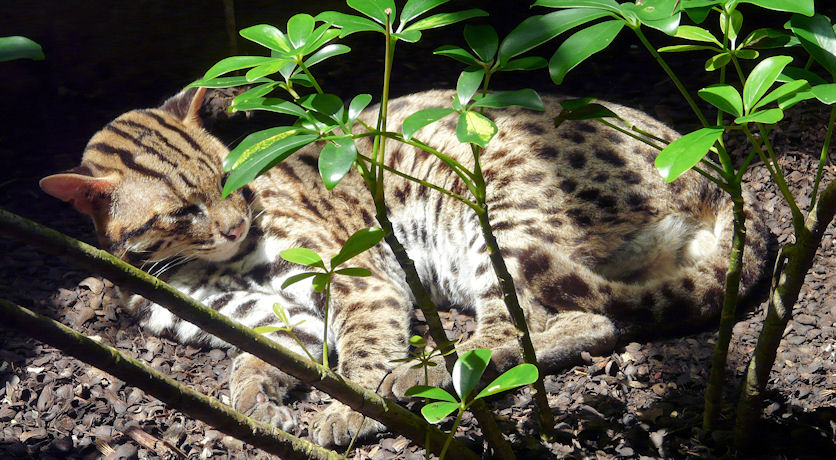
Abb.: Prionailurus bengalensis Kerr, 1792 - Bengalkatze - Leopard Cat, Zoo
[Bildquelle: Chensiyuan / Wikimedia. -- GNU FDLicense]
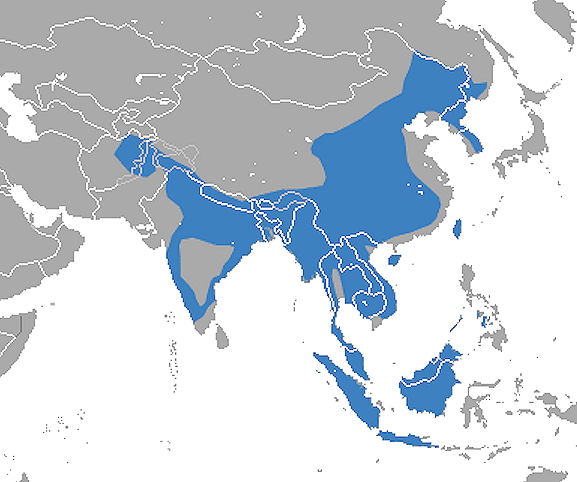
Abb.: Lebensräume von Prionailurus bengalensis Kerr, 1792 - Bengalkatze - Leopard Cat
[Bildquelle: Chermundi - IUCN / Wikipedia. --
Creative Commons
Lizenz (Namensnennung, share alike)]
|
"The Leopard-cat is found throughout the hilly
regions of India, from the Himalayas to the extreme south and
Ceylon, and in richly wooded districts, at a low elevation occasionally,
or where heavy grass jungle is abundant, mixed with forest and brushwood. In
the South of India it is most abundant in Coorg, Wynaad, and the
forest tract all along the Western ghats ; but is rare on the east
coast and in Central India. It ascends the Himalayas to a considerable
elevation, and is said by Hodgson even to occur in Tibet, and is found
at the level of the sea in the Bengal Sunderbuns. It extends through
Assam, Burmah, the Malayan peninsula, to the islands of Java and
Sumatra at all events.
Mr. Elliot says of his Wagati, that "it is
very fierce, living in trees in the thick forests, and preying on birds
and small quadrupeds. A shikaree declared that it drops on larger
animals and even on deer, and eats its way into the neck ; that the
animal in vain endeavours to roll or shake it off, and at last is
destroyed." In Coorg, I was informed that it lives in hollow trees, and commits
great depredations on the poultry of the villagers. It also destroys
hares, morse deer, &c. Hutton says, "I have a beautiful specimen alive, so
savage that I dare not touch her. They breed in May, have only three or
four young, in caves or beneath masses of rock." Mr. Blyth says, "I have had many in captivity, none of which ever showed a disposition to
become tame and confiding, even though but half-grown when they came
into my possession, but I never had a small kitten to begin with. It
never paces its cage for exercise during the daytime at least, but
constantly remains crouched in a corner, though awake and vigilant." I
have seen several caged, and now possess one, all of which were quite
untameable, and I noticed the same repose during the day that Mr. Blyth observed."
[Quelle: Jerdon,
Thomas Claverhill <1811-1872>: The mammals of India : a natural history of
all the animals known to inhabit continental India. -- London, 1874. -- S.
106f. |
Prionailurus rubiginosus I. Geoffroy
Saint-Hilaire, 1831- Rostkatze - Rusty-Spotted Cat
Kleinste Katze der Welt (1/2 bis 3/4 einer Hauskatze)
Körperlänge: 35 - 48 cm
Gewicht: 1 - 1,6 kg
Lebensraum: indischer Subkontinent bis Rajasthan, vereinzelt in Jammu und
Kashmir; auch in menschlichen Siedlungen (geniert manchmal ihre Jungen auf
Hausdächern)
Noch in Freiheit lebende Individuen: unbekannt
Lebt als Einzelgänger
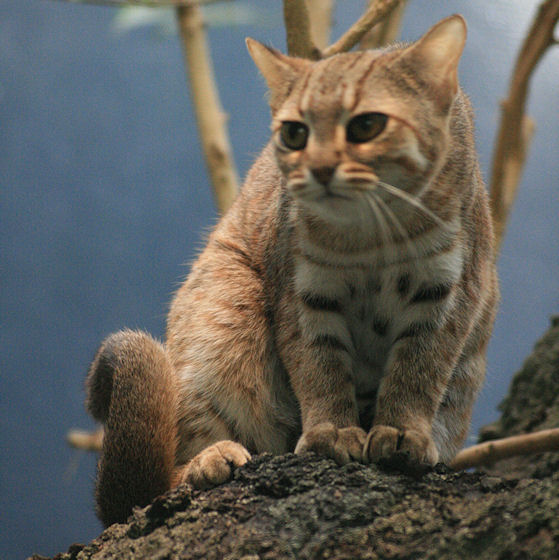
Abb.: Prionailurus rubiginosus I. Geoffroy
Saint-Hilaire, 1831- Rostkatze - Rusty-Spotted Cat, Zoo
[Bildquelle: UrLunkwill / Wikipedia. -- GNU FDLicense]
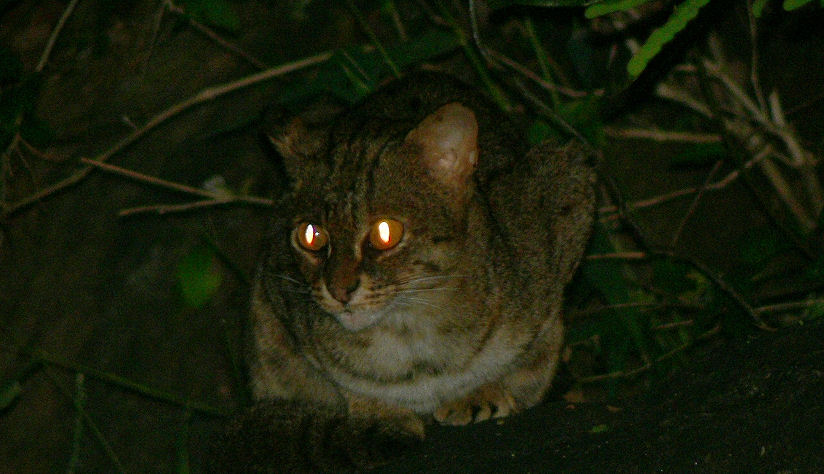
Abb.: Prionailurus rubiginosus I. Geoffroy
Saint-Hilaire, 1831- Rostkatze - Rusty-Spotted Cat, Anamalai Hills (ஆனைமலை,ആനമല),
Südindien
[Bildquelle: Shankar Raman / Wikipedia. --
Creative Commons
Lizenz (Namensnennung, share alike)]

Abb.: Lebensraum von Prionailurus rubiginosus I. Geoffroy
Saint-Hilaire, 1831- Rostkatze - Rusty-Spotted Cat
[Bildquelle: John Burkitt / Wikipedia. -- Public domain]
|
"I have only procured this cat in the Carnatic,
in the vicinity of Nellore and Madras. Belanger's specimen was procured
in the same district, at Pondicherry, and I never saw or heard of it
in Central India, or on the Malabar coast. It occurs in Ceylon also, but
there, according to Kelaart, is found, not in the northern provinces,
which resemble the Carnatic, but in the south, and on the hills, even at
Newera-ellia. This distribution, and the somewhat different character of the
markings, incline me to think that this may be a different species,
and I think it possible that it may be Fells Jerdoni of Blyth, which that
gentleman recently writes me is perhaps the representative of F.
rubiginosa on the Malabar coast. In the British Museum there is a specimen
stated to be from Malacca, but Mr. Blyth is inclined to think this a
mistake.
This very pretty little cat frequents grass
in the dry beds of tanks, brushwood, and occasionally drains in the
open country and near villages, and is said not to be a denizen of the
jungles. I had a kitten brought me when very young (in 1846), and it became
quite tame, and was the delight and admiration of all who saw it. Its
activity was quite marvellous, and it was very playful and elegant in its
motions. When it was about eight months old, I introduced it into
a room where there was a small fawn of the Gazelle, and the little
creature flew at it the moment it saw it, seized it by the nape, and was
with difficulty taken off. I lost it shortly after this. It would occasionally
find its way to the rafters of bungalows and hunt for squirrels. Mr. W.
Elliot notices that he has seen several undoubted hybrids between this
and the domestic cat, and I have also observed the same."
[Quelle: Jerdon,
Thomas Claverhill <1811-1872>: The mammals of India : a natural history of
all the animals known to inhabit continental India. -- London, 1874. -- S.
108f.] |
Prionailurus viverrinus Bennett, 1833 -
Fischkatze - Fishing Cat
Körperlänge: 70 cm
Gewicht: 5,5 - 8 kg
Lebensraum: Nord-, Ost und Nordost Indien bis Orissa, West-Ghats
Noch in Freiheit lebende Individuen: unbekannt
Lebt als Einzelgänger
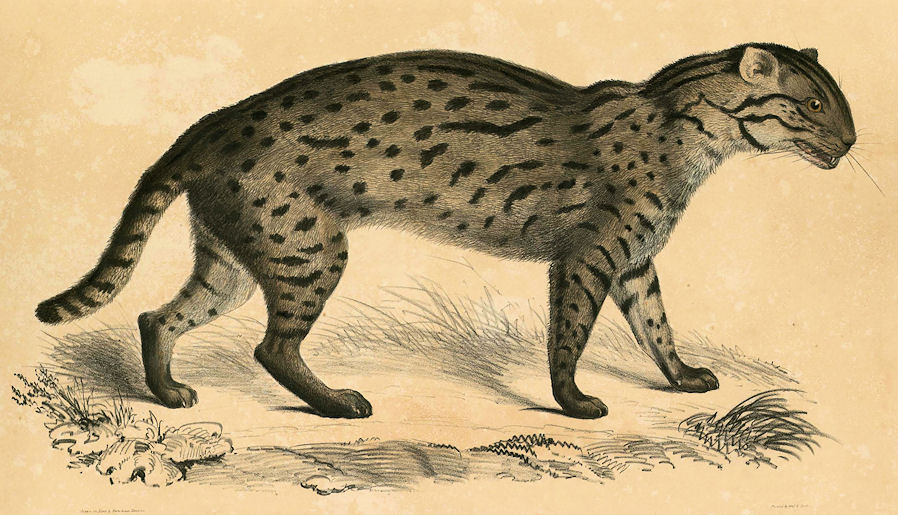
Abb.: Prionailurus viverrinus Bennett, 1833 -
Fischkatze - Fishing Cat
[Bildquelle: Hardwicke II, 1833. -- S. 16.]
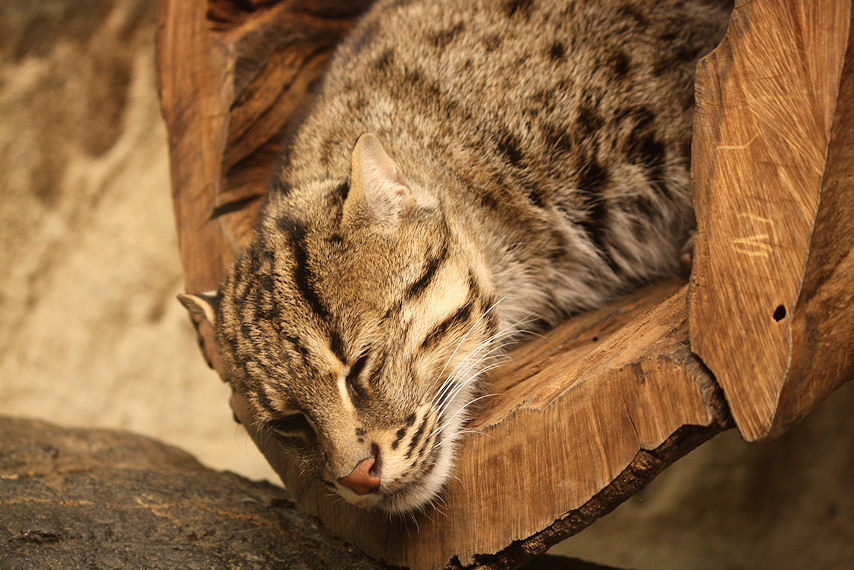
Abb.: Prionailurus viverrinus Bennett, 1833 -
Fischkatze - Fishing Cat, Zoo
[Bildquelle: Ltshears / Wikimedia. -- GNU FDLicense]
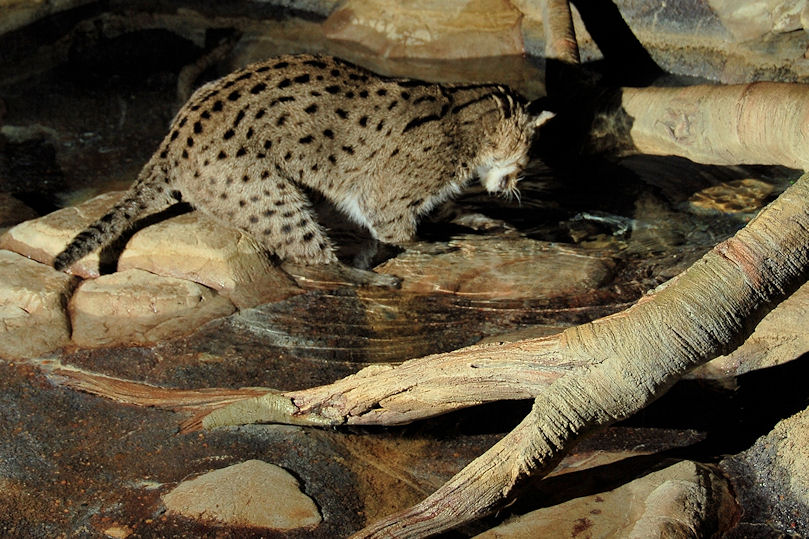
Abb.: Prionailurus viverrinus Bennett, 1833 -
Fischkatze - Fishing Cat, Zoo
[Bildquelle: Josh More. --
http://www.flickr.com/photos/guppiecat/3445115044/. -- Zugriff am
2010-12-15. --
Creative
Commons Lizenz (Namensnennung, keine kommerzielle Nutzung, keine
Bearbeitung)]
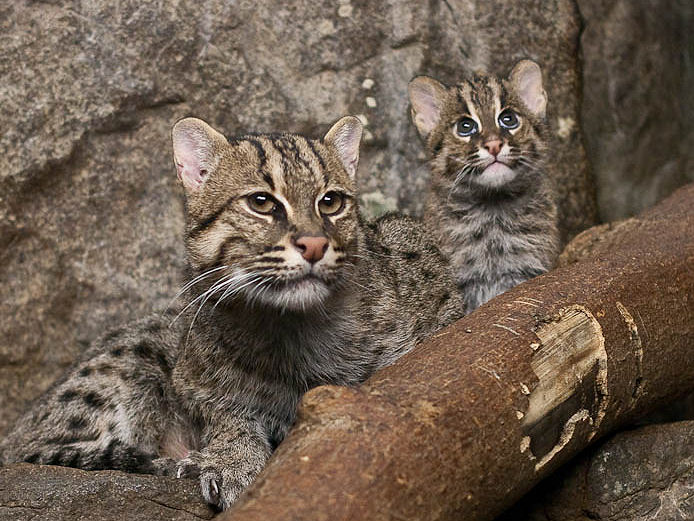
Abb.: Prionailurus viverrinus Bennett, 1833 -
Fischkatze - Fishing Cat, Zoo
[Bildquelle: Hubert K. --
http://www.flickr.com/photos/maunzy/3940029368/. -- Zugriff am 2010-12-15.
-- Creative
Commons Lizenz (Namensnennung, keine kommerzielle Nutzung, share alike)]
|
"This large tiger-cat is found throughout
Bengal up to the foot of the south-eastern Himalayas, extending into
Burmah, China, and Malayana. I have not heard of its occurrence in Central
India nor in the Carnatic, but is tolerably common in Travancore and Ceylon,
extending up the Malabar coast as far as Mangalore. I have had one
killed close to my house at Tellicherry. In Bengal it inhabits low watery
situations chiefly, and I have often put it up on the edge of swampy
thickets in Purneah. It is said to be common in the Terai and marshy
region at the foot of the Himalayas, but apparently not extending
further west than Nepal. Buchanan Hamilton remarks, "In the
neighbourhood of Calcutta it would seem to be common. It frequents reeds near
water ; and besides fish, preys upon Ampullariae, Unios, and various
birds. It is a fierce untameable creature, remarkably beautiful, but which has
a very disagreeable smell." On this Mr. Blyth observes, "I have not remarked the latter, though I have had several big toms quite tame, and
ever found this to be a particularly tameable species. A newly caught
male killed a tame young leopardess of mine about double his size."
The Rev. Mr. Baker, writing of its habits in Malabar, says "that it often kills pariah dogs ; and that he has known instances of slave children (infants)
being taken from their huts by this cat ; also young calves.""
[Quelle: Jerdon,
Thomas Claverhill <1811-1872>: The mammals of India : a natural history of
all the animals known to inhabit continental India. -- London, 1874. -- S.
103f.] |
Felis catus Linnaeus, 1758 - Hauskatze - Domestic Cat
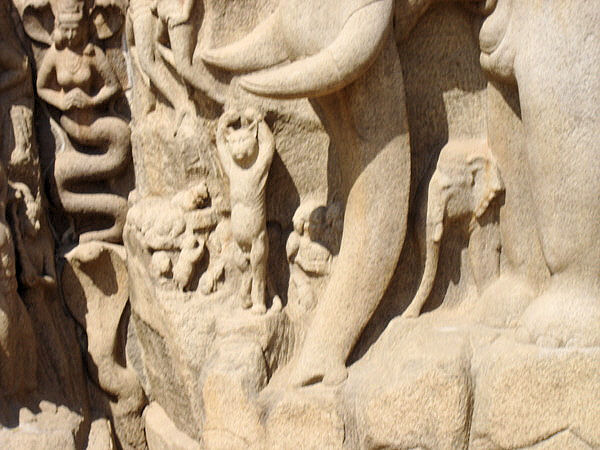
Abb.: Katze, Mahabalipuram - மகாபலிபுரம், Tamil Nadu
[Bildquelle:
jrambow. --
http://www.flickr.com/photos/rambow/381822844/. -- Zugriff am
2007-07-15. --


 Creative
Commons Lizenz (Namensnennung, keine kommerzielle Nutzung, keine
Bearbeitung)]
Creative
Commons Lizenz (Namensnennung, keine kommerzielle Nutzung, keine
Bearbeitung)]

Abb.: ओतुः ।
गुम्पिरिति नाम सम्स्कृतमार्जारः । Gumpi, DER Sanskritkater
[Bildquelle: A. Payer, 2009]

Abb.: मार्जारः
।
[Bildquelle: A. Payer, 2009]
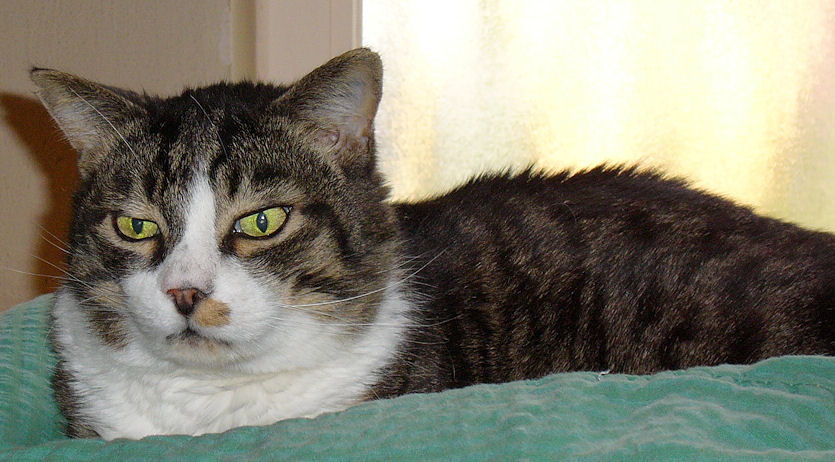
Abb.: वृषदंशकः
। Tüpfli-नाम पयराणामोतुः ।
[Bildquelle: A. Payer, 2004]
Siehe:
Carakasaṃhitā: Ausgewählte Texte aus der Carakasaṃhitā
/ übersetzt und erläutert von Alois Payer <1944 - >. -- Anhang B: Tierbeschreibungen. --
Felis catus. -- URL:
http://www.payer.de/ayurveda/tiere/felis_catus.htm
2.9.12. Varanus sp. - Warane - Monitor lizards
|
6.c./d. trayo gaudhera-gaudhāra-gaudheyā godhikātmaje
त्रयो गौधेर-गौधार-गौधेया गोधिकात्मजे ॥६ ख॥
Söhne der गोधिका - godhikā f.: Waran
heißen:
-
गौधेर -
gaudhera m.: Gaudhera
- गौधार
- gaudhāra m.: Gaudhāra
- गौधेय
- gaudheya m.: Gaudheya
|
Colebrooke (1807): "An iguana."
Iguanas gibt es aber nur in Zentralamerika, Südamerika und der Karibik!
PW: godhikā = "eine Art Eidechse. Lacerta
Godica." Lacerta Godica scheint seither nur in
Sanskritwörterbüchern ihr Unwesen zu treiben, scheint aber in der Natur
nicht vorzukommen.
In Indien kommen folgende Arten von Waranen vor:
- Varanus bengalensis Daudin,
1802 - Bengalenwaran - Bengal monitor / Common Indian monitor (ganzer
Subkontinent)
- Varanus salvator Laurenti, 1768 - Bindenwaran
- Water monitor (Orissa, Bengalen, Bangladesh, Assam, Meghalaya, Nagaland)
- Varanus griseus Daudin, 1803 - Wüstenwaran
- Desert Monitor (Trockengegenden Pakistans und Westindiens)
- Varanus flavescens Hardwicke & Gray, 1827 - Yellow Monitor
(Gangesebene, häufig in Bihar)
Varanus bengalensis Daudin,
1802 - Bengalenwaran - Bengal monitor / Common Indian monitor
Körperlänge: 175 cm (Schwanz 100 cm)
Gewicht: bis 7 kg
Lebensraum: weit auf dem ganzen Subkontinent und Sri Lanka
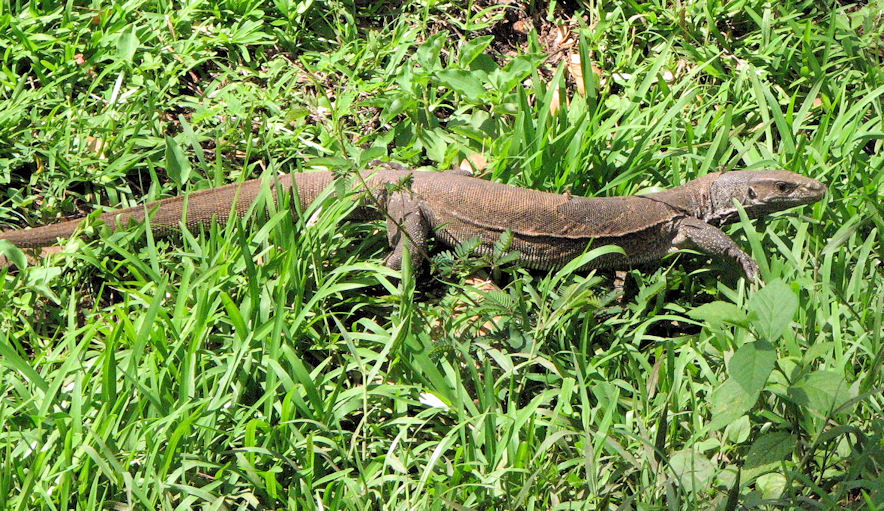
Abb.: गोधिका
।
Varanus bengalensis Daudin,
1802 - Bengalenwaran - Bengal monitor / Common Indian monitor, Kandy -
මහ නුවර, Sri Lanka
[Bildquelle: HanakoSatou (佐藤芭那) / Wikimedia. -- GNU FDLicense]
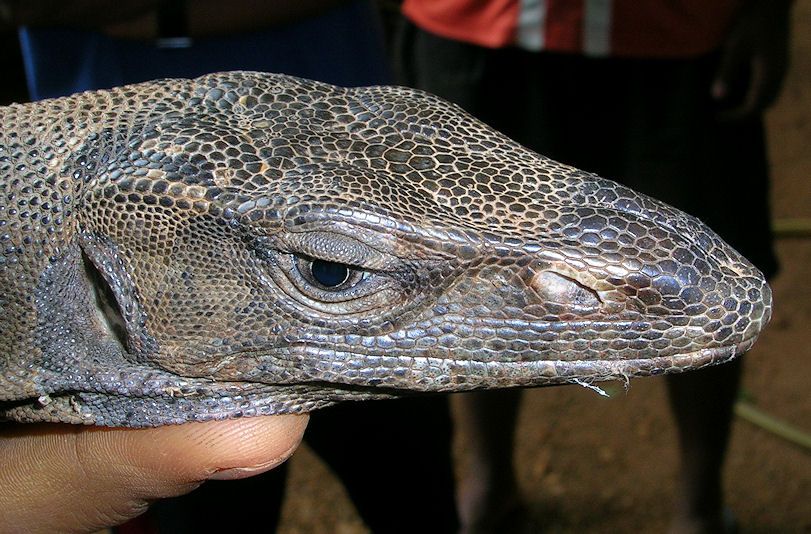
Abb.: Varanus bengalensis Daudin,
1802 - Bengalenwaran - Bengal monitorr / Common Indian monitor, Wyanad -
വയനാട്, Kerala
[Bildquelle: L. Shyamal / Wikipedia. --
Creative Commons
Lizenz (Namensnennung, share alike)]
Varanus salvator Laurenti, 1768 - Bindenwaran
- Water monitor
Körperlänge: bis über 3 m
Gewicht: bis 25 kg
Lebensräume: Nordostindien, Sri Lanka
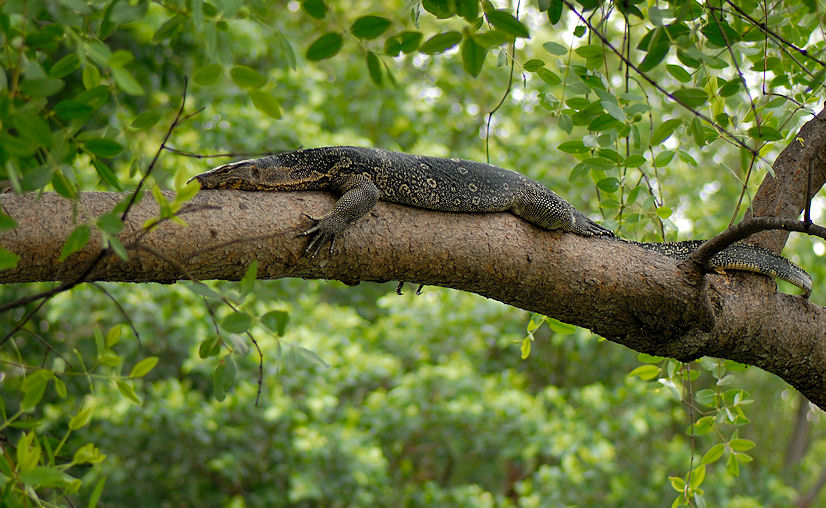
Abb.: Varanus salvator Laurenti, 1768 - Bindenwaran - Water monitor,
Bangkok - กรุงเทพฯ,
Thailand
[Bildquelle: Bing / Wikimedia. -- GNU FDLicense]
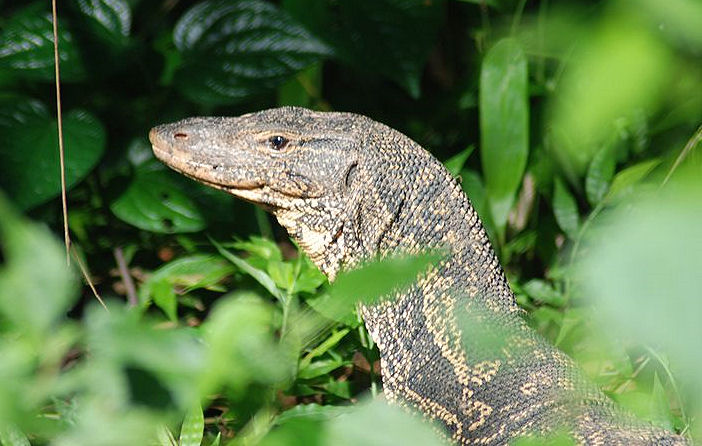
Abb.: Varanus salvator Laurenti, 1768 - Bindenwaran - Water monitor,
Khao Yai National Park - อุทยานแห่งชาติเขาใหญ,
Thailand
[Bildquelle: Chris huh / Wikimedia. -- GNU FDLicense]
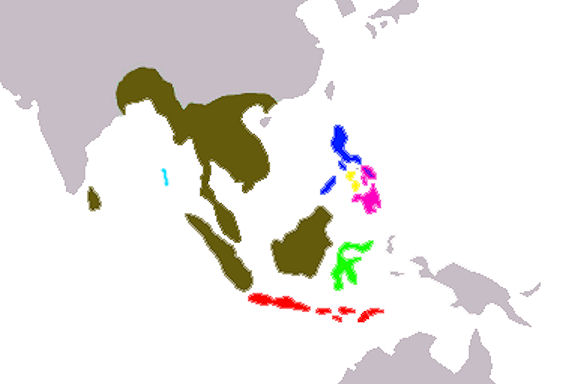
Abb.: Verbreitung des Bindenwarans (Varanus salvator Laurenti, 1768)
und seiner Unterarten
[Bildquelle: Kamikaza
Varanus griseus Daudin, 1803 - Wüstenwaran
- Desert Monitor
Körperlänge: bis 150 cm
Lebensraum: Trockengegenden Pakistans und Nordwestindiens
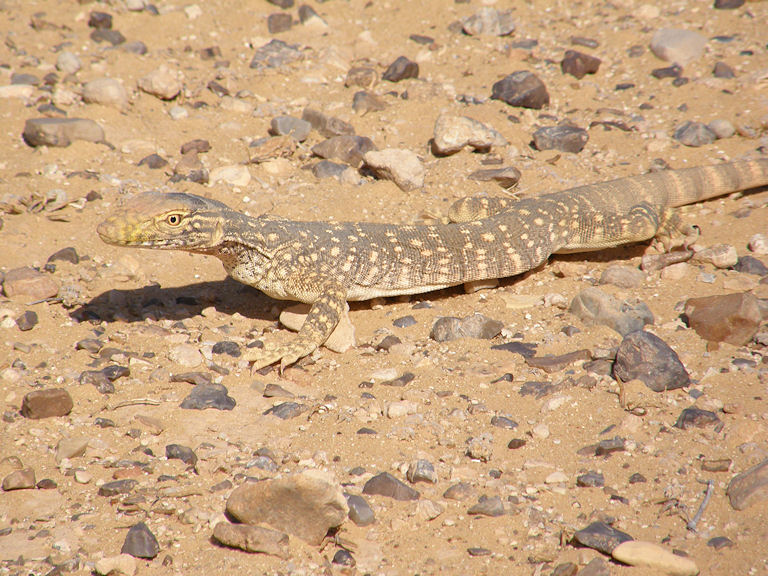
Varanus griseus Daudin, 1803 - Wüstenwaran - Desert Monitor,
Syrien
[Bildquelle: copepodo. --
http://www.flickr.com/photos/63661371@N00/2770760869. -- Zugriff am
2010-12-09. --
Creative Commons Lizenz (Namensnennung, keine kommerzielle Nutzung, keine
Bearbeitung)]
Varanus flavescens Hardwicke & Gray, 1827 - Yellow
Monitor
Lebensraum: Indusebene, Gangesebene, in Bihar häufig, Brahmaputraebene
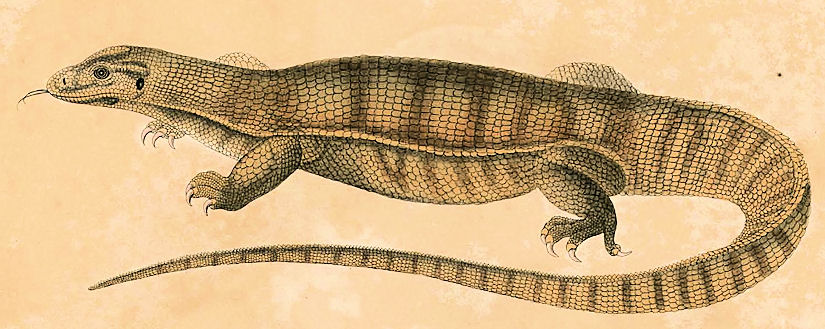
Abb.: Varanus flavescens Hardwicke & Gray, 1827 - Yellow Monitor
[Bildquelle: Hardwicke II, 1833. -- S. 174.]

Abb.: Varanus flavescens Hardwicke & Gray, 1827 - Yellow Monitor, Zoo
[Bildquelle: muzina-shanghai. --
http://www.flickr.com/photos/muzina_shanghai/584481425/. -- Zugriff am
2010-12-10. --
Creative Commons Lizenz (Namensnennung, keine kommerzielle Nutzung, keine
Bearbeitung)]
Siehe:
Carakasaṃhitā: Ausgewählte Texte aus der Carakasaṃhitā
/ übersetzt und erläutert von Alois Payer <1944 - >. -- Anhang B: Tierbeschreibungen. --
Varanus sp. -- URL:
http://www.payer.de/ayurveda/tiere/varanus.htm
| "Ein sonderbarer Irrtum deutscher Forscher hat einigen großen
Echsen, welche die erste Familie der Unterordnung bilden, zu dem
Namen Warn-Eidechsen verholfen. Die bekanntesten Arten der Familie
bewohnen Ägypten und werden dort Waran genannt; dieses Wort hat man
in Warner umgewandelt und dieselbe Bedeutung auch durch den
wissenschaftlichen Namen Monitor festgehalten: Waran und
Warner aber haben durchaus keine Beziehung zu einander; denn Waran
bedeutet einfach Eidechse. Die Warane oder Wassereidechsen (Varanidae)
unterscheiden sich von den übrigen Eidechsen, denen sie hinsichtlich
ihres langgestreckten Körpers, des breiten, ungekielten Rückens und
der vollständig ausgebildeten, vorn und hinten fünfzehigen, mit
kräftigen Nägeln bewehrten Füße ähneln, durch die Beschuppung, die
Bildung der Zunge und die Anlage und Gestaltung der Zähne. Ihr Kopf
ist verhältnismäßig länger als der anderer Eidechsen und dem der
Schlangen nicht ganz unähnlich; aber auch ihr Hals und der übrige
Leib, einschließlich des Schwanzes, übertrifft an Schlankheit die
bezüglichen Leibesteile der Verwandten. Die Zunge liegt im
zurückgezogenen Zustande gänzlich in einer Hautscheide verborgen,
kann aber sehr weit hervorgestreckt werden und zeigt dann zwei
lange, hornige Spitzen. Die Zähne, welche der Innenseite der
Kieferrinnen anliegen, stehen ziemlich weit von einander und sind
von kegelförmiger Gestalt, vorn spitzig, hinten stumpfkegelig;
Gaumenzähne sind nicht vorhanden. Die kleinen in der Fünfform oder
in Querreihen angeordneten Tafelschuppen vergrößern sich auf dem
Kopfe nicht zu wirklichen Schildern, und auch die der Bauchseite
weichen wenig von denen des Rückens ab.
Die Warane, von denen man ungefähr dreißig Arten kennt, bewohnen
die östliche Hälfte der Erde, namentlich Afrika, Südasien und
Ozeanien. Einige Arten sind vollendete Landtiere, welche eine
passende Höhlung zum Verstecke erwählen und in der Nähe derselben,
diese bei Tage, jene mehr in der Dämmerung oder selbst in der Nacht,
ihrer Jagd obliegen; andere hingegen müssen zu den Wassertieren
gezählt werden, da sie sich bloß in der Nähe der Gewässer, in
Sümpfen oder an Flussufern aufhalten und bei Gefahr stets so eilig
als möglich dem Wasser zuflüchten. Die einen wie die anderen sind
höchst bewegliche Tiere. Sie laufen mit stark schlängelnder
Bewegung, auf festem Boden so rasch dahin, dass sie kleine
Säugetiere oder selbst Vögel einzuholen im Stande sind, klettern
trotz ihrer Größe vortrefflich und schwimmen und tauchen, obgleich
sie keine Schwimmhäute besitzen, ebenso gewandt als ausdauernd. Zu
längerem Verweilen im Wasser befähigen sie zwei größere Hohlräume im
Inneren ihrer Oberschnauze, welche mit den Nasenlöchern in
Verbindung stehen, mit Luft gefüllt und durch die beweglichen Ränder
der Nasenlöcher abgeschlossen werden können. In ihrem Wesen und
Gebaren, ihren Sitten und Gewohnheiten erinnern die Warane an die
Eidechsen, nicht aber an die Krokodile; sie sind jedoch, ihrer Größe
und Stärke entsprechend, entschieden räuberischer, mutiger und
kampflustiger als die kleineren Verwandten. Vor den Menschen und
wohl auch vor anderen größeren Tieren weichen sie stets zurück, wenn
sie dies können, diejenigen, welche auf der Erde wohnen, indem sie
blitzschnell ihren Löchern, die, welche im Wasser leben, indem sie
ebenso eilfertig dem Wohngewässer zueilen; werden sie aber gestellt,
also von ihrem Zufluchtsorte abgeschnitten, so nehmen sie ohne
Bedenken den Kampf auf, schnellen sich mit Hülfe ihrer Füße und des
kräftigen Schwanzes hoch über den Boden empor und springen dem
Angreifer kühn nach Gesicht und Händen.
Ihre Nahrung besteht in Tieren der verschiedensten Art. Der
Nilwaran, ein bereits den alten Ägyptern wohlbekanntes, auf ihren
Denkmälern verewigtes Tier, galt früher als einer der gefährlichsten
Feinde des Krokodils, weil man annahm, dass er dessen Eier aufsuche
und zerstöre und die dem Eie entschlüpften jungen Krokodile verfolge
und verschlinge. Wie viel wahres an diesen Erzählungen ist, lässt
sich schwer entscheiden; wohl aber darf man glauben, dass ein Waran
wirklich ohne Umstände ein junges Krokodil verschlingt oder auch ein
Krokodilei hinabwürgt, falls er des einen und anderen habhaft werden
kann. Leschenault versichert, Zeuge gewesen zu sein, dass einige
indische Warane vereinigt ein Hirschkälbchen überfielen, es längere
Zeit verfolgten und schließlich im Wasser ertränkten, will auch
Schafknochen in dem Magen der von ihm erlegten gefunden haben; ich
meinesteils bezweifle entschieden, dass irgend eine Art der Familie
größere Tiere in der Absicht, sie zu verspeisen, angreift, bin aber
von Arabern und Afrikanern überhaupt wiederholt berichtet worden,
dass Vögel bis zur Größe eines Kiebitzes oder Säugetiere bis zur
Größe einer Ratte ihnen nicht selten zum Opfer fallen. Die auf
festem Boden lebenden Warane jagen nach Mäusen, kleinen Vögeln und
deren Eiern, kleineren Eidechsen, Schlangen, Fröschen, Kerbtieren
und Würmern; die wasserliebenden Mitglieder der Familie werden sich
wahrscheinlich hauptsächlich von Fischen ernähren, ein unvorsichtig
am Ufer hinlaufendes, schwaches Säugetier oder einen ungeschickten
Vogel, dessen sie sich bemächtigen können, aber gewiss auch nicht
verschmähen. Da, wo man sie nicht verfolgt, oder wo sie sich leicht
zu verbergen wissen, werden sie wegen ihrer Räubereien an jungen
Hühnern und Hühnereiern allgemein gefürchtet und gehasst, und dies
sicherlich nicht ohne Grund und Ursache.
An gefangenen Waranen kann man leicht beobachten, dass sie
tüchtige Räuber sind. Obwohl sie auch tote Tiere nicht verschmähen,
ziehen sie doch lebende Beute jenen entschieden vor. Ihr Gebaren
ändert sich vollständig, wenn man ihnen ein Dutzend lebende
Eidechsen oder Frösche in den Käfig wirft. Die träge Ruhe, in
welcher auch sie gerne sich gefallen, weicht der gespanntesten
Aufmerksamkeit: die kleinen Augen leuchten, und die lange Zunge
erscheint und verschwindet in ununterbrochenem Wechsel. Endlich
setzen sie sich in Bewegung, um sich eines der unglücklichen Opfer
zu bemächtigen. Die Eidechsen rennen, klettern, springen
verzweiflungsvoll im Raume hin und her oder auf und nieder; die
Frösche hüpfen angstvoll durcheinander: der sie in Todesschrecken
versetzende Feind schreitet langsam und bedächtig hinter ihnen
drein. Aber Augen und Zunge verraten, dass er nur des Augenblickes
wartet, um zuzugreifen. Urplötzlich schnellt der gestreckte Kopf
vor; mit fast unfehlbarer Sicherheit ist ein Frosch, selbst die
behendeste Eidechse gepackt, durch einen quetschenden Biss betäubt
und verschlungen. So ergeht es einem Opfer nach dem anderen, bis
alle verzehrt sind, und sollten es Dutzende von Eidechsen oder
Fröschen gewesen sein. Legt man dem Warane ein oder mehrere Eier in
den Käfig, so nähert er sich gemächlich, betastet züngelnd ein Ei,
packt es sanft mit den Kiefern, erhebt den Kopf, zerdrückt das Ei
und schlürft behaglich den Inhalt hinab, leckt auch etwa ihm am
Maule herabfließendes Eiweiß oder den Dotter sorgfältig mit der
geschmeidigen, die ganze Schnauze und einen Teil des Kopfes
beherrschenden Zunge auf. Genau ebenso wird er auch in der Freiheit
verfahren.
Mehr als sonderbar ist, dass wir über die
Fortpflanzungsgeschichte der Warane noch immer nicht genügend
unterrichtet sind. Hätte ich während meines Aufenthaltes in Afrika
diese Lücke in ihrer Naturgeschichte gekannt, so würde ich mich
ihrer Beobachtung eifriger gewidmet haben, als es geschehen; doch
will ich damit keineswegs gesagt haben, dass ich sicheres erfahren
haben würde, weil mir die Araber und Sudaner, welche sonst
unaufgefordert über jedes Tier Auskunft geben, so viel ich mich
erinnere, über die Fortpflanzung dieser Echsen niemals etwas erzählt
haben. So viel mir bekannt, gibt nur Theobald über eine indische Art
der Familie, den Gilbwaran (Varanus flavescens), kurzen
Bericht. »Die Warane«, bemerkt er, »legen ihre Eier in die Erde.
Zuweilen benutzen sie das Nest weißer Ameisen. Die gegen fünf
Zentimeter langen Eier sind walzenförmig, an beiden Enden abgerundet
und schmutzig weiß von Farbe, haben aber immer ein unreines und
widriges Ansehen.« Jedes Weibchen scheint gleichzeitig eine ziemlich
erhebliche Anzahl von ihnen zu legen. Während der Reise des seinem
Forschungsdrange zum Opfer gefallenen, hochachtbaren Klaus von der
Decken wurde eines Tages ein meterlanger Waran mit einem
Schrotschusse getötet und beim Zerlegen gefunden, dass er mit
vierundzwanzig Eiern trächtig ging.
Für den Menschen haben die Warane eine nicht zu unterschätzende
Bedeutung. Durch ihre Räubereien an Haustieren und Eiern werden sie
lästig; andererseits nützen sie auch wieder durch ihr vortreffliches
Fleisch und ihre eigenen, höchst schmackhaften Eier. In vielen
Ländern ihres ausgedehnten Verbreitungsgebietes betrachtet man
allerdings Fleisch und Eier mit Abscheu, in anderen dagegen schätzt
man diese wie jenes nach Gebühr, verfolgt die Warane deshalb auch
auf das eifrigste, und zwar gewöhnlich mit Hülfe von Hunden, welche
sie im Walde aufsuchen und verbellen. Laut Theobald wird ein
Birmane, so träge er sonst ist, es nicht für eine allzu große Mühe
erachten, einen Baum, in welchem sich ein Waran verborgen hat, zu
fällen, um nur des von ihm hochgeschätzten Leckerbissens habhaft zu
werden. Der gefangenen Wasserechse bindet man die vier Füße über den
Rücken und benutzt hierzu grausamerweise die Sehnen der vorher
gebrochenen Zehen des beklagenswerten Geschöpfes. Waraneier verkauft
man auf den Märkten Birmas teuerer als Hühnereier; sie gelten auch
mit vollstem Rechte als Leckerbissen, sind jedes ekelerregenden
Geruches bar, haben einen wahrhaft köstlichen Wohlgeschmack und
unterscheiden sich nur dadurch von Vogeleiern, dass ihr Weiß beim
Kochen nicht gerinnt. Das Fleisch genießen die Inder im gebratenen
Zustande, wogegen es die Europäer meist zur Herstellung von Suppen
verwenden. Kelaart, welcher solche versuchte, bezeichnet sie als
ausgezeichnet, im Geschmacke einer Hasensuppe ähnlich. Anderweitige
Verwendung findet die schuppige Haut, mit welcher hier und da,
beispielsweise in Nordostafrika, allerlei Gerät überzogen wird. Auch
benutzt man wohl noch diese oder jene Art zu Gaukeleien oder lässt
sie bei Herstellung von Giften eine geheimkrämerische Rolle spielen.
An gefangenen Waranen erlebt man wenig Freude. Anfänglich
betragen sich die ihrer Freiheit beraubten Tiere äußerst ungestüm,
zischen und fauchen nach Schlangenart, sobald man sich ihnen nähert,
oder beißen wütend um sich, sowie sie glauben, den Pfleger erreichen
zu können. Nach und nach werden sie etwas umgänglicher, wirklich
zahm aber selten oder nie, bleiben vielmehr stets bissig und
gefährlich, da man die Kraft ihrer zahnreichen Kinnladen durchaus
nicht unterschätzen darf. Man kann sie nur in größeren Räumen
halten; aber auch hier werden sie wegen ihres sinnlosen Umherrennens
und Kletterns sowie wegen ihrer Gefräßigkeit und Unreinlichkeit
früher oder später lästig.
Man hat auch die Familie der Warane in mehrere Unterabteilungen
gefällt; doch ist diesen kaum die Bedeutung von Sippen beizulegen,
da sich die hervorgehobenen Unterschiede auf geringfügige
Eigenheiten beschränken. Ich halte es für unnötig, hierauf
einzugehen.
[...]
Auf dem Festlande von Indien und den benachbarten großen Eilanden
wird der Waran durch den Binden- oder Wasserwaran, Kabaragoya der
Singhalesen (Varanus salvator, Stellio und
Hydrosaurus salvator, Tupinambis, Varanus, Monitor und
Hydrosaurus bivittatus), vertreten, ein Tier, welches sich durch
den seitlich sehr stark zusammengedrückten Schwanz, die langen
Zehen, die an der Spitze der Schnauze stehenden Nasenlöcher und die
kleinen Schuppen von jenen unterscheidet und deshalb der Untersippe
der Wasserechsen (Hydrosaurus) zugerechnet wird. Die
Oberseite zeigt auf schwarzem Grunde in Reihen geordnete gelbe
Flecken; ein schwarzes Band verläuft längs der Weichen und eine
weiße Binde längs des Halses; die Unterseite ist weißlich.
Ausgewachsene Stücke erreichen ebenfalls zwei Meter an Länge.
Obwohl hauptsächlich auf den Malaiischen Inseln, insbesondere den
Sunda-Eilanden, den Philippinen und Molukken heimisch, kommt der
Bindenwaran doch auch auf dem ostindischen Festlande nebst Ceylon
sowie in Siam und China vor. Auf der Halbinsel von Malakka lernte
ihn Cantor als sehr häufigen Bewohner des hügeligen wie des ebenen
Landes kennen. Während des Tages sieht man ihn gewöhnlich im
Gezweige größerer Bäume, welche Flüsse und Bäche überschatten, auf
Vögel und kleinere Eidechsen lauern oder Nester plündern, gestört
aber sofort, oft aus sehr bedeutender Höhe, ins Wasser hinabspringen.
Unter ihm günstig erscheinenden Umständen siedelt er sich auch in
nächster Nähe menschlicher Wohnungen oder in diesen selbst an und
wird dann zu einem dreisten Räuber auf den Geflügelhöfen. So erfuhr
Eduard von Martens von einem europäischen Pflanzer in der Gegend von
Manila, dass ein »Krokodil« unter seinem Hause lebe und bei Nacht
hervorkomme, um Hühner zu rauben. Dass dieses »Krokodil« nur unser
Waran sein konnte, unterlag für Martens keinem Zweifel. So
unternehmend der Bindenwaran bei seinen Räubereien sich zeigt, so
ungescheut er in unmittelbarer Nachbarschaft des Menschen stiehlt
und plündert, so ängstlich sucht er jederzeit den Verfolgungen
seitens des Herrn der Erde sich zu entziehen. Wenn man ihn auf
ebenem Boden überrascht, eilt er, laut Cantor, so schnell er zu
laufen vermag, davon und womöglich ebenfalls dem Wasser zu; seine
Schnelligkeit ist jedoch nicht so bedeutend, dass er nicht von einem
gewandten Manne überholt werden sollte. Ergriffen, wehrt er sich auf
das mutigste mit Zähnen und Klauen, versetzt auch mit seinem
Schwanze kräftige Schläge.
Die Mitglieder tiefer stehender Kasten bemächtigen sich des
Wasserwaran gewöhnlich durch Aufgraben seiner Höhlen und genießen
dann das Fleisch der glücklich gewonnenen Beute mit Wohlgefallen.
Eine in den Augen der Hindus viel bedeutsamere Rolle aber spielt der
Kabaragoya bei Bereitung der tödlichen Gifte, welche die Singhalesen
noch heutigentags nur zu häufig verwenden. Nach einer Angabe, welche
Tennent gemacht wurde, verwendet man zur »Kabaratel«, der
gefürchtetsten aller Giftmischungen, Schlangen, namentlich die
Hutschlange oder Kobra de Capello (Naja tripudians), die
Tikpolonga (Vipera elegans) und die Carawilla (Trigonocephalus
hypnalis), indem man Einschnitte in ihre Köpfe macht und sie
dann über einem Gefäße aufhängt, im Glauben, das ausfließende Gift
auffangen zu können. Das so gewonnene Blut wird mit Arsenik und
anderen Kraftmitteln vermischt und das ganze mit Hülfe von
Kabaragoyas in einem Menschenschädel gekocht. Unsere Warane müssen
die Rolle der Tiere in Fausts Hexenküche übernehmen. Sie werden von
drei Seiten gegen das Feuer gesetzt, mit ihren Köpfen demselben
zugerichtet, festgebunden und mit Schlägen so lange gequält, bis sie
zischen, also gleichsam das Feuer anblasen. Aller Speichel, welchen
sie bei der Quälerei verlieren, wird sorgsam gesammelt und dem
kochenden Gebräue beigesetzt. Letzteres ist fertig, sobald sich eine
ölige Masse auf der Oberfläche zeigt. Es versteht sich ganz von
selbst, dass der Arsenik der eigentlich wirksame Bestandteil dieses
Giftes ist; die unschuldige Kabaragoya hat sich aber infolge dieses
Schwindels der Giftmischer einen so üblen Ruf erworben, dass man sie
gegenwärtig allgemein und in wahrhaft lächerlichem Grade fürchtet.
Nach Art des Waran hält sie sich auch auf Ceylon vorzugsweise in der
Nähe des Wassers auf und flüchtet diesem zu, sobald sie Gefahr
wittert; beim Austrocknen der Wohngewässer aber sieht sie sich
zuweilen genötigt, Wanderungen über Land zu unternehmen, und bei
dieser Gelegenheit geschieht es auch wohl, dass sie sich in der Nähe
eines Wohnhauses der Singhalesen erblicken lässt oder sogar durch
das Gehöfte läuft. Ein solcher Vorfall gilt als ein schlimmes
Vorzeichen; man fürchtet nun Krankheit, Tod und anderes Unglück und
sucht bei den indischen Pfaffen Schutz, um die üblen Folgen
womöglich zu vereiteln. Diese erscheinen, nachdem der wackere
Gläubige sich zu ihren Gunsten etwas von dem gleisnerischen Mammon
dieser Erde erleichtert, in der durch die Kabaragoya verunreinigten
Hütte und beginnen einen Gesang, welcher der Hauptsache nach in den
Worten:
»Kabara goyin wan dōsey,
Ada palayan e dōsey«
besteht und besagen will, dass nunmehr alles Übel, welches die
Kabaragoya verursacht habe, unschädlich gemacht sei.
Schon Herodot berichtet von einem »Landkrokodile«, welches im
Gebiete der libyschen Wanderhirten lebt und den Eidechsen ähnlich
sieht; Prosper Alpin hält dasselbe Tier für den »Scincus«
der Alten, von welchem man annahm, dass er sich von gewürzreichen
Pflanzen nähre, insbesondere den Wermut liebe und dadurch stärkende
Heilkräfte erhalte, während wir gegenwärtig mit demselben Namen eine
andere Schuppenechse bezeichnen. Gedachtes Landkrokodil ist der Erd-
oder Wüstenwaran (Varanus arenarius, Tupinambis arenarius
und griseus, Varanus scincus und terrestris,
Monitor scincus, Psammosaurus scincus und griseus),
Vertreter der Untersippe der Sandechsen (Psammosaurus), ein
Waran, welcher sich von den bisher genannten hauptsächlich durch
seinen runden, ungekielten Schwanz, die rundlichen, nicht eiförmigen
Schuppen und die kleinen, breiten Schneidezähne unterscheidet, etwas
über 1,5 Meter lang wird, oben auf hellbraunem Grunde mit
grünlichgelben, viereckigen Flecken gezeichnet, auf der Unterseite
einfach sandgelb gefärbt ist und auf seinem Schwanze mehrere
gelbliche Ringe zeigt."
[Quelle: Brehms Thierleben : Allgemeine Kunde des
Thierreichs. -- 7. Bd., 3. Abt.: Kriechthiere, Lurche und
Fische. -- 1. Bd.: Kriechthiere und Lurche. -- 2.,
umgearbeitete und vermehrte Aufl., Kolorirte Ausgabe. -- Leipzig,
1883. -- S. 149ff.] |
2.9.13. Stachelschweine
|
7. a./b. śvāvit tu śalyas tal-lomni śalalī śalalaṃ śalam
श्वावित् तु शल्यस् तल्लोम्नि शलली शललं शलम् ।७ क।
[Bezeichnungen für Stachelschwein:]
-
श्वाविध्
- śvāvidh m.: Hunde-Durchbohrer
- शल्य -
śalya m.: Stachliger, Stachelschwein
Seine Borste nennt man:
-
शलली - śalalī f.:
Stachelschwein-Borste
- शलल - śalala
n.: Stachelschwein-Borste
- शल - śala n.:
Stock, Stachelschwein-Borste
|
Colebrooke (1807): "A porcupine." [b:] "His quills."
In Indien kommen vor:
- Hystrix brachyura Linnaeus, 1758 - Malayan Porcupine (von Nepal
bis Südostchina)
- Hystrix indica Kerr, 1792 - Indisches Stachelschwein - Indian
Crested Porcupine (Indien, Sri Lanka)
- Atherurus macrourus Linnaeus, 1758 - Asiatic Brush-tailed
Porcupine (Nordostindien)
Hystrix brachyura Linnaeus, 1758 - Malayan Porcupine
Körperlänge: 45 - 75 cm
Gewicht: 8 kg
Lebensraum: Wälder und Grasland des östlichen Himalaya, besonders in und bei
landwirtschaftlich genutztem Land
Noch in Freiheit lebende Individuen: unbekannt
Lebt als Einzelgänger oder in Gruppen von 2 - 4 Tieren
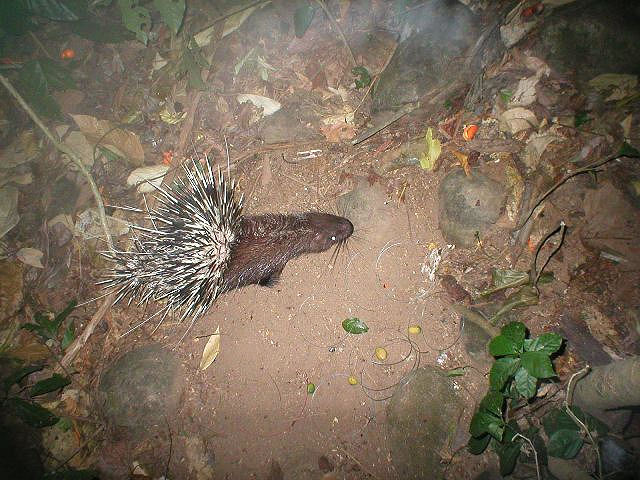
Abb.: शल्यः ।
Hystrix brachyura Linnaeus, 1758 - Malayan Porcupine, Pakhui Tiger
Reserve, Arunachal Pradesh
[Bildquelle: Nandini Velho / Wikipedia. --
Creative Commons
Lizenz (Namensnennung, share alike)]
Hystrix indica Kerr, 1792 - Indisches Stachelschwein - Indian Crested Porcupine
Häufigstes Stachelschwein Indiens
Körperlänge: 60 - 90 cm
Gewicht: 11 - 18 kg
Lebensraum: ganz Indien, Sri Lanka; zerstört Anpflanzungen in der Nähe von
Waldrändern, frisst Rinde von lebenden Bäumen
Noch in Freiheit lebende Individuen: unbekannt
Lebt als Einzelgänger oder in Gruppen von 2 - 4 Tieren
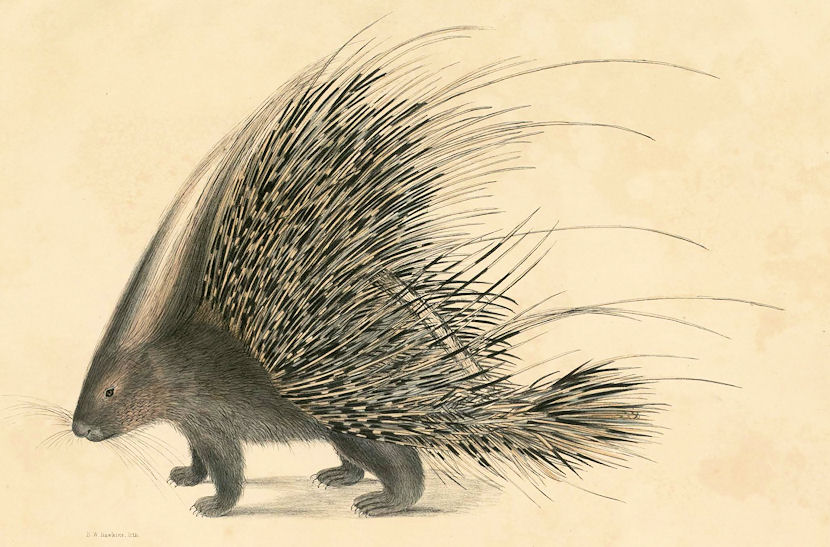
Abb.: शल्यः ।
Hystrix indica Kerr, 1792 - Indisches Stachelschwein - Indian
Crested Porcupine
[Bildquelle: Hardwicke II, 1833. -- S. 36.]

Abb.: शल्यः ।
Hystrix indica Kerr, 1792 - Indisches Stachelschwein - Indian
Crested Porcupine, Zoo
[Bildquelle: Bodlina / Wikimedia. -- GNU FDLicense]
|
"This porcupine is found over a great part of
India, from the lower ranges of the Himalayas to the extreme south,
but does not occur in Lower Bengal, where it is replaced by the
next one. It forms extensive burrows, often in societies, in the sides of
hills, banks of rivers and nullahs, and very often in the bunds of tanks,
and in old mud walls, &c. &c. In some parts of the country they are
very destructive to various crops, potatoes, carrots, and other
vegetables. They never issue forth till after dark, but now and then one
will be found returning to his lair in daylight. Dogs take up the
scent of the porcupine very keenly, and on the Neelgherries I have killed
many by the aid of dogs, tracking them to their dens. They
charge backwards at their foes, erecting their spines at the same time,
and dogs generally get seriously injured by their strong spines,
which are sometimes driven deeply into the assailant. The porcupine is
not bad eating, the meat, which is white, tasting something between
pork and veal.
This species is common in Ceylon, whence Mr.
Blyth formerly named a young specimen as distinct. It occurs also
in Afghanistan, and probably in other parts of Asia."
[Quelle: Jerdon,
Thomas Claverhill <1811-1872>: The mammals of India : a natural history of
all the animals known to inhabit continental India. -- London, 1874. -- S.
219f.] |
Atherurus macrourus Linnaeus, 1758 - Asiatic Brush-tailed
Porcupine
Körperlänge: 36 - 57 cm
Gewicht: 1,5 - 4 kg
Lebensraum: Immergrüne Wälder Nordostindiens, besonders im Hügelland
Noch in Freiheit lebende Individuen: unbekannt
Lebt in Gruppen von 6 - 8
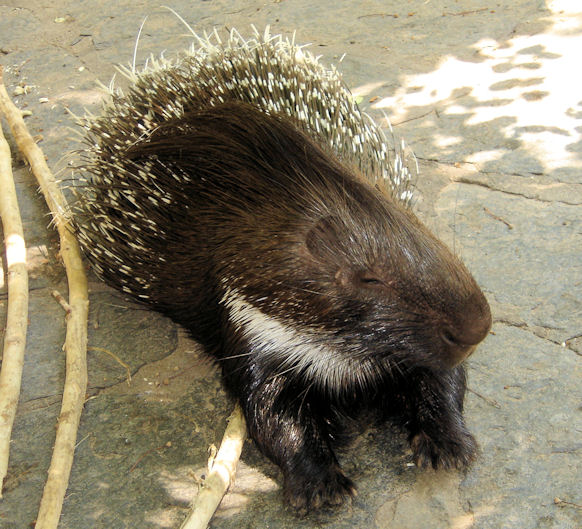
Abb.: Atherurus africanus, der afrikanische Verwandte von Atherurus
macrourus Linnaeus, 1758 - Asiatic Brush-tailed Porcupine, Zoo
[Bildquelle: Eloquence / Wikimedia. -- Public domain]
2.9.13.1. Stachelschweinborsten
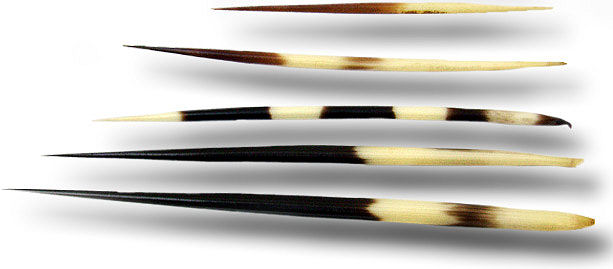
Abb.: शललानि ।
Stachelschweinborsten
[Bildquelle: Lamiot / Wikimedia. -- Public domain]
Siehe:
Carakasaṃhitā: Ausgewählte Texte aus der Carakasaṃhitā
/ übersetzt und erläutert von Alois Payer <1944 - >. -- Anhang B: Tierbeschreibungen. --
Hystrix
indica. -- URL:
http://www.payer.de/ayurveda/tiere/hystrix_indica.htm
2.9.14. Eine schnelle Antilopenart
| 7. c./d. vātapramīr vātamṛgaḥ
kokas tv īhāmṛgo vṛkaḥ
वातप्रमीर् वातमृगः कोकस् त्व्
ईहामृगो वृकः ॥७ ख॥
[Bezeichnungen für eine schnelle Antilopenart:]
- वातप्रमी - vātapramī m.: den Wind
hinter sich Lassender
- वातमृग - vātamṛga m.: Wind-Wild
|
Colebrooke (1807): "A swift antelope."
Zu den in Indien vorkommenden Antilopenarten siehe unten!
2.9.15. Canis lupus pallipes Sykes, 1831 -
Indischer Wolf - Indian Wolf
| 7. c./d. vātapramīr vātamṛgaḥ
kokas tv īhāmṛgo vṛkaḥ
वातप्रमीर् वातमृगः कोकस् त्व् ईहामृगो वृकः ॥७ ख॥
[Bezeichnungen für
Canis lupus pallipes Sykes, 1831 -
Indischer Wolf - Indian Wolf:]
- कोक - koka m.: Wolf
- ईहामृगो - īhamṛga m.: der, für den
Wild sein Begehren ist (so ist das Bahuvrīhi wohl aufzulösen)
- वृक - vṛka m.: Wolf
|
Colebrooke (1807): "A wolf."
Körperlänge: 100 - 130 cm
Gewicht: 15 - 20 kg
Lebensraum: Westindien, Subkontinent, Ladakh bis Sikkim
Noch in Freiheit lebende Individuen: 2000 - 3000
Lebt in Rudeln
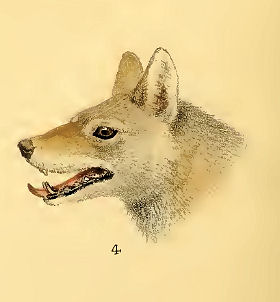
Abb.: वृकः ।
Canis lupus pallipes Sykes, 1831 -
Indischer Wolf - Indian Wolf
[Bildquelle: Lydekker, Richard <1849 - 1915>: The great and small
game of India, Burma, & Tibet. -- London, 1900. -- Pl. 9]
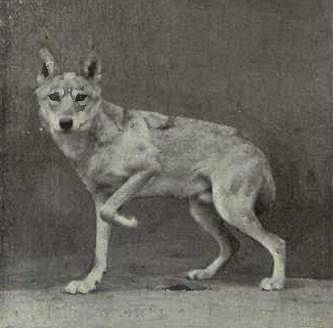
Abb.: कोकः ।
Canis lupus pallipes Sykes, 1831 -
Indischer Wolf - Indian Wolf
[Bildquelle: The living animals of the world, 1902]
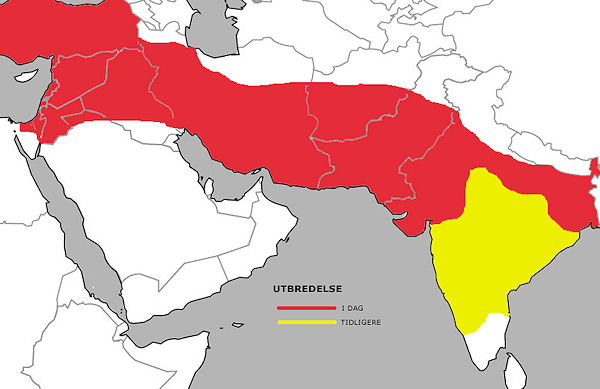
Abb.: Früherer und heutiger (rot) Lebensraum von Canis lupus pallipes Sykes, 1831
- Indischer Wolf - Indian Wolf
[Bildquelel: no.wikipedia. -- Public domain]
Siehe:
Carakasaṃhitā: Ausgewählte Texte aus der Carakasaṃhitā
/ übersetzt und erläutert von Alois Payer <1944 - >. -- Anhang B: Tierbeschreibungen. --
Canis lupus pallipes. -- URL:
http://www.payer.de/ayurveda/tiere/canis_lupus_pallipes.htm
|
"This wolf is found throughout the whole of
India, rare in wooded districts, and most abundant in open country.
"The wolves of the Southern Mahratta country," says Mr. Elliot, "generally hunt in packs, and I have seen them in full chase after the
goat antelope (Gazella Bennettii). They likewise steal round a herd
of antelope, and conceal themselves on different sides till an
opportunity offers of seizing one of them unawares, as they approach, whilst
grazing, to one or other of their hidden assailants. On one occasion three
wolves were seen to. chase a herd of gazelles across a ravine in which two
others were lying in wait. They succeeded in seizing a female gazelle,
which was taken from them. They have frequently been seen to course and
run down hares and foxes, and it is a common belief of the Ryots that
in the open plains, where there is no cover or concealment, they scrape
a hole in the earth in which one of the pack lies down, and remains
hid, while the others drive the herd of antelope over him. Their
chief prey, however, is sheep, and the shepherds say that part of the
pack attack and keep the dogs in play, while others carry off their
prey, and that if pursued they follow the same plan, part turning and
checking the dogs, whilst the rest drag away the carcass till they evade
pursuit. Instances are not uncommon of their attacking man. In 1824, upwards of
30 children were devoured by wolves in one pergunnah alone.
Sometimes a large wolf is seen to seek his prey singly. These are
called Won-tola, by the Canarese, and reckoned particularly fierce."
I have found wolves most abundant in the
Deccan and in Central India. I have often chased them for several miles,
they keeping 50 to 100 yards ahead of the horse, and the only kind of
ground on which a horse appeared to gain on them was heavy ploughed land. I
have known wolves turn on dogs that were running at their heels and
pursue them smartly till close up to my horse. A wolf once joined with my
greyhounds in pursuit of a fox, which was luckily killed almost
immediately afterwards, or the wolf might have seized one of the dogs instead of
the fox. He sat down on his haunches about 60 yards off whilst the
dogs were worrying the fox, looking on with great apparent interest, and
was with difficulty driven away. In many parts of the North-west of
India, they are very destructive to children, as about Agra, in Oude,
Rohilcund, and Rajpootana, and rewards are given by Government for their
destruction. Wolves breed in holes in the ground, or caves, having only
three or four young, it is said. The female has ten teats. They are
usually rather silent, but sometimes bark just like a pariah dog. The
howling after their prey, recorded of the European wolf, is seldom heard in India."
[Quelle: Jerdon,
Thomas Claverhill <1811-1872>: The mammals of India : a natural history of
all the animals known to inhabit continental India. -- London, 1874. -- S.
140f.] |
2.9.16. Antilopen und Gazellen
|
8. a./b mṛge kuraṅga-vātāyu-hariṇājinayonayaḥ
मृगे कुरङ्ग-वातायु-हरिणाजिनयोनयः ।८ क।
Bezeichnungen für मृग - mṛga m.: Wild, Hirsch,
Antilope, Gazelle, Moschustier:
- कुरङ्ग - kuraṅga m.: Kuraṅga,
eine Antilopenart oder Antilope überhaupt
- वातायु - vātāyu m.: lebendig wie
der Wind
- हरिण - hariṇa m.: Gelblicher,
Fahler1
- अजिनयोनि m.: Ursprung für Fell,
woraus man Fell bereitet, Fell-Lieferant
|
Colebrooke (1807): "A deer or antelope."
1 hariṇa ist im Besonderen: Antilope cervicapra Linnaeus, 1758 - Hirschziegenantilope
- Blackbuck (s. unten)
In Indien kommen folgende Antilopen- und Gazellenarten vor:
- Boselaphus sp.
- Boselaphus tragocamelus Pallas, 1766 - Nilgauantilope - Nilgai
- Antilope sp. - Blackbuck
- Antilope cervicapra Linnaeus, 1758 - Hirschziegenantilope -
Blackbuck (ganzer Subkontinent)
- Tetracerus sp.
- Tetracerus quadricornis de Blainville, 1816 -
Vierhornantilope - Four-horned Antelope (ganzer Subkontinent)
- Gazella sp. - Gazellen - Gazelles
- Gazella bennettii Sykes, 1831 - Indische Gazelle -
Indian Gazelle (Chinkara) (Pakistan, Nordindien)
- Procapra sp. - Central Asian Gazelles
- Procapra picticaudata Hodgson, 1846 - Tibetgazelle - Tibetan Gazelle
(Gowa)
(Himalayagebiet)
- Pantholops sp.
- Pantholops hodgsonii Abel, 1826 - Tschiru - Chiru (Tibetan Antelope) (Hochland Kashmirs)
हरिण - hariṇa m.: Antilope cervicapra Linnaeus, 1758 - Hirschziegenantilope
- Blackbuck
Kommt nur auf dem Subkontinent vor.
Schulterhöhe: 73 - 83 cm
Gewicht: 32 - 42 kg
Lebensraum: ganz Indien südlich des Terrai (außer Wüsten, Westküste und
Nordosten)
Noch in Freiheit lebende Individuen: ca. 50.000
Lebt in Herden von 10 bis über 50
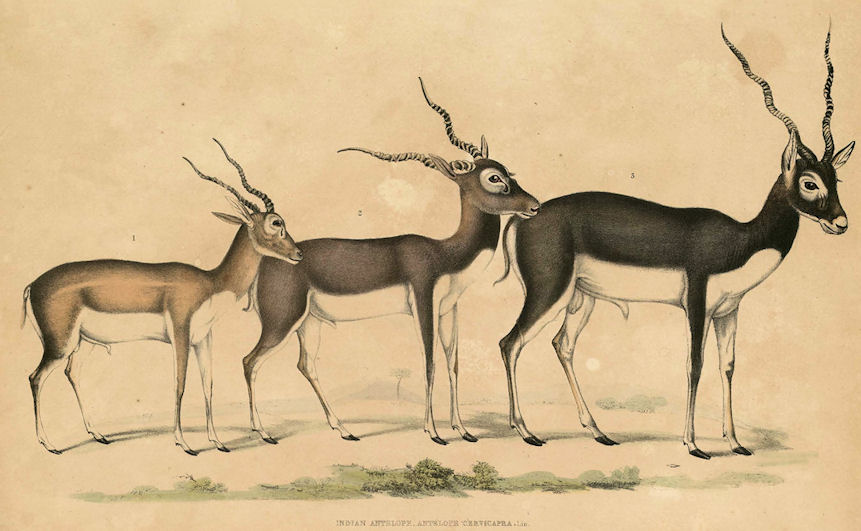
Abb.:
हरिणाः ।
Antilope cervicapra Linnaeus, 1758 - Hirschziegenantilope - Blackbuck
[Bildquelle: Hardwicke I, 1830. -- S. 36.]
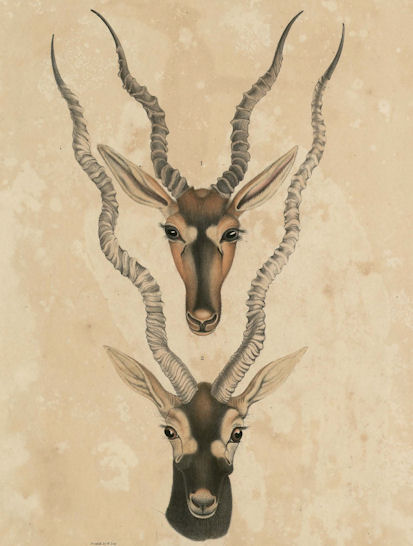
Abb.:
हरिणौ ।
Antilope cervicapra Linnaeus, 1758 - Hirschziegenantilope - Blackbuck
[Bildquelle: Hardwicke I, 1830. -- S. 38.]
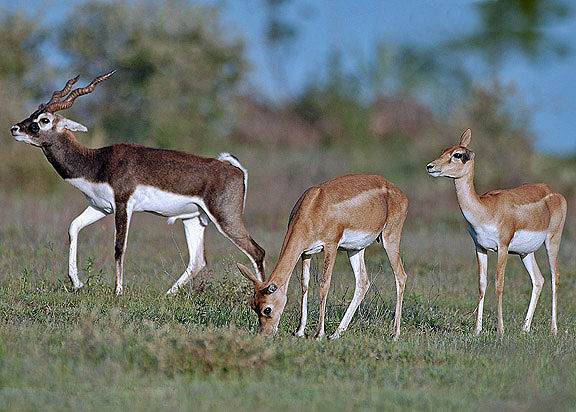
Abb.:
हरिणाः ।
Antilope cervicapra Linnaeus, 1758 - Hirschziegenantilope - Blackbuck,
Nannaj, bei Solapur - सोलापुर, Maharashtra
[Bildquelle: Mr Raja Purohit / Wikipedia. --
Creative Commons
Lizenz (Namensnennung, share alike)]
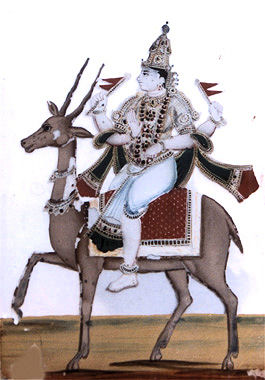
Abb.: Gott Vāyu auf seinem vāhana, einer Antilope, 19. Jhdt.
[Bildquelle: Wikimedia. -- Public domain]
|
"This beautiful antelope is found throughout
India in suitable localities, and does not occur out of our province. It is
rare in Bengal, a few only extending into Purneah and Dinagepore, north
of the Ganges ; and it does not occur in the richly-wooded Malabar
coast. It is abundant in the Deccan, in parts of the Doab between the
Jumna and Ganges, also in Hurriana, Rajpootana, and neighbouring
districts. It is found in the Punjab, but does not cross the Indus. I have
seen larger herds in the neighbourhood of Jalna, in the Deccan, than
anywhere else, occasionally some thousands together, with black bucks in
proportion. Now and then, Dr. Scott informs me, they have been
observed in the Government cattle farm at Hissar in herds calculated at
8,000 to 10,000. Generally throughout the country, smaller herds are
more common, where one black buck is accompanied by his harem of ten
to twenty does, or even more. With these herds younger bucks that
have not turned black are occasionally seen, the lord of the herd
driving off the other bucks as soon as they begin to turn black.
Mr. Elliot says, "The rutting season commences about February
or March, but fawns are seen of all ages at
every season. During the spring months the buck often separates a
particular doe from the herd, and will not suffer her to join it again,
cutting her off and intercepting every attempt to mingle with the rest. The
two are often found alone also, but on being followed always rejoin the
herd.
" When a herd is met with and alarmed, the
does bound away for a short distance, and then turn round to take a
look ; the buck follows more leisurely, and generally brings up the rear.
Before they are much frightened they always bound or spring, and a
large herd going off in this way is one of the finest sights
imaginable. But when at speed, the gallop is like that of any other animal. Some
of the herds are so large that one buck has from 50 to 60 does, and the
young bucks driven from these large flocks are found wandering in
separate herds, sometimes containing as many as 30 individuals of different ages.
"They show some ingenuity in avoiding danger.
In pursuing a buck once into a field of toor, I suddenly lost
sight of him, and found, after a long search, that he had dropt down among the
grain, and lay concealed with his head close to the ground. Coming on
another occasion upon a buck and doe with a young fawn, the whole
party took to flight, but the fawn being very young, the old ones
endeavoured to make it lie down. Finding, however, that it persisted in
running after them, the buck turned round and repeatedly knocked it over in a
cotton-field until it lay still, when they ran off, endeavouring to attract my
attention. Young fawns are frequently found concealed and left quite
by themselves."
When a herd goes away on the approach of
danger, if any of the does are lingering behind, the buck comes up and
drives them off after the others, acting as whipper-in, and never
allowing one to drop behind. Bucks may often be seen fighting, and are then
so intently engaged, their heads often locked together by the horns,
that they may be approached very close before the common danger causes
them to separate. Bucks with broken horns are often met with, caused
by fights ; and I have heard of bucks being sometimes caught in this way,
some nooses being attached to the horns of a tame one. I have twice seen
a wounded antelope pursued by greyhounds drop suddenly into a small
ravine, and lie close to the ground, allowing the dogs to pass over it
without noticing, and hurry forward. This antelope, and indeed all
the Indian species, have the habit of always dropping their dung in
the same spot.
Buck-shooting is one of the favourite sports
of India, and gives fine opportunities for testing the skill of the
sportsman. Where they are very abundant and the ground is favourable, shots
can generally be had with a little trouble in stalking, at from 100 to
150 yards, and sometimes closer ; but in very open ground, shooting must be
practised at from 200 to 300 yards. During the heat of the day antelopes
usually lie down to rest and chew the cud, and a single one may then often
be stalked successfully ; but if there is a herd, one of the females is
always on the alert.
A wounded antelope gives occasionally an
excellent course with greyhounds, and I have known one with a broken fore-leg
get away from half-bred dogs in the middle of the day when
the sun was rather powerful. Spearing a wounded buck off horseback is
rather exciting work, and I have known one, also with a broken leg,
give a run of three miles before he was overhauled, and that on
tolerably good ground. Greyhounds are very keen after a wounded antelope, and
occasionally get savage and fight over it when pulled down,
seeming to take pleasure in sniffing and biting at the groin-pits.
Very rarely, good greyhounds have pulled down
this antelope unwounded on ordinary ground ; but there are at least
three localities where this coursing used to be practised
successfully : one at Pooree, on the east coast, south of Cuttack, where the
antelopes are found in the morning on an extensive plain of heavy sand,
and if the dogs are slipped favourably, they are sometimes pulled down
before they can get on to hard ground. Another is in the desert near
Sirsa, where the ground is entirely sandy. The third locality is at
Point Calymere, also on the east coast, very far south, not far from
Trichinopoly, where there is a tract of fine pasture land always green and
elastic, and on which first-rate English dogs have repeatedly pulled down
black buck. I rather think that the antelopes here are in somewhat
soft condition, the grass being always green, and that from this cause
they are more easily caught than elsewhere. During the rains, indeed, if
antelopes are found in the fields where the soil is very soft and heavy,
they fall an easy prey to good dogs.
The venison of this antelope is at times
excellent, the meat very fine-grained, but not fat. Colonel W. Campbell says, that
of old bucks is infinitely superior to that of young ones. If
taken young, this antelope becomes very tame, and will follow its owner
about, or wander forth by itself all day and return at evening. I have
often seen one accompanying a regiment on the line of march.
This antelope is living in the Zoological
Gardens, in London. A large herd of them is kept in the park round
Government-house at Madras.
It is one of the constellations of the Indian
zodiac, and is sacred to Chandra. There is no other species of this genus."
[Quelle: Jerdon,
Thomas Claverhill <1811-1872>: The mammals of India : a natural history of
all the animals known to inhabit continental India. -- London, 1874. -- S.
277ff.] |
Tetracerus quadricornis de Blainville, 1816 -
Vierhornantilope - Four-horned Antelope
Schulterhöhe: 55 - 65 cm
Gewicht: 20 kg
Lebensraum: ganz Indien südlich von Himalaya bis Nordabhang der Nilgiris, nicht
im Nordosten
Noch in Freiheit lebende Individuen: ca. 10.000
Lebt als Einzelgänger bzw. in Gruppen von 2 - 6 Tieren
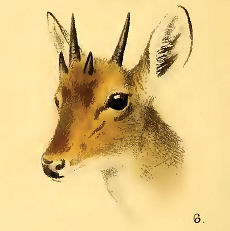
Abb.: Tetracerus quadricornis de Blainville, 1816 - Vierhornantilope
- Four-horned Antelope
[Bildquelle: Lydekker, Richard <1849 - 1915>: The great and small game of India, Burma, & Tibet. --
London, 1900. -- Pl. 5]
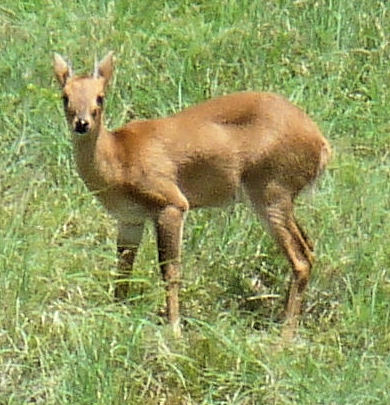
Abb.: Tetracerus quadricornis de Blainville, 1816 - Vierhornantilope
- Four-horned Antelope; Nilgiris, Tamil Nadu
[Bildquelle: Mohan Raj / Wikipedia. --
Creative Commons
Lizenz (Namensnennung, share alike)]
|
"The four-horned antelope is found throughout all India, to which it is exclusively limited,
not being known in Ceylon nor the countries to the east of the Bay of
Bengal. It frequents jungly hills and open forests in the plains, not
occurring in the dense woods of Malabar, nor in lower Bengal. It abounds in
the hills of the Eastern Ghats from near Madras northwards, whence it
extends over all the wooded parts of Central India ; and on the
west is found in parts of Mysore, and in the jungles that border the
Western Ghats. It is unknown in the valley of the Ganges, but
occurs at the foot of the Himalayas, in the more open forests. It is
said by Adams to occur, though rarely, in the Western Punjab and
Sindh.
The Chousingha never frequents open plains,
but may be seen in open glades in the forests, and in bushy ground at
the skirts of denser woods, and is always found single or in pairs, being
strictly monogamous. Barely I have seen five or six scattered not
far from each other. It is not a mountain animal, but is quite at
home on rocky and jungly hills. When first disturbed, it
sometimes bounds off in a succession of short leaps, but generally runs
with its neck low. It is stated to rut (in Central India) during the
rains, and the female to bring forth her young in the cold weather.
The specific name, Chickara, applied to this
antelope by Hardwicke, is quite erroneous, as that name is
throughout all India applied to the Indian gazelle. The venison of this antelope
is rather dry, and is not held in much esteem."
[Quelle: Jerdon,
Thomas Claverhill <1811-1872>: The mammals of India : a natural history of
all the animals known to inhabit continental India. -- London, 1874. -- S.
274f.] |
Gazella bennettii Sykes, 1831 - Indische Gazelle -
Indian Gazelle (Chinkara)
Schulterhöhe: 65 cm
Gewicht: 23 kg
Lebensraum: Trockengebiete in ganz Nordwest- und Zentralindien, besonders
Rajasthan und Gujarat, bis 1500 m ü. M.
Noch in Freiheit lebende Individuen: ca. 100.000
Lebt in Herden von 3 - 30 Tieren
Kann viele Tage überleben ohne zu trinken (erhält dann sein
Wasser aus dem Futter und von Tau)
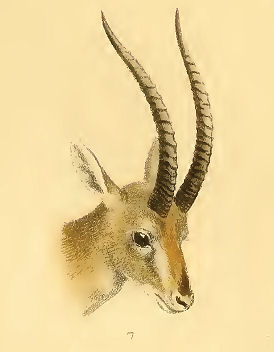
Abb.: Gazella bennettii Sykes, 1831 - Indische Gazelle -
Indian Gazelle (Chinkara)
[Bildquelle: Lydekker, Richard <1849 - 1915>: The great and small game of India, Burma, & Tibet. --
London, 1900. -- Pl. 5]
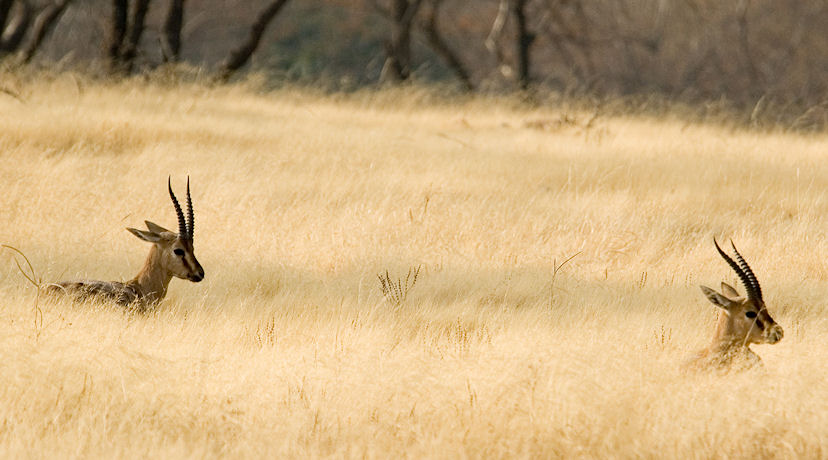
Abb.: Gazella bennettii Sykes, 1831 - Indische Gazelle -
Indian Gazelle (Chinkara), Ranthambore National Park -
रंथांबोर राष्ट्रीय उद्यान,
Rajasthan
[Bildquelle:
Paul Asman and Jill Lenoble. --
http://www.flickr.com/photos/pauljill/2156068544/. -- Zugriff am 2010-12-15.
-- Creative Commons
Lizenz (Namensnennung)]
|
"The Indian Gazelle is found throughout India
in suitable localities, unknown in lower Bengal and the Malabar coast,
and most abundant in the desert parts of Rajpootana, Hurriana, and
Sindh. It is never found in forest country, nor in districts having a
damp climate, but is often met with in low thorny jungle. As a rule, however,
it prefers the open bare plains, or low rocky hills or sand-hills ;
and a barren country to a richly cultivated one. It occurs generally in small
herds, rarely more than 7 or 8, except in the extreme north-west, where
I have seen 20 or more together. Usually I think there are several
bucks if the herd is large, but the young expelled bucks are also often
found in separate herds. Single individuals are also of common
occurrence.
Mr. Elliot says, "When two bucks fight they butt like rams,
retiring a little and striking the foreheads together
with great violence. When alarmed, it utters a sort of hiss by blowing
through the nose, and stamps with the fore-feet ; whence its Canarese name,
' Tiska.'"
Dr. Scott informs me that in Hurriana, during
the rainy season, a sort of maggot or bot is constantly found under
the skin of the Gazelle, only near the root of the tail. It was never
observed on the Antelope.
The Gazelle is occasionally hunted by dogs
with the aid of the Saker falcon (Falco Cherrug) which strikes the
antelope on the head, and confuses it, so that the dogs come up and catch it.
Without this aid, dogs have very little chance, though now and then
I have known one pulled down. It is considered better eating than the black buck."
[Quelle:
Jerdon,
Thomas Claverhill <1811-1872>: The mammals of India : a natural history of
all the animals known to inhabit continental India. -- London, 1874. -- S.
280f.] |
Procapra picticaudata Hodgson, 1846 - Tibetgazelle - Tibetan Gazelle (Gowa)
Schulterhöhe: 60 cm
Gewicht: 26 - 40 kg
Lebensraum: Alpine Weiden und Steppen Ostladakhs und Sikkims
Noch in Freiheit lebende Individuen: weniger als 100
Lebt als Einzelgänger oder in Herden von 5 - 15
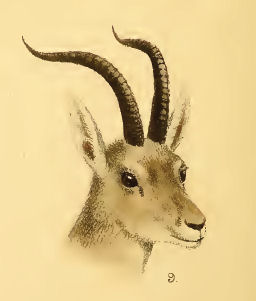
Abb.: Procapra picticaudata Hodgson, 1846 - Tibetgazelle - Tibetan Gazelle
(Gowa)
[Bildquelle: Lydekker, Richard <1849 - 1915>: The great and small game of India, Burma, & Tibet. --
London, 1900. -- Pl. 5]
|
"Another antelope allied to the Gazelles is
the pretty Procapra picticaudata of Hodgson, the Goā and Rā-goā of Tibet."
[Quelle:
Jerdon, Thomas Claverhill <1811-1872>: The mammals of India : a
natural history of all the animals known to inhabit continental
India. -- London, 1874. -- S. 282.] |
Pantholops hodgsonii Abel, 1826 - Tschiru - Chiru (Tibetan Antelope)
Schulterhöhe: 74 - 83 cm
Gewicht: 26 - 40 kg
Lebensraum: Wüsten des Transhimalaya (Ladakh)
Noch in Freiheit lebende Individuen: 200 - 500
Lebt in Herden von 5 - 25 Tieren

Abb.: Pantholops hodgsonii Abel, 1826 - Tschiru - Chiru (Tibetan Antelope)
[Bildquelle: Lydekker, Richard <1849 - 1915>: The great and small game of India, Burma, & Tibet. --
London, 1900. -- Pl. 5]
|
"The Chiru of Tibet, Kemas Hodgsonii, is a
fine antelope, of a somewhat pale yellowish-white colour, with very long
and nearly straight horns. It is considered to be the Kemas of Aelian.
It is probable that this animal may have given rise to the belief in
the unicorn ; for, at a little distance, when viewed laterally, there only
appears to be one horn, there is so little divergence throughout their length."
[Quelle:
Jerdon, Thomas Claverhill <1811-1872>: The mammals of India : a
natural history of all the animals known to inhabit continental
India. -- London, 1874. -- S. 282] |
2.9.17. Adjektivbildung zur Eṇa-Antilope
|
8. c./d. aiṇeyam eṇyāś carmādyam eṇasyaiṇam ubhe triṣu
ऐनेयम् एण्याश् चर्माद्यम् एणस्यैणम् उभे त्रिषु ॥८ ख॥
Das Adjektiv für Fell usw., das stammt von एणी - eṇī
f.: Weibchen der Eṇa-Antilope1 ist ऐणेय - aiṇeya 3: zur Eṇī
gehörig, von der Eṇi stammend.
Das Adjektiv für Fell usw., das stammt
von एण - eṇa m.: Männchen der Eṇa-Antilope ist ऐण - aiṇa 3: zum Eṇa
gehörig, vom Eṇa stammend. |
Colebrooke (1807): "Belonging to a doe."
[b:] "Belonging to a buck."
1 एण -eṇa m.: "eine Antilopenart (schwarz und mit kurzen Beinen)"
(PW) ; Encyclopaedia of Indian
medicine. -- Vol. 5. -- S. 83: "Fawn deer, Black deer"
Vielleicht: Moschiola indica Gray, 1843 - Indian Spotted Chevrotain (Mouse Deer)
(kurze Beine!)
Moschiola indica Gray, 1843 - Indian Spotted Chevrotain + Moschiola meminna Erxleben, 1777 - Sri Lankan Spotted
Chevrotain +
Moschiola kathygre Groves & Meijaard, 2005 - Yellow-striped
Chevrotain
Schulterhöhe: 25 - 30 cm
Gewicht: 2 - 4 kg
Lebensraum: ganz Südindien bis 24° N (Moschiola indica), Sri Lanka (Moschiola meminna
+ Moschiola kathygre)
Noch in Freiheit lebende Individuen: unbekannt
Lebt als Einzelgänger, bzw. in Paaren

Abb.: Moschiola indica Gray, 1843 - Indian Spotted Chevrotain (Mouse Deer)
[Bildquelle: Lydekker, Richard <1849 - 1915>:
The great and small game of India, Burma, & Tibet. --
London, 1900. -- Pl. 7]
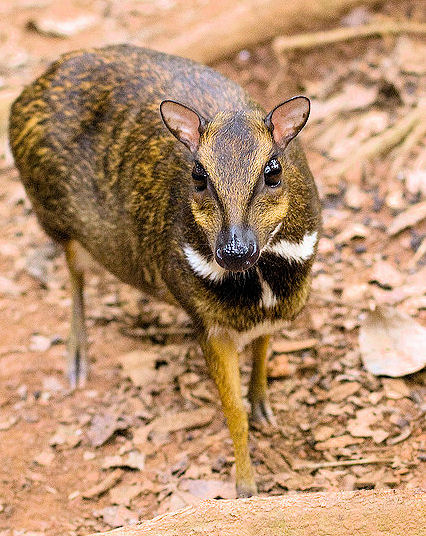
Abb.: Moschiola indica Gray, 1843 - Indian Spotted Chevrotain (Mouse Deer), Zoo
[Bildquelle: Jonathan Wong. --
http://www.flickr.com/photos/uncajon/3187637125/. -- Zugriff am 2010-12-16.
-- Creative
Commons Lizenz (Namensnennung, keine kommerzielle Nutzung)]
|
"The Indian Mouse-deer is found in all the
large forests of India from the extreme south to the foot of the
Himalayas, but it does not occur at any great elevation, and I have rarely seen
it from higher altitude than about 2,000 feet. It is much more abundant in
the south of India than towards the north, and is certainly rare in
the Himalayan Terai. It is not included among the list of Hodgson's
Collections, presented to the British Museum, but Blyth says he has seen it
from Nepal, and certainly Mr. Hodgson named it as above. I made many
inquiries about it in various parts near the foot of the hills, but
could get no precise information as to its actually occurring
there. It is unknown in the countries to the eastward of the Bay of
Bengal. It abounds in the forests of Malabar, and also occurs in some
of the denser portions of the woods of the Eastern Ghats. It is by no means
rare in Central India, and Tickell has given some interesting
details of its habits, from which I have taken the subsequent account.
The animal walks on the tips of its hoofs,
which gives the legs a rigid appearance, and the natives say that it has
no knee-joint, and that, in order to rest, it is obliged to lean against
a tree. It never ventures into the open country ; keeps a good deal among
rocks ; and it is said not to go out much about the fall of the leaf, as
its sharp hoofs penetrate the leaves, which clog its movements. They rut in
June and July, and the female brings forth two young towards the end
of the rains, or beginning of the cold weather.
The Mouse-deer is timid but easily
domesticated, and has bred in confinement."
[Quelle:
Jerdon, Thomas Claverhill <1811-1872>: The mammals of India : a
natural history of all the animals known to inhabit continental
India. -- London, 1874. -- S. 270.] |
2.9.18. Fell-Lieferanten
9. kadalī kandalī cīnaś camūru-priyakāv api
samūruś ceti hariṇā amī ajinayonayaḥ
कदली कन्दली चीनश् चमूरु-प्रियकाव् अपि
समूरुश् चेति हरिणा अमी अजिनयोनयः ॥९॥
Fell-Lieferanten sind folgende Antilopen und Gazellen:
- कदली - kadalī f.: Kadalī
- कन्दली - kandalī f.: Kandalī
- चीन - cīna m.: Chinese
- चमूरु - camūru m.: Camūru (viell.
zu camū f.: Schüssel, bes. das Gefäß, in welches der Soma abfließt
- प्रियक - priyaka m.: Lieblicher
- समूरु - samūru m.: Samūru (evtl. zu
ūru m.: Schenkel)
|
Colebrooke (1807): "Sorts of deer, of which the hides are used."
Ich kann keine Zuordnung der Sanskritbezeichnungen zu bestimmten Arten
machen.
2.9.19. Verschiedenerlei Wild
10. kṛṣṇasāra-ruru-nyaṅku-raṅku-śambara-rauhiṣāḥ
gokarṇa-pṛṣataiṇarśya-rohitāś camaro mṛgāḥ
कृष्णसार-रुरु-न्यङ्कु-रङ्कु-शम्बर-रौहिषाः ।
गोकर्ण-पृषतैणर्श्य-रोहिताश् चमरो मृगाः ॥१०॥
Wild (mṛga) ist:
- कृष्णसार - kṛṣṇasāra m.:
Schwarzscheckiger, schwarzscheckige Antilope (Moschiola indica Gray, 1843 - Indian Spotted Chevrotain + Moschiola meminna Erxleben,
1777 ?)
- रुरु - ruru m.: Rucervus duvaucelii
G.
Cuvier, 1823 - Barasingha / Zackenhirsch - Barasingha (Swamp Deer)
- न्यङ्कु - nyaṅku m.: Axis porcinus Zimmermann, 1780 - Schweinshirsch - Hog Deer
(zu ni-añj: sich verstecken ?)
- रङ्कु - raṅku m.: Raṅku
- शम्बर - śambara m.: Rusa unicolor
Kerr, 1792 - Sambar
- रौहिष - rauhiṣa m.: Rauhiṣa
- गोकर्ण - gokarṇa m.: Kuhohr
- पृषत - pṛṣata m.: Gesprenkelter =
Axis axis Erxleben, 1777 - Axishirsch - Chital
- एण - eṇa m.:
Eṇa, vielleicht: Moschiola indica Gray, 1843 - Indian Spotted Chevrotain (Mouse Deer)
- ऋश्य - ṛśya m.:
Moschus leucogaster Hodgson, 1839 - Himalaya-Moschushirsch -
Himalayan Musk Deer
- रोहित - rohita m.: Roter (eine am Wasser lebende
Hirschart, PW)
- चमर - camara m.: Bos grunniens Przewalski, 1883 - Yak -
གཡག་ (männl.) /
འབྲི (weibl.)
|
Colebrooke (1807): "Various sorts of deer.
Severally named in the text, as the black antelope, the stag, &c. But these
terms are not all rigidly applied to different species ; and some are not of the
deer kind."
"ऋश्यः . Also ऋष्यः and रिष्यः. The painted or
white-footed antelope."
"चमरः ; though here placed among the deer, the Bos
grunniens is meant."
2.9.19.1. कृष्णसार - kṛṣṇasāra m.: Schwarzscheckiger, schwarzscheckige
Antilope (Moschiola indica Gray, 1843 - Indian Spotted Chevrotain + Moschiola meminna Erxleben,
1777 ?)
| 10.a/b. kṛṣṇasāra-ruru-nyaṅku-raṅku-śambara-rauhiṣāḥ
कृष्णसार-रुरु-न्यङ्कु-रङ्कु-शम्बर-रौहिषाः ।१० क।
कृष्णसार - kṛṣṇasāra m.: Schwarzscheckiger, schwarzscheckige
Antilope (Moschiola indica Gray, 1843 - Indian Spotted Chevrotain + Moschiola meminna Erxleben,
1777 ?) |
Schwarzscheckig ist Moschiola indica Gray, 1843 - Indian Spotted Chevrotain + Moschiola meminna Erxleben,
1777. Siehe oben Vers 8c/d.

Abb.: कृष्णसारः
।
Moschiola indica Gray, 1843 - Indian Spotted Chevrotain (Mouse Deer), Zoo
[Bildquelle: Jonathan Wong. --
http://www.flickr.com/photos/uncajon/3187637125/. -- Zugriff am 2010-12-16.
-- Creative
Commons Lizenz (Namensnennung, keine kommerzielle Nutzung)]
2.9.19.2. रुरु - ruru m.: Rucervus duvaucelii G.
Cuvier, 1823 - Barasingha / Zackenhirsch - Barasingha (Swamp Deer)
| 10.a/b.
kṛṣṇasāra-ruru-nyaṅku-raṅku-śambara-rauhiṣāḥ
कृष्णसार-रुरु-न्यङ्कु-रङ्कु-शम्बर-रौहिषाः ।१०
क।
रुरु - ruru m.: Rucervus duvaucelii G.
Cuvier, 1823 - Barasingha / Zackenhirsch - Barasingha (Swamp Deer) |
Schulterhöhe: 115 - 135 cm
Gewicht: 170 - 180 kg
Lebensraum: Westliches Terai, Assam, Zentralindien
Noch in Freiheit lebende Individuen: über 2000
Lebt in Herden von 50 bis über 100 Tieren
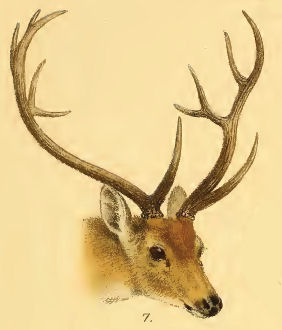
Abb.: रुरुः । Rucervus duvaucelii G.
Cuvier, 1823 - Barasingha / Zackenhirsch - Barasingha (Swamp Deer)
[Bildquelle: Lydekker, Richard <1849 - 1915>:
The great and small game of India, Burma, & Tibet. --
London, 1900. -- Pl. 6]
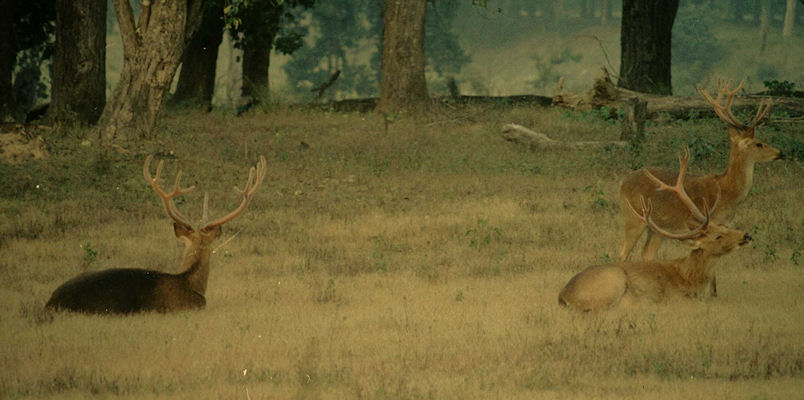
Abb.: रुरवः । Rucervus duvaucelii G.
Cuvier, 1823 - Barasingha / Zackenhirsch - Barasingha (Swamp Deer), Kanha National Park - कान्हा
राष्ट्रीय उद्यान, Madhya Pradesh
[Bildquelle: Altaipanther / Wikipedia. -- Public domain]
|
"This fine deer is found in the forest-land at
the foot of the Himalayas, from the Kyarda Doon to Bhotan, and is very
abundant in Assam, inhabiting the islands and churrs of the Berrampooter,
extending down the river in suitable spots to the eastern
Sunderbuns. It is also stated to occur near Monghyr, and thence extends
sparingly through the great forest tract of Central India. It is rare to the
south of the Nerbudda, but it has to my knowledge been killed between the
Nerbudda and Nagpore, not far from Seonee, and it is tolerably
abundant in the open forest land between Mundlah and Omerkuntak, at the source
of the Nerbudda. To the east of this forest tract it has been
killed near Midnapore, and in the highlands of Goomsoor ; but does not, as far
as is known, extend so far west as the road between Mirzapore and
Jubbulpore. It is very gregarious, being often found in large flocks feeding in
plains near the forests, and when pursued often keeping in a close pack
till they gain the shelter of the forest. A writer in the Indian Sporting
Review thus speaks of these deer as he saw them in Central India : "The plain
stretched away in gentle undulations towards the river, distant about
a mile, and on it were three large herds of barasinghas feeding at one
time : the nearest was not more than five hundred yards away from where I
stood : there must have been at least fifty of them, stags, hinds, and
fawns, feeding together in a lump, and outside the herd grazed three most
enormous stags. . . . Then the herd went off in earnest, showing a perfect
forest of antlers, and the clatter of their hoofs on the hard ground was
like the sound of a squadron of cavalry going to water." According to
Hodgson, it never enters the mountains of the Himalayas, nor even
habitually frequents the depths of the forests. His lair is on the skirts of
large forests, amidst swampy and grassy glades. It is found sparingly in
the forests of the Dehra and Kyarda Doons, and here it is occasionally
found on the low hills as well as on the valleys. I have seen it in Dehra Doon
in long grass, and in forest in the Kyarda Doon. It is said to be
exceedingly numerous in Assam, enormous herds occurring in the grassy
churrs of rivers. It is stated to feed both on grass and on the bark
and young shoots of trees.
The name Maha, sometimes applied to this deer,
is also given to the Samber stag, and it is occasionally called
Jhānk, a name usually applied to the male spotted deer. This deer is now
living in the Zoological Society's Gardens, London, and has bred there."
[Quelle:
Jerdon, Thomas Claverhill <1811-1872>: The mammals of India : a
natural history of all the animals known to inhabit continental
India. -- London, 1874. -- S. 254f.] |
2.9.19.3. न्यङ्कु - nyaṅku m.: Axis porcinus Zimmermann, 1780 - Schweinshirsch - Hog Deer
| 10.a/b.
kṛṣṇasāra-ruru-nyaṅku-raṅku-śambara-rauhiṣāḥ
कृष्णसार-रुरु-न्यङ्कु-रङ्कु-शम्बर-रौहिषाः ।१०
क।
न्यङ्कु - nyaṅku m.: Axis porcinus Zimmermann, 1780 - Schweinshirsch - Hog Deer |
Schulterhöhe: 60 - 70 cm
Gewicht: 36 - 50 kg
Lebensraum: Terai und Duars von Uttaranchal bis Assam, Mizoram und Manipur
Noch in Freiheit lebende Individuen: unbekannt
Lebt in Herden (futternd), als Einzelgänger
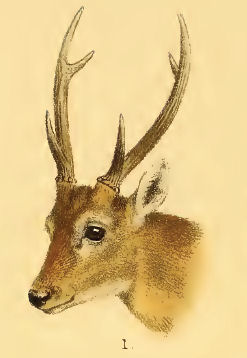
Abb.: न्यङ्कुः । Axis porcinus Zimmermann, 1780 - Schweinshirsch -
Hog Deer
[Bildquelle: Lydekker, Richard <1849 - 1915>: The great and small game of India, Burma, & Tibet. --
London, 1900. -- Pl. 7]
|
"The Hog-deer is found throughout the Gangetic
valley in suitable spots, extending to the foot of the hills, and more
rarely into General India. It is also found in the Punjab and Sindh, and is
abundant in Assam, Sylhet, and Burmah. It has been stated to inhabit
south Malabar and Ceylon, but the race from the latter country differs
somewhat, and is probably distinct, and neither M. Blyth nor myself has actually
seen specimens from Malabar, though I was resident in north
Malabar for some time. It is very abundant in Bengal, in many parts near the
foot of the Himalayas, in Deyra Doon, and near the Ganges, Jumna,
Sutlej, and other large rivers, frequenting chiefly long grass and jhow
jungle. It rarely seeks the shelter of forests, though frequenting grassy
grounds in open forests and open glades in the thicker jungles. It lies
sheltered during the day in thick patches of long grass, or in thick
bushes in the grassy plains, and lies very close, often getting up within a
few feet of the elephant or beaters. It runs with its head low and in a
somewhat ungainly manner ; hence its popular appellation in India of
Hog-deer. It is not gregarious, both sexes lying solitary in general, though
at times two ore more may be put up together. From the nature of the
ground it frequents, high grass, &c., it is generally shot from off
elephants. It is not very speedy, and if it breaks into a patch of open ground
can be run down by dogs. The buck drops his horns in April generally,
and ruts in September and October. The young are beautifully
spotted.
Both this and the spotted deer are living in
the Zoological Gardens, and have bred there."
[Quelle:
Jerdon, Thomas Claverhill <1811-1872>: The mammals of India : a
natural history of all the animals known to inhabit continental
India. -- London, 1874. -- S. 263.] |
2.9.19.4. रङ्कु - raṅku m.: Raṅku
| 10.a/b.
kṛṣṇasāra-ruru-nyaṅku-raṅku-śambara-rauhiṣāḥ
कृष्णसार-रुरु-न्यङ्कु-रङ्कु-शम्बर-रौहिषाः ।१०
क।
रङ्कु - raṅku m.: Raṅku |
Kann ich nicht eindeutig zuordnen.
2.9.19.5. शम्बर - śambara m.: Rusa unicolor Kerr, 1792 - Sambar
| 10.a/b.
kṛṣṇasāra-ruru-nyaṅku-raṅku-śambara-rauhiṣāḥ
कृष्णसार-रुरु-न्यङ्कु-रङ्कु-शम्बर-रौहिषाः ।१०
क।
शम्बर - śambara m.: Rusa unicolor Kerr, 1792 - Sambarव् |
Schulterhöhe: 150 cm
Gewicht: 225 - 320 kg
Lebensraum: Ganz Indien (außer Wüsten, Mangroven und Hochgebirge)
Noch in Freiheit lebende Individuen: 50.000 - 100.000
Lebt in Herden von 2 - 12 Tieren, Männchen als Einzelgänger
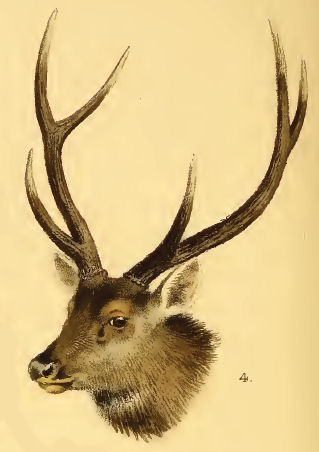
Abb.: शम्बरः । Rusa unicolor Kerr, 1792 - Sambar
[Bildquelle: Lydekker, Richard <1849 - 1915>:
The great and small game of India, Burma, & Tibet. --
London, 1900. -- Pl. 6]
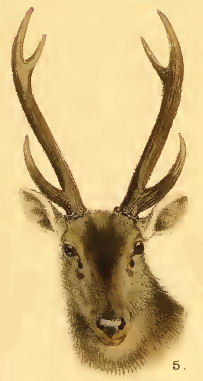
Abb.: शम्बरः । Rusa unicolor equina G. Cuvier, 1823 - Malay Sambar
[Bildquelle: Lydekker, Richard <1849 - 1915>:
The great and small game of India, Burma, & Tibet. --
London, 1900. -- Pl. 6]
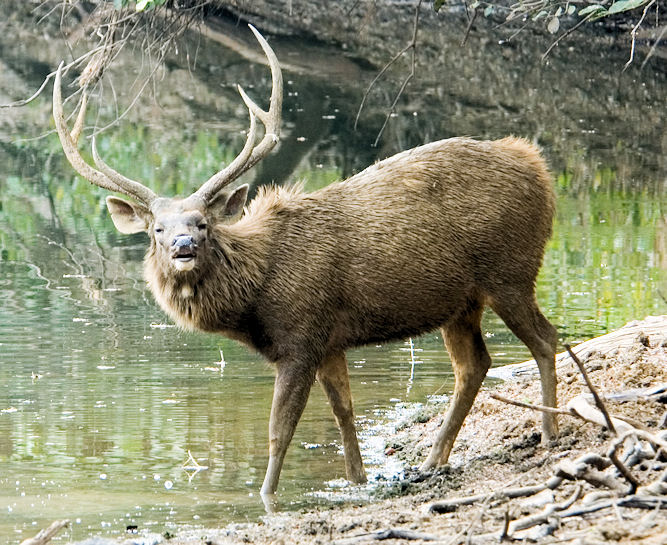
Abb.: शम्बरः । Rusa unicolor Kerr, 1792 - Sambar, Ranthambore National Park - रणथम्भौर राष्ट्रीय
अभ्यारण्य, Rajasthan
[Bildquelle:
Paul Asman and Jill Lenoble. --
http://www.flickr.com/photos/pauljill/2155267379/. -- Zugriff am 2010-12-15.
-- Creative Commons
Lizenz (Namensnennung)]
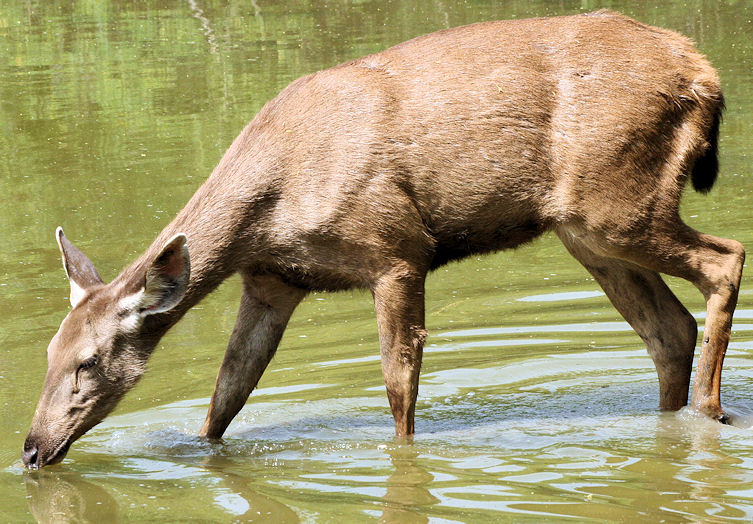
Abb.: Rusa unicolor Kerr, 1792 - Sambar, Weibchen, Keoladeo
National Park
[Bildquelle: Flying Pharmacist / Wikipedia. --
Creative Commons
Lizenz (Namensnennung, share alike)]
|
"The Samber, or Jerrow, is found in all the
large forests of India, from the extreme south to the Himalayas, ascending
these mountains to 9,000 or 10,000 feet of elevation. Among other
localities may be named the Western Ghats throughout their whole extent,
the Wynaad, Coorg, the Neelgherries, many parts of Mysore, the Eastern
Ghats, the Vindhya and Sautpoora ranges of hills, and all Central
India where sufficient cover is afforded by the forests. Also, the whole
range of Himalayas, not only at their base but far within the hills. As a
rule they prefer hilly ground to flat land ; but if the forest is dense, are
frequently found on comparatively level country. They rarely leave the coverts
of the forests, but in elevated and cool districts, as on the Neelgherries
and Himalayas, &c., they may not unfrequently be seen morning and evening
outside a patch of jungle, grazing on the new grass that springs up
after the old grass is burnt off. They are generally more or less gregarious,
being often found in herds, varying from four or five to twenty and
upwards ; but both males and females are occasionally found alone. In the
daytime they seek the most sheltered spots, especially in hot districts,
and in the hot weather, and are very impatient of the sun's rays. They
feed both on grass, on young shoots, and on various fruits. They travel
wonderfully over rocky and stony ground.
The stags drop their horns in April,
sometimes earlier, and the new horns are not perfected till the end of
September, about which time the rutting season commences, and their peculiar
call may be heard, especially morning and evening. Mr. Elliot says that "the stags are then fierce and bold. I have seen one, when
suddenly disturbed, face the intruder for a moment, shaking his head,
bristling his mane, distending the suborbital sinus, and then dashing into
the cover." The females produce one young at a birth.
The eye-pit, or suborbital sinus, is very
large in these deer, and when the animal is excited or angry, or
frightened, it is opened very large, and can be distended at pleasure. Hodgson says
that it is completely reversile.
The pursuit of this large stag is a favourite
sport in India, its great size and fine horns causing it to be greatly
prized by sportsmen. It is either stalked in the forests, or when seen
feeding outside a patch of jungle ; but is generally driven by a line of
beaters, the gunners being posted at intervals. The clattering of a herd
of samber over the stones may often be heard for some distance before
they come in view, usually following one another in single file, and
giving a succession of shots. The action of this animal is by no means
elegant, but it gets over a great deal of rough ground very rapidly, with an
apparently heavy, lumbering, lobbing gallop. I have known it killed by
foxhounds on the Neelgherries ; and large powerful deerhounds will bring it
to bay occasionally. When hard pressed it often takes to water. As
previously mentioned, I have known it killed by the wild dog. In
the interior of the Himalayas many are killed in winter in the snow, the
hillmen mobbing them, and knocking them on the head with clubs. I
have seen some very fine horns in Kumaon procured thus. The flesh of
the Samber is rather coarse, and rarely fat, but sometimes
well-tasted.
The specific names Hippelaphus and Aristotelis were given under
the impression that this stag was the Hippelaphus, i. e. the
horse-deer, of Aristotle ; but most naturalists think that the Nylghai was
intended, and not this animal.
This deer is found in Ceylon, in Assam,
Burmah, the Malayan peninsula, and some of the islands. Blyth remarks that "the race seems rather smaller in Burmah, the Malayan
peninsula, and Sumatra, being the R. equina, Auct. ; but it does not appear
to me to be fairly separable. I have never seen really fine horns from the
eastward of the Bay of Bengal."
Several individuals of this deer are living
in the Zoological Gardens, where it has bred for some years."
[Quelle:
Jerdon, Thomas Claverhill <1811-1872>: The mammals of India : a
natural history of all the animals known to inhabit continental
India. -- London, 1874. -- S. 258ff.] |
2.9.19.6. रौहिष - rauhiṣa m.: Rauhiṣa
| 10.a/b.
kṛṣṇasāra-ruru-nyaṅku-raṅku-śambara-rauhiṣāḥ
कृष्णसार-रुरु-न्यङ्कु-रङ्कु-शम्बर-रौहिषाः ।१०
क।
रौहिष - rauhiṣa m.: Rauhiṣa |
Kann ich nicht eindeutig zuordnen.
2.9.19.7. गोकर्ण - gokarṇa m.: "Kuhohr"
| 10.c/d.
gokarṇa-pṛṣataiṇarśya-rohitāś camaro mṛgāḥ
गोकर्ण-पृषतैणर्श्य-रोहिताश् चमरो मृगाः ॥१० ख॥
गोकर्ण - gokarṇa m.: "Kuhohr" |
Kann ich nicht eindeutig zuordnen.
2.9.19.8. पृषत - pṛṣata m.: Gesprenkelter = Axis axis Erxleben, 1777 - Axishirsch - Chital
| 10.c/d. gokarṇa-pṛṣataiṇarśya-rohitāś camaro mṛgāḥ
गोकर्ण-पृषतैणर्श्य-रोहिताश् चमरो मृगाः ॥१०
ख॥
पृषत - pṛṣata m.: Gesprenkelter = Axis axis Erxleben, 1777 - Axishirsch - Chital |
Schulterhöhe: 90 cm
Gewicht: 85 kg
Lebensraum: ganz Indien westlich von Assam (ohne Jammu & Kashmir, Hochgebirge und
Wüsten)
Noch in Freiheit lebende Individuen: unbekannt
Lebt in Herden von 10 bis über 100 Tieren

Abb.: पृषतः । Axis axis Erxleben, 1777 - Axishirsch - Chital (Spotted Deer)
[Bildquelle: Lydekker, Richard <1849 - 1915>:
The great and small game of India, Burma, & Tibet. --
London, 1900. -- Pl. 6]
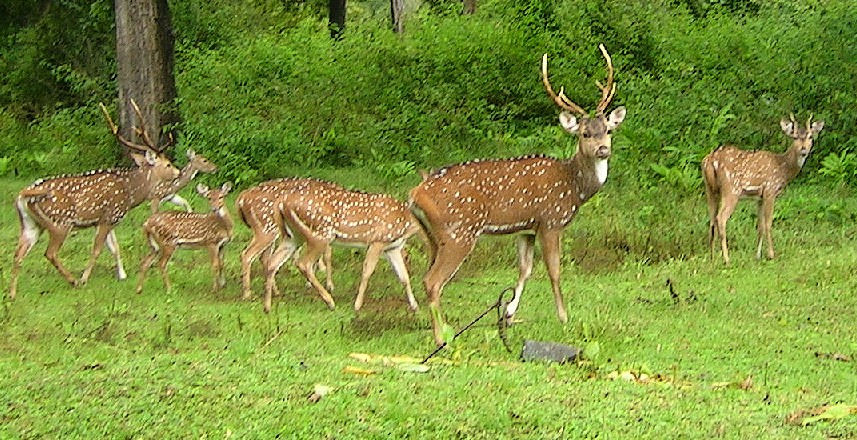
Abb.: पृषतः । Axis axis Erxleben, 1777 - Axishirsch - Chital (Spotted Deer),
Nagarhole National Park - ನಾಗರಹೊಳೆ ರಾಷ್ಟೀಯ ಉದ್ಯಾನವನ, Karnataka
[Bildquelle: L. Shyamal / Wikimedia. -- GNU FDLicense]
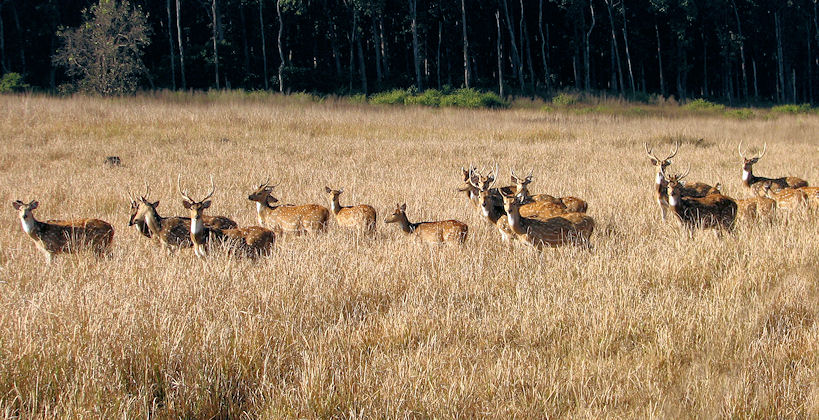
Abb.: पृषताः । Axis axis Erxleben, 1777 - Axishirsch - Chital (Spotted Deer), Jim
Corbett National Park
[Bildquelle: Shyamvs78 / Wikimedia. --
Creative Commons
Lizenz (Namensnennung)]
|
"The large spotted-deer is found in many of
the forests and jungles in Central India, both in hilly ground and
level plains, and is very abundant on both sides of the Nerbudda in
suitable places ; also in many localities along the Western Ghats and
Eastern Ghats, Northern Circars, &c. &c. It is also abundant along the lower
and outer ranges of the sub-Himalayas, and in the forests and jungles
that extend into the plains, and along the course of the large
rivers. It is also numerous in the Bengal Sunderbuns, but is not found wild
on the other side of the Bay of Bengal, nor does it extend into the
Punjab. Where numerous, they are very gregarious. Early in the
morning they may be found feeding in the open glades, but soon retire
to rest in the more shady and retired spots.
The Malabar spotted deer occurs in forest all
along the Malabar coast, coming to open glades or patches of rice-land
during the night, where it commits great depredations, and where it may
sometimes be shot early in the morning before it has retired to the
forest. I have seen herds of above a hundred of these deer at the foot of
the Neelgherries, and nearly as numerous ones in Malabar and in the Wynaad."
[Quelle:
Jerdon, Thomas Claverhill <1811-1872>: The mammals of India : a
natural history of all the animals known to inhabit continental
India. -- London, 1874. -- S. 262.] |
2.9.19.9. एण - eṇa m.: vielleicht = Moschiola indica Gray, 1843 - Indian Spotted Chevrotain (Mouse Deer)
| 10.c/d. gokarṇa-pṛṣataiṇarśya-rohitāś camaro mṛgāḥ
गोकर्ण-पृषतैणर्श्य-रोहिताश् चमरो मृगाः ॥१०
ख॥
एण - eṇa m.: vielleicht = Moschiola indica Gray, 1843 - Indian Spotted Chevrotain (Mouse Deer) |
Siehe oben Vers 8c/d.
2.9.19.10. ऋश्य - ṛśya m.: Moschus leucogaster Hodgson, 1839 - Himalaya-Moschushirsch -
Himalayan Musk Deer
| 10.c/d. gokarṇa-pṛṣataiṇarśya-rohitāś camaro mṛgāḥ
गोकर्ण-पृषतैणर्श्य-रोहिताश् चमरो मृगाः ॥१०
ख॥
ऋश्य - ṛśya m.: Moschus leucogaster Hodgson, 1839 - Himalaya-Moschushirsch -
Himalayan Musk Deer |
Hat Moschus-Drüse
Schulterhöhe: 50 cm
Gewicht: 13 - 15 kg
Lebensraum: Subalpine Eichen- und Rhododendron-Wälder, Wiesen von Jammu und
Kashmir bis Arunachal Pradesh (nicht in Ladakh); 2500 m bis Baumgrenze
Noch in Freiheit lebende Individuen: über 5000
Lebt als Einzelgänger bzw. in Paaren
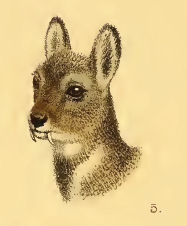
Abb.: ऋश्यः । Moschus sp. - Himalaya-Moschushirsch - Himalayan
Musk-Deer (Lydekker: Moschus moschiferus)
[Bildquelle: Lydekker, Richard <1849 - 1915>:
The great and small game of India, Burma, & Tibet. --
London, 1900. -- Pl. 7]
|
"The musk-deer is found throughout the
Himalayas, always at great elevations, in summer rarely below 8,000 feet,
and as high as the limits of forest. It extends through the Himalayas
to Central and Northern Asia, as far as Siberia.
Hodgson says that the Musk-deer is "solitary, living in retired spots near rocks, or in the depths of the forests.
They leap well but cannot climb nor descend slopes well.* They rut in
winter, and produce one or two young, usually in the cleft of a rock. In
six weeks the young can shift for themeelves, and are driven off by
the mother. They can procreate ere they are a year old. They are easily
tamed."
* This is contrary to the experience of most
sportsmen.
Colonel Markham says that the Musk-deer is
exclusively a forest animal, keeps much to the same ground, and
makes a sort of form, like the hare, to lie on in the sun. It usually
runs in bounds on all fours, and often makes most astonishing bounds,
occasionally 60 feet on a gentle slope for several successive leaps, jumping
over considerable bushes at each bound. Adams too states that "its mode
of progression is performed by series of jerking leaps." It is
wonderfully sure-footed, and over rocky and precipitous ground perhaps has
no equal. It appears to eat but little, chiefly grasses and lichens.
If twins are produced, the two are kept apart, it being very solitary in its
habits, even in infancy. The musk is milky for the first year or two,
afterwards granular : the dung of the males smells of musk, but the body
does not, and females do not in the slightest degree. The flesh is dark
red and not musky, and the young is considered to be the best venison in
India.
The Musk-deer is much sought after for its
musk, many being shot and snared annually. A good musk-pod is
valued at from 10 to 15 rupees. The musk as sold is often much
adulterated with blood, liver, &c. One ounce is about the average produce of
the pod.
A few anatomical details of great interest by
Dr. Campbell are here given. "The Musk-bag lies at the end of the penis,
and might be termed a praeputial bag. It is globular, about 1 1/2 inch
in diameter, and hairy, with a hole in the centre about the diameter
of a lead pencil, from which the secretion can be squeezed. The orifice of
the urethra lies near this, a little posteriorly. Bound the margin
of the opening of the gland is a circle of small glandular-looking
bodies. The musk when fresh is soft, not unlike moist gingerbread.""
[Quelle:
Jerdon, Thomas Claverhill <1811-1872>: The mammals of India : a
natural history of all the animals known to inhabit continental
India. -- London, 1874. -- S. 267f.] |
2.9.19.11. रोहित - rohita m.: Roter
| 10.c/d. gokarṇa-pṛṣataiṇarśya-rohitāś
camaro mṛgāḥ
गोकर्ण-पृषतैणर्श्य-रोहिताश् चमरो मृगाः ॥१०
ख॥
रोहित - rohita m.: Roter |
eine am Wasser lebende Hirschart, PW
Kann ich nicht eindeutig zuordnen.
2.9.19.12. चमर - camara m.: Bos grunniens Przewalski, 1883 - Yak -
གཡག་ (männl.) / འབྲི (weibl.)
| 10.c/d. gokarṇa-pṛṣataiṇarśya-rohitāś camaro mṛgāḥ
गोकर्ण-पृषतैणर्श्य-रोहिताश् चमरो मृगाः ॥१०
ख॥
चमर - camara m.: Bos grunniens Przewalski, 1883 - Yak -
གཡག་ (männl.) / འབྲི (weibl.)
All diese sind मृग - mṛga m.: Wildtier |
Schulterhöhe: 160 - 180 cm
Gewicht: 500 - 550 kg
Lebensraum: Hochgebirgswiesen und Kältewüsten Ladakhs, Sikkims und Arunachal
Pradeshs, 4000 bis 6000 m. ü. M.
Noch in Freiheit lebende Individuen: über 100
Lebt in Herden von 10 - 20 Tieren.

Abb.: चमरः । Bos grunniens Przewalski, 1883 - Yak
[Bildquelle: Lydekker, Richard <1849 - 1915>:
The great and small game of India, Burma, & Tibet. --
London, 1900. -- Pl. 2]
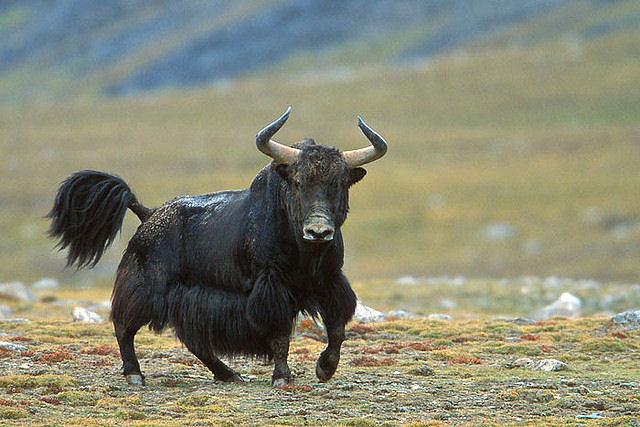
Abb.: Abb.: चमरः । Bos grunniens Przewalski, 1883 - Yak, Tibet
[Bildquelle:
flickker photos. --
http://www.flickr.com/photos/38504374@N02/3587889445/. -- Zugriff am
2011-01-01. --
Creative
Commons Lizenz (Namensnennung, keine kommerzielle Nutzung, keine
Bearbeitung)]
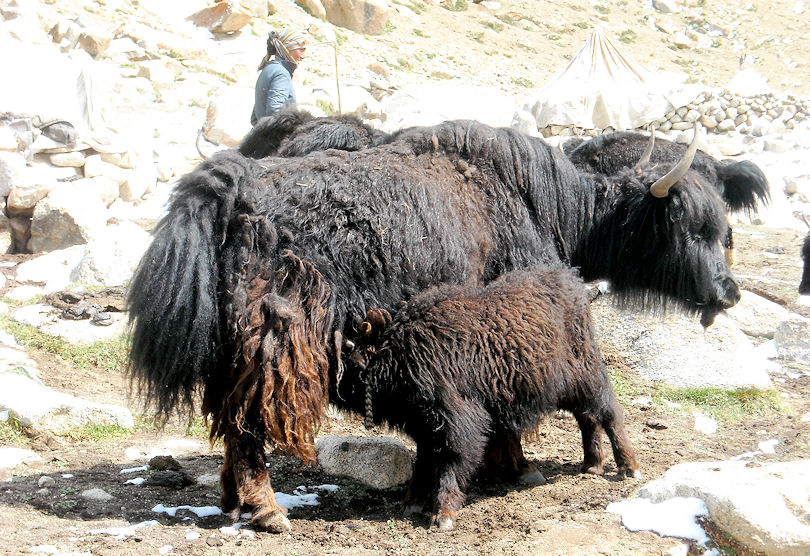
Abb.: Domestiziertes Bos grunniens Przewalski, 1883
- Yak, Ladakh -
ལ་དྭགས་
[Bildquelle:
Sistak. --
http://www.flickr.com/photos/94801434@N00/3841810762/. -- Zugriff am
2011-01-01. --
Creative Commons Lizenz (Namensnennung, share alike)]
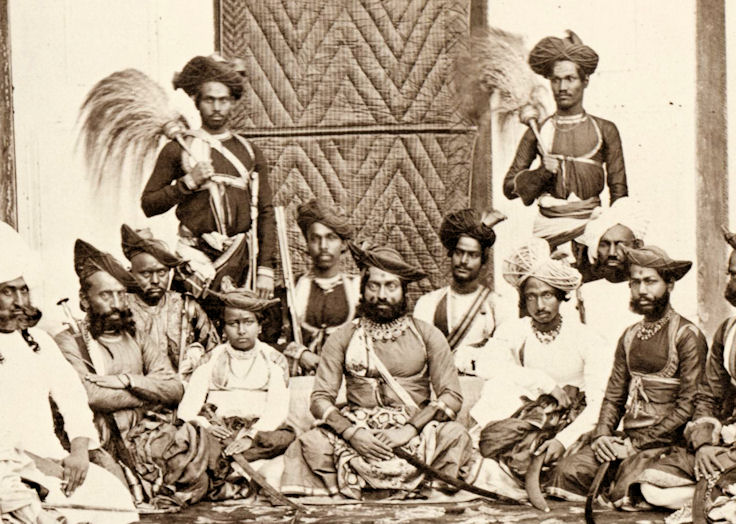
Abb.: Yak-Wedel, Sir Jayaji Rao Sindhia - जयजी राओ शिन्दि, Maharadscha von Gwalior
- ग्वालियर, 1882
[Bildquelle: Dayal, Raja Lala Deen <1884 - 1910>]
|
"Yak, as we have said, inhabit the plateau of
Tibet, probably extending northwards as far as the Kuen-Luen
range, while eastwards they range into the Chinese province of Kansu,
and westwards enter the eastern portions of Ladak, especially the
regions in the neighbourhood of the Chang-Chenmo valley and the great Pangkong
lake. The greater portion of the country comprised within this extensive area
is desolate and dreary in the extreme, but yak confine themselves to the wildest and
most inaccessible portions of these regions, and are found only at great
elevations, ranging in summer from about fourteen thousand to upwards of twenty
thousand feet, and perhaps even more, above the level of the sea. They are at all
times extremely impatient of heat, and delight in cold.
Habits. Writing of the yak, General Kinloch
observes that, "although so large a beast, it thrives upon the
coarsest pasturage, and its usual food consists of a rough wiry grass, which
grows in all the higher valleys of Tibet, up to an elevation of nearly twenty thousand
feet. On the banks of the streams in many places a more luxuriant grass is met
with, and it is particularly plentiful in the valleys of Chang-Chenmo and Kyobrung,
forming the attraction which entices the yak from the still wilder and
more barren country further north. Yak seem to wander about a good deal. In summer
the cows are generally to be found in herds varying in numbers from ten to one
hundred ; while the old bulls are for the most part solitary or in small parties of
three or four. They feed at night and early in the morning, and usually betake
themselves to some steep and barren hillside during the day, lying sometimes for hours in
the same spot. Old bulls in particular seem to rejoice in choosing a
commanding situation for their resting-place, and their tracks may be found on the tops of
the steepest hills, far above the highest traces of vegetation. The yak is
not apparently a very sharp-sighted beast, but its sense of smell is extremely
keen, and this is the chief danger to guard against in stalking it. In the high
valleys of Tibet, where so many glens intersect one another, and where the
temperature is continually changing, the wind is equally variable. It will
sometimes shift to every point of the compass in the course of a few minutes, and
the best-planned stalk may be utterly spoiled."
The yak found in the Chang-Chenmo valley are
chiefly or entirely stragglers from Chinese territory, and, owing to
incessant pursuit, very few are to be met with at the present day in these regions. Native
travellers report, however, that on the upper Indus, to the eastward of Ladak, yak
are to be found in vast numbers, and that there they do not exhibit the extreme
wariness characterising those which wander into Ladak. In Northern Tibet yak have
been also met with in great numbers by the Russian explorer, Prejewalski.
Here the old bulls were found alone, and the cows and younger males
generally in small herds ; although, where the pasture was good, the herds were
sometimes very large. These herds wandered more or less regularly over wide tracts of
country, and, according to native reports, were found in summer in grassy plains, where
they were quite unknown in winter. As in Southern Tibet, they were especially
partial to the tracts bordering the streams, where grass was more abundant than
elsewhere. On the other hand, the solitary bulls were reported to inhabit the
same districts throughout the year. Where the herds were largest, their numbers
are said to be reckoned by hundreds, and even thousands. When alarmed or expecting
danger, the cows and older bulls place themselves in the van and on the flanks
of the herds, with the calves in the centre ; but on the near approach of a hunter,
the whole herd will take to flight at a gallop, with their heads down and their
tails in the air. A wounded yak, whether cow or bull, will, according to
General Kinloch, not unfrequently charge.
A peculiarity of the yak is its grunting
voice, from which it derives its Latin title. Domestic yak are
kept by the inhabitants of the higher regions of Tibet as beasts of
burden, and for the sake of their flesh ; and are absolutely essential for crossing many
parts of that desolate region. Some of the pure-bred animals kept by the Tartar
tribes, living on the Rupsu plateau, to the south of the Indus in Ladak, are
magnificent beasts of large size and uniformly dark colour. When they have not been used for
a considerable period they are very wild, and apt to break loose and throw
their loads ; but after a few days' march they sober down. In other parts the yak
are smaller, and vary greatly in colour, being sometimes entirely white, while
the tail is very generally of that hue.
There are also many crosses between the yak
and ordinary cattle, some of the breeds being without horns. These half-breeds
have the advantage of being able to withstand much higher temperatures than
the pure yak ; and they may be met with carrying burdens in the hot valley of
the Indus, between the town of Leh and Kashmir.
Although yak are admirable beasts of burden
on account of their endurance and strength, and the facility with which
they will traverse glaciers and swim icy torrents, they have the great disadvantage
that they will not eat corn. This frequently necessitates the pushing on of the
party by forced marches to prevent their beasts from perishing of hunger. The
following description of a march with yak, for the truthfulness of which the
present writer can vouch from his own personal experience, is from the pen of
General Macintyre.
"For more than six weary hours," writes the general, "did we toil up against the almost blinding
snow and piercing wind that chilled us to the very
marrow, although the distance to the summit was only six or seven miles. It was
truly wonderful to see the way in which the yaks struggled through the deep
snow, and scrambled over places which were often difficult and sometimes dangerous
to traverse. Nothing could have exceeded the powers of endurance evinced by
these animals, which were game to the backbone, and as sure-footed as goats.
One of them, notwithstanding, lost its footing on a steep slope of névé, and
went rolling and sliding down until it was fortunately stopped by a friendly rock ;
otherwise it must have disappeared for ever under the glacier. On regaining its feet
the creature merely shook itself, and on being disentangled from its load soon
clambered up again."
All who have visited a Tibetan monastery, or
lamasery, must have been struck with the number of yak-tails suspended as
streamers from tall poles fixed in the ground before the entrance. The more general
use of these appendages throughout the East is, however, in the form of chowris,
or fly-whisks. For this purpose pure white tails are preferred ; and they are
frequently mounted with the twisted horn of a black-buck as a handle. In China
yak-tails dyed red are affixed to the roofs of the summer residences as pendants."
[Quelle: The new natural history / by Richard
Lydekker <1849 - 1915> ... -- New York, 189?. -- Vol. 2. -- S.
185ff.] |
2.9.19.13. Wild, für das ich keine eindeutige Zuordnung zu
obigen Sanskritbezeichnungen machen konnte
2.9.19.13.1. Hirsche, Moschushirsche, Hirschferkel
Hierher gehören u.a.:
Hirschferkel:
- Moschiola sp.
- Moschiola meminna Erxleben, 1777 - Indian Spotted Chevrotain (Indien, Sri Lanka),
jetzt aufgespaltet in:
- Moschiola indica Gray, 1843 - Indian Spotted Chevrotain
(Indien)
- Moschiola meminna Erxleben, 1777 - Sri Lankan Spotted
Chevrotain (Sri Lanka)
Moschus-Hirsche:
- Moschus sp. - Moschushirsch - Musk Deer
- Moschus leucogaster Hodgson, 1839 - Himalaya-Moschushirsch -
Himalayan Musk Deer (Nepal)
Hirsche:
- Muntiacus sp. - Muntjacs, or Barking Deers
- Muntiacus muntjak Zimmermann, 1780 - Red Muntjak
(Nordost-Pakistan, Indien, Nepal, Sri Lanka)
- Axis sp. - Axis Deer
- Axis axis Erxleben, 1777 - Axishirsch - Chital (Spotted Deer)
(Indien, Nepal, Sri Lanka)
- Axis porcinus Zimmermann, 1780 - Schweinshirsch - Hog Deer
(Pakistan, Nordindien)
- Cervus sp. - Red Deer
- Subgenus Rusa
- Rusa unicolor Kerr, 1792 - Sambar (Indien, Sri Lanka)
- Subgenus Rucervus
- Rucervus duvaucelii G.
Cuvier, 1823 - Barasingha / Zackenhirsch - Barasingha (Swamp Deer) (Pakistan,
Indien, Nepal)
- Rucervus eldii M'Clelland,
1842 - Leierhirsch - Eld's Deer (Thamin) (Assam)
Cervus elaphus hanglu Wagner, 1844
- Kaschmirhirsch - Hangul
Schulterhöhe: 120 - 125 cm
Gewicht: bis 180 kg
Lebensraum: Kashmir Tal, Himachal Pradesh, 1500 - 3600 m ü. M.
Noch in Freiheit lebende Individuen: ca. 200 - 400
Lebt in Herden von 2- 8 (Sommer) bzw. 20 - 30 (Winter) Tieren
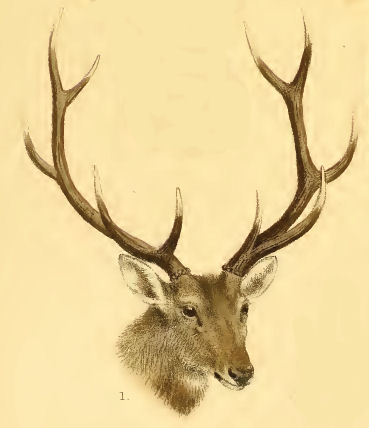
Abb.: Cervus elaphus hanglu Wagner, 1844
- Kaschmirhirsch - Hangul
[Bildquelle: Lydekker, Richard <1849 - 1915>:
The great and small game of India, Burma, & Tibet. --
London, 1900. -- Pl. 6]
|
"The Barasingha of Kashmir, as it is always
called by sportsmen (and generally by the native shikarees also), is
only found, within our limits, in Kashmir, where it inhabits the magnificent
pine forests, usually at a height in summer of 9,000 to 12,000 feet, but
descending much lower in autumn and winter. Most of the individuals of
this deer have shed their horns before the time when Europeans are
allowed to enter Kashmir, viz., 15th April, and many have the new horns
perfect early in October, at which time the rutting season commences, and
the stags may be heard bellowing in the woods all daylong, and they
are then easily stalked. The females give birth to their young in April,
and the young are spotted.
This stag is found throughout great part of
Western and Central Asia, and has been found as far as the eastern
shores of the Euxine Sea. It is common in some parts of Persia, where called
Maral, and it was long ago described by Pallas as the C. elaphus. He
stated that it appeared to be larger than the European stag, and that it
was very abundant in Caucasus in the woods at the foot of the Altai
mountains, round Lake Baikal, and on the river Lena.
Specimens of this deer are living in the
gardens of the Zoological Society, London, and the female has bred there."
[Quelle:
Jerdon, Thomas Claverhill <1811-1872>: The mammals of India : a
natural history of all the animals known to inhabit continental
India. -- London, 1874. -- S. 251.] |
Rucervus eldii M'Clelland,
1842 - Leierhirsch - Eld's Deer (Thamin)
Schulterhöhe: 105 - 120 cm
Gewicht: 170 kg
Lebensraum: Lake Loktak (Manipur)
Noch in Freiheit lebende Individuen: ca. 100
Lebt in kleinen Herden
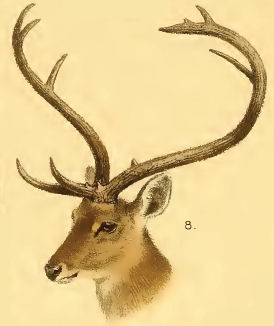
Abb.: Rucervus eldii M'Clelland,
1842 - Leierhirsch - Eld's Deer (Thamin)
[Bildquelle: Lydekker, Richard <1849 - 1915>:
The great and small game of India, Burma, & Tibet. --
London, 1900. -- Pl. 6]
Muntiacus muntjak Zimmermann, 1780 - Red Muntjak
Schulterhöhe: 50 - 75 cm
Gewicht: 14 - 28 kg
Lebensraum: ganz Indien (außer Jammu und Kashmir, Trockengebiete Gujarats und
Rajasthans), bis 2500 m ü. M.
Noch in Freiheit lebende Individuen: unbekannt
Lebt als Einzelgänger bzw. in Paaren
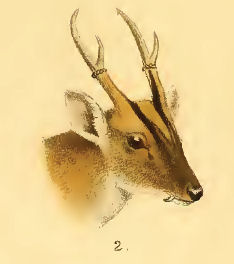
Abb.: Muntiacus muntjak Zimmermann, 1780 - Red Muntjak
[Bildquelle: Lydekker, Richard <1849 - 1915>:
The great and small game of India, Burma, & Tibet. --
London, 1900. -- Pl. 7]

Abb.: Muntiacus muntjak Zimmermann, 1780 - Red Muntjak, Kanha National Park - कान्हा
राष्ट्रीय उद्यान, Madhya Pradesh
[Bildquelle: Niranj Vaidyanathan. --
http://www.flickr.com/photos/jnarin/4325797894/. -- Zugriff am 2010-12-16.
-- Creative
Commons Lizenz (Namensnennung, keine kommerzielle Nutzung, keine
Bearbeitung)]
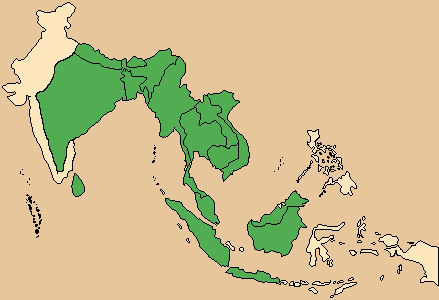
Abb.: Lebensraum von Muntiacus sp.
[Bildquelle: Pratheepps / Wikipedia. --
Creative Commons
Lizenz (Namensnennung, share alike)]
|
"The Rib-faced deer is found in all the thick
jungles and forests of India, from the extreme south to the Himalayas, and
from a low level to 8,000 or 9,000 feet in the Himalayas. It is most
abundant in hilly countries, and it is quite a forest animal, only coming
to the skirts of the woods morning and evening to graze. It is a
solitary animal, very rarely even two being found together. It carries its head
and neck low, and as its hind quarters are high, its action in running
is peculiar, and not very elegant, somewhat resembling the pace of a
sheep ; hence its popular but very erroneous name in Southern India. "It
has," says Hodgson, "no powers of sustained speed and extensive leap,
but is unmatched for flexibility and power of creeping through tangled
underwood. They have, indeed, a weasel-like flexibility of spine and limbs,
enabling them to wend on without kneeling, even when there is little
more than 6 inches (?) of perpendicular passage-room ; thus escaping their great
enemy the wild dog."
In the Himalayas, near Darjeeling, two or
three bowmen, with three or four common hill dogs, will often chase one
to death in an hour or so. I have seen it hunted with foxhounds on the
Neelgherries, and run down with tolerable ease, the woods there being
very open ; and if it be driven out of the woods, a greyhound will quickly
pull it down. It is easily stalked, and on the Himalayas many are killed
during the winter, when the snow is on the ground. It gets its name
of barking deer from its call, which is a kind of short bark like that
of the fox, but louder, and it may be heard in the jungles it frequents
both by day and by night. Colonel Markham says that, "as it runs, a curious rattling noise may often be heard, like that from two pieces of
loose bone knocked together sharply." It is excellent venison, but rarely
carries any fat.
Its tongue is very long and extensile, and it
often licks its whole face with it. Hodgson states that the
vertebrae of the back and neck are very mobile, and the spinous processes of
the dorsal vertebrae are unusually short and of uniform, height the
humerus and femur are nearly as long respectively as the radius and
ulna, and the metacarpus and metatarsus are short."
[Quelle:
Jerdon, Thomas Claverhill <1811-1872>: The mammals of India : a
natural history of all the animals known to inhabit continental
India. -- London, 1874. -- S. 265f.] |
2.9.19.13.2. Wildziegen, Wildschafe, Ziegenantilopen
Hierher gehören u.a.:
- Capricornis sp. - Serows
- Capricornis sumatraensis Bechstein, 1799 -
Sumatran Serow (Himalayagebiet, Assam, Bangladesh)
- Naemorhedus sp. Gorals
- Naemorhedus goral Hardwicke, 1825 - Grauer Goral -
Himalayan Goral (Himalayagebiet von Nordpakistan bis Assam)
- Budorcas sp. - Takin
- Budorcas taxicolor Hodgson, 1850 - Takin - Takin (Nord-Assam)
- Hemitragus sp. - Tahrs
- Hemitragus jemlahicus C. H. Smith, 1826 - Himalaya-Tahr -
Himalayan Tahr (Himalayagebiet)
- Hemitragus hylocrius Ogilby, 1838 - Nilgiri-Tahr - Nilgiri
Tahr (Nilgiri und Rangebirge)
- Capra sp. - Goats
- Capra hircus aegagrus Eixleben, 1777 - Wildziege - Wild Goat
(Pakistan)
- Capra ibex Linnaeus, 1758 - Steinbock - Alpine Ibex (Nordindien)
- Capra falconeri Wagner, 1839 - Schraubenziege - Markhor
(Nord- und Zentralpakistan, Kashmir)
- Ovis sp. - Schaf - Sheep
- Ovis aries vignei Blyth, 1841 - Urial (Pakistan)
- Ovis ammon Linnaeus, 1758 - Riesenwildschaf - Argali (Kashmir,
nördlichstes Indien, Nepal)
Budorcas taxicolor Hodgson, 1850 - Takin - Takin
Schulterhöhe: 110 - 130 cm
Gewicht: 200 - 300 kg
Lebensraum: Bambus- und Rhododendron-Dickicht, besonders an Steilhängen in den
Mishmi Hills, Arunachal Pradesh; 2100 - 3000 m ü. M.
Noch in Freiheit lebende Individuen: unbekannt
Lebt in Gruppen von 10 bis über 20
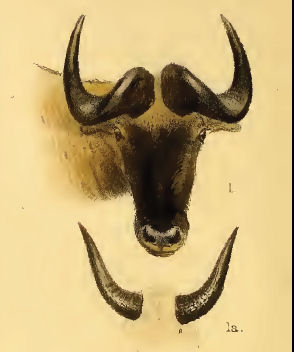
Abb.: Budorcas taxicolor Hodgson, 1850 - Takin - Takin
[Bildquelle: Lydekker, Richard <1849 - 1915>: The great and small game of India, Burma, & Tibet. --
London, 1900. -- Pl. 5]
Capricornis sumatraensis Bechstein, 1799 -
Sumatran Serow
Schulterhöhe: 90 - 110 cm
Gewicht: 60 - 140 kg
Lebensraum: Himalaya von Jammu und Kashmir bis Arunachal Pradesh, Manipur,
Mizoram, Nagaland, Meghalaya
Noch in Freiheit lebende Individuen: unbekannt
Lebt alls Einzelgänger bzw.in Gruppen von 2 - 5 Tieren
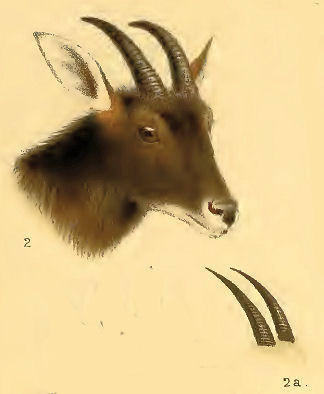
Abb.: Capricornis sumatraensis Bechstein, 1799 -
Sumatran Serow
[Bildquelle: Lydekker, Richard <1849 - 1915>: The great and small game of India, Burma, & Tibet. --
London, 1900. -- Pl. 5]
Naemorhedus goral Hardwicke, 1825 - Grauer Goral -
Himalayan Goral
Schulterhöhe: 65 - 70 cm
Gewicht: 25 - 35 kg
Lebensraum: Steilhänge im Himalaya, Nagaland, Manipur, Mizoram
Noch in Freiheit lebende Individuen: unbekannt
Lebt in Gruppen von 5 - 10; Männchen als Einzelgänger

Abb.: Naemorhedus goral Hardwicke, 1825 - Grauer Goral -
Himalayan Goral
[Bildquelle: Lydekker, Richard <1849 - 1915>: The great and small game of India, Burma, & Tibet. --
London, 1900. -- Pl. 5]
|
"The Gooral is very caprine in appearance, the
back is somewhat arched and the limbs are stout and moderately long,
and it is well adapted both for climbing and jumping. It inhabits the
whole range of Himalayas from Bhotan and Sikim to Kashmir, at a range
varying from a little above 3,000 to nearly 8,000 feet, though
perhaps most common about 5,000 to 6,000 feet. It usually associates in
small parties of from four to eight or so, and frequents rugged grassy
hills, or rocky ground in the midst of forests. If one Gooral is seen, you may be
pretty certain that others are not far off, and they rarely or never
forsake their own grounds. If cloudy, they feed at all hours, otherwise
only morning and evening. When alarmed it gives a short hissing snort, which
is answered by all within hearing. The female breeds in May and June,
gestating for six months, and brings forth her young amid crags and
rocky recesses.
Being generally found in somewhat broken
ground, it is easily stalked; and as it is to be found close to most of our
hill sanataria, it is generally the first game obtained by the sportsman on
the hills.
Blyth states that those from Assam or Bhotan are very
ruddy in tint."
[Quelle:
Jerdon, Thomas Claverhill <1811-1872>: The mammals of India : a
natural history of all the animals known to inhabit continental
India. -- London, 1874. -- S. 287f.] |
Hemitragus jemlahicus C. H. Smith, 1826 - Himalaya-Tahr -
Himalayan Tahr
Schulterhöhe: 80 - 100 cm
Gewicht: 60 - 100 kg
Lebensraum: bewaldete Steilhänge im Himalaya von Jammu und Kashmir bis Sikkim,
2500 - 4400 m ü. M.
Noch in Freiheit lebende Individuen: unbekannt
Lebt in Herden von 10 - 15 Tieren
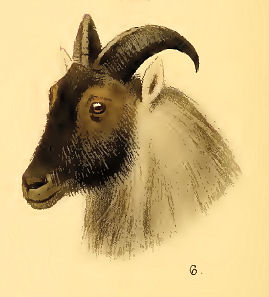
Abb.:
Hemitragus jemlahicus C. H. Smith, 1826 - Himalaya-Tahr -
Himalayan Tahr
[Bildquelle: Lydekker, Richard <1849 - 1915>: The great and small game of India, Burma, & Tibet. --
London, 1900. -- Pl. 4]
|
"The Tēhr is found throughout the whole extent
of the Himalayas, only however at great elevations, generally
above the limits of forest, and not far from the snow. It frequents rocky
valleys, and very steep and precipitous rocky ground, and is often seen
perched on what appear to be inaccessible crags. It feeds on the grassy
spots among rocks, and though not unfrequently found solitary, is
more generally seen in flocks, sometimes as numerous as 20, 30, or even 40,
it is said. If alarmed whilst feeding, they all go off at speed with a
clattering sound, but soon halt to gaze on the intruder. They generally follow
the guidance of an old male, and will make their way up almost
perpendicular precipices if there be but a few rough edges, or crevices. In the
north-west, they are said to be sometimes seen along with Marhkor. Captain
E. Smyth states that "the males herd separately from February
till October, ascend to a much greater height than the females and very
young males, and are very difficult to find. In March and April they
chiefly frequent the forests. During the rutting season the males are
always fighting, and numbers are killed by falling down the crags."
Colonel Markham says that "the Tahir in
general haunts the rocky faces and grassy slopes of hills free from
forest, but occasionally one will be found in a patch of forest. Seen at a
distance, it looks like a great wild hog, but when near it is a noble beast.
One shot fell 80 yards perpendicular without touching, rebounded and
fell again 15 yards more; he got up, went off and was lost. The flesh
of the female is tolerable ; that of the male scarcely eatable at any
time."
It is bold and pugnacious, but easily tamed.
It is living in the Zoological Gardens, in London, and has been beautifully
figured by Wolf.
Hodgson relates that a male Jhāral at Nepal
had intercourse with a female spotted deer, which produced a hybrid
of mixed appearance, more like the mother than the father, which lived
and grew up a fine animal.
The name Jemlaica (I may state) is taken from
the Jūmla valley, north of Nepal."
[Quelle:
Jerdon,
Thomas Claverhill <1811-1872>: The mammals of India : a natural history of
all the animals known to inhabit continental India. -- London, 1874. -- S.
287f.] |
Hemitragus hylocrius Ogilby, 1838 - Nilgiri-Tahr - Nilgiri
Tahr
Schulterhöhe: 100 - 110 cm
Gewicht:
Lebensraum: West-Ghats, Nilgiris (நீலகிரி
/ നീലഗിര /
ನೀಲಗಿರಿ),
Anamalai Hills (ஆனைமலை
/ ആനമല),
1200 - 2600 m ü. M.
Noch in Freiheit lebende Individuen: ca. 2500
Lebt in Herden von 10 - 15, manchmal bis 100
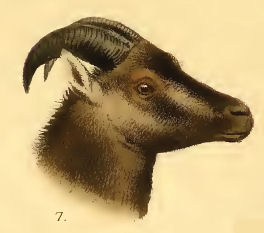
Abb.:
Hemitragus hylocrius Ogilby, 1838 - Nilgiri-Tahr - Nilgiri Tahr
[Bildquelle: Lydekker, Richard <1849 - 1915>: The great and small game of India, Burma, & Tibet. --
London, 1900. -- Pl. 4]
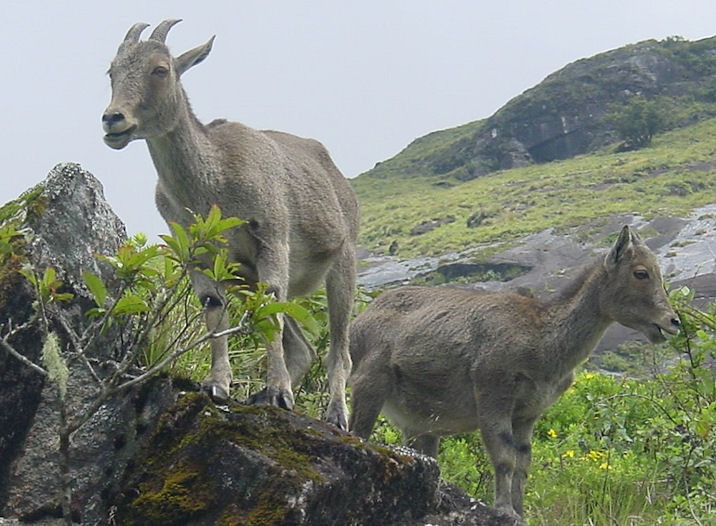
Abb.:
Hemitragus hylocrius Ogilby, 1838 - Nilgiri-Tahr - Nilgiri Tahr, Nilgiris
(நீலகிரி
/ നീലഗിര /
ನೀಲಗಿರಿ)
[Bildquelle: Rajeshdxb / Wikimedia. -- Public domain]
|
"This wild goat was first described by Gray
from a drawing and notes of General Hardwicke, and it was said to have
been sent from Nepal and from Chittagong. This is of course
erroneous. It has hitherto only been found on the Neelgherry and
neighbouring hills, extending south along the Western Ghats nearly to Cape
Comorin. The specific name given by Gray is the Tamul word
for rock- or precipice-goat. It is called an Ibex by sportsmen in Madras.
It chiefly frequents the northern and western slopes of the
Neelgherries, where the hills run down in a succession of steep stony
slopes or rocky ridges, to the high table-land of Mysore and the Wynaad,
both of which districts are themselves hilly. It has also been seen
on several rocky hills in the interior of the plateau,
especially near the so-called Avalanche hill. It is occasionally seen on
the summit of the northern and western faces, but more generally some
distance down, at an elevation of 4,000 to 6,000 feet; and, if carefully
looked for, the herd may be seen feeding on an open grassy glade at the
foot of some precipice. I have seen above twenty individuals in a flock
occasionally, but more generally not more than six or seven. With
the large herds there is almost always one very large old male, conspicuous
by his nearly black colour. If alarmed or followed, they rush rapidly down
hill, and are lost to sight among the inequalities of the ground, or go
straight down to the hilly country at the foot of the slopes. Now and
then they have been known to take shelter in woods, through which they
will freely pass if followed. They are very wary animals, and from the
limited extent of the Neelgherries have been so much hunted there, that it is
difficult (I am told) to get a near shot at them at present. The
female is said to produce two young at a birth.
Besides the Neelgherries, this wild goat
occurs in the rocky ranges south of these hills, on the Animallies, and
along the range of Western Ghats, nearly, I have been informed, to Cape
Comorin. It has not been observed in Ceylon. I have no doubt also of
its being the wild sheep, so called, of the highlands of Madura, and of
the neighbouring Pulney hills, as I long ago heard of the Neelgherry
Ibex having been killed near Madura and Dindigul.
The Rev. Mr. Baker, in sending a fine skull
and horns from the Western Ghats inland from Cochin, to Mr.
Blyth, wrote as follows : "The animal when alive was as large as an ordinary
donkey, and so heavy that six men could with difficulty bring him in.
They are very numerous, feeding like a flock of sheep on the
hill-tops, and only flee to the precipices when alarmed. They will even hide in jungle
and grass. There is a solitary Roman Catholic church on a rock in the
jungles, on the borders of Travancore and Cochin, where the wild 'Ibex' are
common, and though numbers of people go there on pilgrimage,
these 'ibex' walk about among them, and eat the sesamum-seed given
them, but do not allow themselves to be touched. They are considered
holy and belonging to the Church." Elsewhere the same observer, writing
of the game animals of the Western Ghats, remarks that, "if the
mountains are at all rocky and precipitous, you will find the wild goat
or Ibex close to the rocks, often in large herds." As an article of
provender, Mr. Baker remarks that "a quarter of ibex hung, as the country
people in the mountains do at home, within a wire or muslin bag, and
exposed to the air, is equal to Welsh mutton."
Baikie, in his work on the
Neelgherries,
stated that the Neelgherry Ibex had very large knotted horns, and a long
black or brown beard. Lieut. Beagin also informed Mr. Blyth that the "Ibex"'
of the Neelgherries had a considerable beard; and on my first visit to
the Neelgherries I was told by more than one good sportsman that the male
had a beard. Yet no specimen that I ever saw (though some were very old)
had a vestige of a beard ; and I imagine that the preconceived idea of
the Ibex had involuntarily deceived the observers into believing that
those they saw had beards.
There are no other species of this strictly Indian genus."
[Quelle:
Jerdon,
Thomas Claverhill <1811-1872>: The mammals of India : a natural history of
all the animals known to inhabit continental India. -- London, 1874. -- S. 289f.] |
Capra falconeri Wagner, 1839 - Schraubenziege - Markhor
Schulterhöhe: 80 - 100 cm
Gewicht: 90 - 100 kg
Lebensraum: Jammu und Kashmir
Noch in Freiheit lebende Individuen: unter 250
Lebt in Herden von 5 - 10
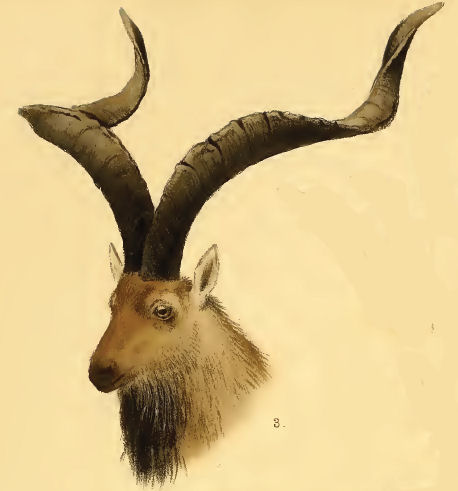
Abb.: Capra falconeri Wagner, 1839 - Schraubenziege - Markhor
[Bildquelle: Lydekker, Richard <1849 - 1915>: The great and small game of India, Burma, & Tibet. --
London, 1900. -- Pl. 4]
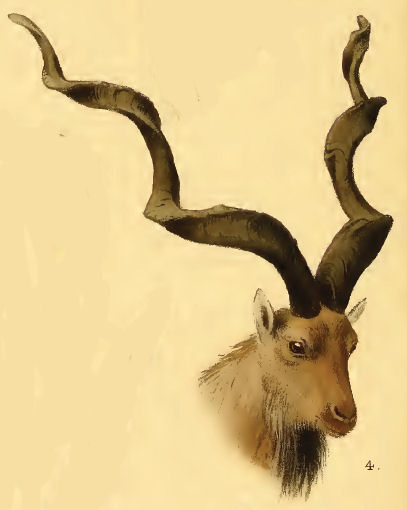
Abb.: Capra falconeri Wagner, 1839 - Schraubenziege - Markhor
[Bildquelle: Lydekker, Richard <1849 - 1915>: The great and small game of India, Burma, & Tibet. --
London, 1900. -- Pl. 4]
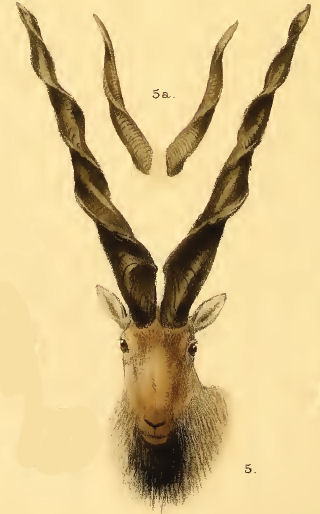
Abb.: Capra falconeri Wagner, 1839 - Schraubenziege - Markhor
[Bildquelle: Lydekker, Richard <1849 - 1915>: The great and small game of India, Burma, & Tibet. --
London, 1900. -- Pl. 4]
|
"This magnificent wild goat is found on the
Pir Panjal range of the Himalayas, to the south of the valley of
Kashmir, in the Hazara hills, and the hills on the north of the Jhelum, and in
the Wurdwan hills separating the Jhelum from the Chenab river ; not
extending, it is stated, further east than the sources of the Beas river, and
certainly very rare further east than the Wurdwan hills. It is also
abundant on all the hills to the west of the Indus, the Sulimani range as far
south as the junction of the Sutlej with the Indus, and extending north
into Afghanistan. It is also found in Ladak, but not apparently further
east.
The Markhor associates in small herds,
frequenting steep and rocky hills above the forest region in summer, but
in winter descending to the bare spots in the wooded regions. It is much
sought after by sportsmen, and the horns considered a great trophy.
A male Markhor is now living in the
Zoological Gardens, at London, and has bred with the common goat."
[Quelle: Jerdon,
Thomas Claverhill <1811-1872>: The mammals of India : a natural history of
all the animals known to inhabit continental India. -- London, 1874. -- S.
291f.] |
Capra ibex Linnaeus, 1758 - Steinbock - Alpine Ibex
Schulterhöhe: 80 - 100 cm
Gewicht: 90 kg
Lebensraum: oberhalb der Baumgrenze in Himachal Pradesh und Ladakh
Noch in Freiheit lebende Individuen: 15.000 - 20.000
Lebt in Herden von 12 - 50 Tieren
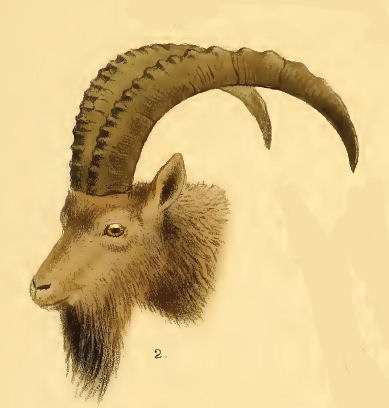
Abb.: Capra ibex Linnaeus, 1758 - Steinbock - Alpine Ibex
[Bildquelle: Lydekker, Richard <1849 - 1915>: The great and small game of India, Burma, & Tibet. --
London, 1900. -- Pl. 4]
|
"The Himalayan Ibex is found throughout the
Himalayas from Kashmir to Nepal, at all events. In the west of
Kashmir it is rare, and is not found, it is asserted, to the west of the Jhelum
river, the Markhor, which has its eastern limit in Kashmir, taking its place.
It is found, however, in the Pir Panjal range, and a few in the range of
hills north of Baramulla ; and more numerous in the Wurdwan ranges, east of
Kashmir ; it is abundant in parts of Kunawur, on some of the ranges on
both sides of the Sutlej ; and also near the source of the Ganges,
where, however, it is rare. It occurs in many other localities on the south
side of the great Himalayan chain, and is not restricted, as stated, to
the Tibetan slopes of the Himalayas ; where, however, it is more
numerous than in the ranges to the south. It extends through Central Asia
to Siberia.
The Himalayan Ibex is "agile and graceful in its movements," says Colonel Markham, "and frequents the highest
ground near the snows where food is to be obtained. The sexes live
apart generally, often in flocks of one hundred and more. In October
the males descend and mix with the females, which have generally
twins in June and July. It is an exceedingly wary and timid animal, and
can make its way in an almost miraculous manner over the most
inaccessible-looking ground. No animal excels the Ibex in endurance and
agility."
Adams states that many are killed by
avalanches, and that they are much preyed on by the Panther (i.e. the Ounce). He also states that the female has in general only one kid.
I have only seen the Ibex near Chini, in the
Sutlej valley. In some of the villages high up the valleys there, many
are killed every year during the winter, and their horns may be seen hung
up on all the temples. Mr. Vigne states that one or two hundred are
killed yearly in Balti, in winter, when forced to descend to the
valleys. In Ladak they are snared at night, and shot in the gray dawn of the
morning when they venture down to the streams to drink, They are killed
for the sake of the soft under-fleece, which, in Kashmir, is called Asali tūs. This is used as a lining for shawls, for stockings, gloves, and
is woven into the fine cloth called Tūsi. No wool is so rich, so soft,
and so full. The hair itself is manufactured into coarse blanketing for tents,
and twisted into ropes.
A skin of an ibex killed in the Balti valley
by Major Strutt, B.A., was much darker than any I have seen. Its
general colour was a rich hair-brown, with a yellowish-white saddle on the middle
of the back, and a dark mesial line ; the head, neck, and limbs
were dark rich glossy sepia-brown, with a still darker central line
on the front of the legs ; the belly was brown, grizzled with
yellowish-white. Others were seen by Major Strutt in the same locality yet darker.
The horns did not appear to differ from those of individuals of the
ordinary colour. Major Strutt, who has shot many in different parts
of the hills, never saw any of the dark race except in Balti."
[Quelle: Jerdon,
Thomas Claverhill <1811-1872>: The mammals of India : a natural history of
all the animals known to inhabit continental India. -- London, 1874. -- S.
292f.] |
Ovis aries vignei Blyth, 1841 - Urial (Sha)
Schulterhöhe: 70 - 90 cm
Gewicht: 35 - 90 kg
Lebensraum: Alpine Wiesen oberhalb der Baumgrenze in Ladakh, Karakoram, Gilgit,
Skardu
Noch in Freiheit lebende Individuen: ca. 1500
Lebt in Herden von 10 - 30 Tieren, Männchen zu 2 - 3 Tiere
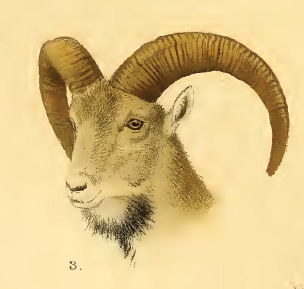
Abb.: Ovis aries vignei Blyth, 1841 - Urial
[Bildquelle: Lydekker, Richard <1849 - 1915>: The great and small game of India, Burma, & Tibet. --
London, 1900. -- Pl. 3]
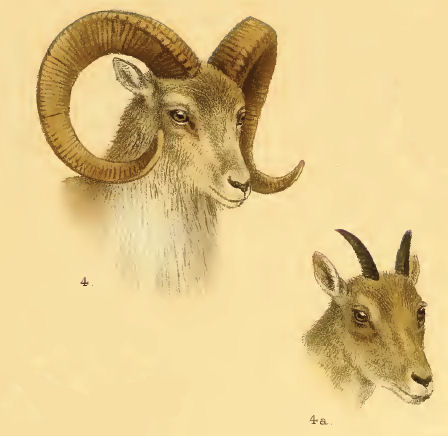
Abb. Ovis aries vignei Blyth, 1841 - Urial
[Bildquelle: Lydekker, Richard <1849 - 1915>: The great and small game of India, Burma, & Tibet. --
London, 1900. -- Pl. 3]
|
"This wild sheep was formerly confounded with
an allied species, Ovis Vignei of Blyth, found only in highly
elevated districts. Living specimens of the Punjab sheep having been presented to
the London Zoological Gardens, the distinctions were seen and
pointed out by Sclater, who restored the name Hutton had long previously
given it, but which I think he evidently applied to both races. The
Oorial is found over the whole Salt range of the Punjab, on the Sulimani range
across the Indus, the hills of the Hazara, and those in the vicinity of
Peshawur. In most of these localities it occurs at a very low elevation,
from 800 feet to 2,000 feet, and rarely 3,000 feet, and it is therefore
capable of enduring great heat, and is fully entitled to be included in the
strictly Indian Fauna.
Small flocks of the Oorial may be seen not
far from Jhelum. They frequent the rocky and stony hills, and are
wary and shy ; but from the nature of the ground are not very difficult
to stalk. The male has a loud shrill whistle, which he sounds as an alarm,
and their usual call is a sort of bleat. They rut in September, and have
generally twins. Seen at a little distance, the Oorial is a game-looking animal,
looking more like an antelope than a sheep, and it is very speedy
and active over rocky and stony ground. Hutton remarks that it
possesses "a moderate-sized lachrymal sinus, which appears to secrete, or
at all events contains, a thick gummy substance of good consistency and
of a dull grayish colour. The Afghan and Belooch hunters make
use of this gum, by spreading it over the pans of their
matchlocks, to prevent the damp from injuring the priming."
The nearly allied Ovis Vignei, Blyth, is the
Sha-poo or Shā of Tibet and Ladak, Ovis montana apud Cunningham, and
is not found in general below 12,000 feet of elevation in summer. It
is found in the Hindoo Koosh, the Pamir range, and west as far as
the Caspian Sea ; also in Ladak. Further east it is replaced by the
next species. In this the horns are more strongly wrinkled, curve
outwards and backwards, with divergent points, and do not tend to form so
complete a circle as in cydoceros. The colour of the sheep is
brownish- or reddish-gray, and its beard is short. The suborbital pits are
smaller, deeper, and more rounded in cydoceros ; the nasal bones are
shorter ; and the series of molar teeth is also shorter than in O. Vignei."
[Quelle: Jerdon,
Thomas Claverhill <1811-1872>: The mammals of India : a natural history of
all the animals known to inhabit continental India. -- London, 1874. -- S.
295f.] |
Ovis ammon Linnaeus, 1758 - Riesenwildschaf - Argali
Schulterhöhe: 110 - 120
Gewicht: 100 - 140 kg
Lebensraum: Ladakh, Sikkim, Hunza (Pakistan)
Noch in Freiheit lebende Individuen: ca. 250
Lebt in Herden von 12 - 100 Tieren, Männchen zu 2 - 5 Tiere

Abb.: Ovis ammon polii Blyth, 1841 - Marco
Polo's Sheep
[Bildquelle: Lydekker, Richard <1849 - 1915>: The great and small game of India, Burma, & Tibet. --
London, 1900. -- Pl. 3]
|
"Another wild Asiatic sheep is Ovis Polii,
Blyth, found on the elevated plains of Pamir, east of Bokhara, 16,000 feet
high. This magnificent wild sheep has immense horns, less massive
but more prolonged than those of the rocky mountain sheep. The horns
of one specimen were 4 feet 8 inches in length round the curvature,
and 14 1/4 inches in circumference at their base. It is the Rass or Roosh of Pamir."
[Quelle: Jerdon,
Thomas Claverhill <1811-1872>: The mammals of India : a natural history of
all the animals known to inhabit continental India. -- London, 1874. -- S. 299.] |
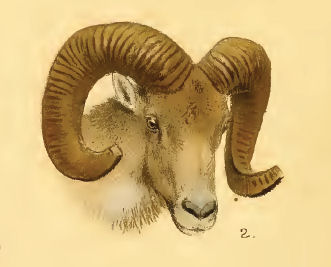
Abb.: Ovis ammon hodgsonii Blyth 1841 -Tibetan Argali
[Bildquelle: Lydekker, Richard <1849 - 1915>: The great and small game of India, Burma, & Tibet. --
London, 1900. -- Pl. 3]
|
"This splendid sheep is never perhaps seen in
summer lower than 15,000 feet of elevation, and is often found much
higher in the midst of the snows, being often snowed up in winter for many days,
and many perish yearly from this cause. It lives in flocks, the
males and females generally apart. They run and leap like deer, it is said, but
are not adapted for rocky ground, and as climbers are inferior to the
Burrel. It is the shiest and wildest of all animals, and is very hard to
kill. To shoot the Ovis Ammon is the greatest ambition of the sportsman on
the Himalayas.
Cunningham states that the horns along with
those of Ibex and the Sha (O. Vignei), are placed on the religious
piles of stones met with in Ladak and in other Buddhist countries."
[Quelle: Jerdon,
Thomas Claverhill <1811-1872>: The mammals of India : a natural history of
all the animals known to inhabit continental India. -- London, 1874. -- S.
299] |
Pseudois nayaur Hodgson, 1833 - Blauschaf - Bharal (Blue Sheep)
Schulterhöhe: 80 - 90 cm
Gewicht: 40 - 70 kg
Lebensraum: oberhalb der Baumgrenze in Ladakh, Kumaon bis Arunachal Pradesh,
3500 - 5500 m ü. M.
Noch in Freiheit lebende Individuen: ca. 10.000
Lebt in Herden von 10 bis über 50 Tieren, Männchen zu 4 - 5 Tiere
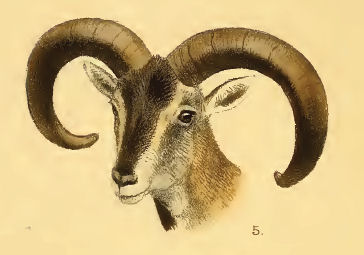
Abb.: Pseudois nayaur Hodgson, 1833 - Blauschaf - Bharal (Blue Sheep)
[Bildquelle: Lydekker, Richard <1849 - 1915>: The great and small game of India, Burma, & Tibet. --
London, 1900. -- Pl. 3]
|
"The Burrel, or blue wild sheep, is found from
Sikim, and probably Bhotan, to near Simla, but not extending further west
than the valley of the Sutlej, its place being taken to the north
and west by Ovis Vignei. It is found on this side the great Snowy range at
the head of the Tonse river, in the Buspa valley, near the source of the
Ganges, and still more abundant eastward in Kumaon and Gurhwal, in the
ranges between the Pindar and Bhagirutty rivers. It is found at great
elevations, from the limits of forest to the extreme limits upwards of
vegetation, in summer generally keeping to the tops of the hills, and even in
winter rarely descending below the forests.
These animals prefer grassy slopes to rocky
ground, and associate in flocks of various size, from four or five to
fifty, or even a hundred. They are timid and watchful, one or more being
always on the look-out, and giving a sharp shrill whistle on being
alarmed ; but they do not heed noises much, not even the report of a gun if
the shooter is concealed. Early in the spring is the best time to shoot
them, as the supply of grass being then small, their ground is more
limited, and they are obliged to feed all day; later in the season they
only feed morning and evening. The males and females sometimes
associate all the year round, but generally large flocks of both sexes are
met with separately, especially in summer. They lamb in June and
July, commonly producing two young.
When in rocky ground, there are few animals "which appear to move with more ease and facility. On the faces of
almost perpendicular cliffs of the wildest character, it leaps from rock to
rock with scarce an apparent effort. In winter, when snowed in, they
actually browse the hair off each others' bellies, many together having retired
under the shelter of some overhanging rock, from which they come out wretchedly
poor."
The same sportsman, writing of the supposed
difference between the Ovis Nahoor and O. Burhel, states that, near
Gangootrie, he saw some sheep which appeared to differ slightly from the
others, being apparently shorter, more bulky and stouter, particularly about
the head and neck, and the horns shorter and more curved : on the same
hills he saw females without horns. The shikarees called them Moossa menda,
to distinguish them from the common Menda or Burrel.
The Burrel gets very fat in September and
October, and is most excellent eating."
[Quelle: Jerdon,
Thomas Claverhill <1811-1872>: The mammals of India : a natural history of
all the animals known to inhabit continental India. -- London, 1874. -- S.
297f.] |
2.9.20 Gandharva
| 11. a./b. gandharvaḥ
śarabho rāmaḥ sṛmaro gavayaḥ śaśaḥ
गन्धर्वः शरभो रामः सृमरो गवयः शशः
।११ क।
गन्धर्व
- gandharva m.: Gandharva m. |
Colebrooke (1807): "Some make this the musk deer."
PW: "Nach den Erklärern Bisamtier [= Moschushirsch]. Bei dieser Bedeutung ist
man ohne Zweifel von gandha Geruch ausgegangen."
gandharva m.: bedeutet aber auch "Pferd" (gandharvī gilt als Stammmutter der
Pferde). Gandharva hier also = Wildpferd ?
| "Gandharva.
The heavenly Gandharva of the
Veda was a deity who knew and revealed the secrets of
heaven and divine truths in general. He is thought by
Goldstücker to have been a personification of the fire
of the sun. The Gandharvas generally had their dwelling
in the sky or atmosphere, and one of their offices was
to prepare the heavenly soma juice for the gods. They
had a great partiality for women, and had a mystic power
over them. The Atharva-veda speaks of "the 6333
Gandharvas."
The Gandharvas
of later times are similar in character; they have
charge of the soma, are skilled in medicine, regulate
the asterisms, and are fond of women. Those of Indra s
heaven are generally intended by the term, and they are
singers and musicians who attend the banquets of the
gods.
The Purāṇas give contradictory
accounts of the origin of the Gandharvas. The Viṣṇu
Purāṇa says, in one place, that they were born from
Brahmā, "imbibing melody. Drinking of the goddess of
speech (gām dhayantah), they were born, and thence their
appellation." Later on it says that they were the
offspring of Kaśyapa and his wife Ariṣṭā. The Hari-vaṃśa
states that they sprang from Brahmā's nose, and also
that they were descended from Muni, another of Kaśyapa's
wives. Citra-ratha was chief of the Gandharvas ; and the
Apsarases were their wives or mistresses. The "cities of
the Gandharvas" are often referred to as being very
splendid. The Viṣṇu Purāṇa has a legend of the
Gandharvas fighting with the Nāgas in the infernal
regions, whose dominions they seized and whose treasures
they plundered. The Nāga chiefs appealed to Viṣṇu for
relief, and he promised to appear in the person of
Purukutsa to help them. Thereupon the Nāgas sent their
sister Narmadā (the Nerbudda river) to this Purukutsa,
and she conducted him to the regions below, where he
destroyed the Gandharvas. They are sometimes called
Gātus and Pulakas. In the Mahā-bhārata, apparently, a
race of people dwelling in the hills and wilds is so
called."
[Quelle:
Dowson, John <1820-1881>: A classical dictionary of
Hindu mythology and religion, geography, history, and
literature. -- London, Trübner, 1879. -- s.v.] |
2.9.21. Śarabha
| 11. a./b.
gandharvaḥ
śarabho
rāmaḥ sṛmaro gavayaḥ śaśaḥ
गन्धर्वः शरभो
रामः सृमरो गवयः शशः ।११ क।
शरभ - śarabha m.: Śarabha |
Colebrooke (1807): "A fabulous animal with eight legs."
śarabha
= śarabha-Hirsch:
Petersburger Wörterbuch: "ein bestimmtes Tier (nach den Kommentaren und in
späteren Büchern öfters ein fabelhaftes achtbeiniges Wild, ein gefährlicher
Feind des Löwen und Elefanten) ... dem Hirschgeschlecht
zugezählt."
Sharma-Dash: "wapiti" (das wäre eine nordamerikanische (!!!) Art
des Rothirsches);
Encyclopaedia of Indian medicine. -- Vol. 5. -- S. 110:
"Kashmir deer": "This is a eight-footed animal which is as big as a camel,
and has big antlers, and is found in Kashmir."
|
"ŚARABHA. 1. A fabulous animal represented as
having eight legs and as dwelling in the Himalayas.
It is called also Utpādaka and Kuñjarārāti. 2. One of Rāma's monkey allies."
[Quelle: Dowson, John
<1820-1881>: A classical dictionary of Hindu mythology and
religion, geography, history, and literature. -- London, Trübner,
1879. -- s.v. ] |
2.9.22. राम - rāma m.: Boselaphus tragocamelus Pallas, 1766 - Nilgauantilope - Nilgai
| 11. a./b.
gandharvaḥ śarabho
rāmaḥ
sṛmaro gavayaḥ śaśaḥ
गन्धर्वः शरभो रामः
सृमरो गवयः शशः ।११ क।
राम - rāma m.: Dunkler, Boselaphus tragocamelus Pallas, 1766 - Nilgauantilope - Nilgai |
Colebrooke (1807):
Häufigste Antilope Indiens
Schulterhöhe: 130 - 150 cm
Gewicht: 170 - 240 kg
Lebensraum: ganz Indien südlich des Himalaya bis Karnataka (außer Wüsten, West
Bengal und Nordosten); plündert Felder, wird aber meist toleriert (sein Name
enthält "gau" = Kuh)
Noch in Freiheit lebende Individuen: unbekannt
Lebt in Herden von 4 - 10, Männchen auch als Einzelgänger
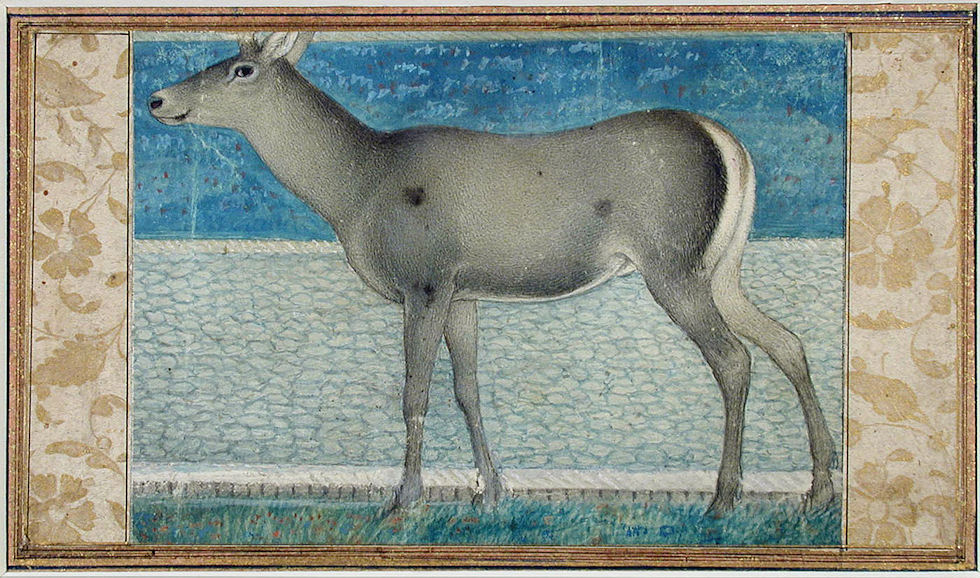
Abb.: राम: ।
Boselaphus tragocamelus Pallas, 1766 - Nilgauantilope - Nilgai, ca. 1655
[Bildquelle: Asian Curator at The San Diego Museum of
Art. --
http://www.flickr.com/photos/asianartsandiego/4835694359/. -- Zugriff am
2011-03-06. --
Creative Commons Lizenz (Namensnennung, keine kommerzielle Nutzung,
keine Bearbeitung)]
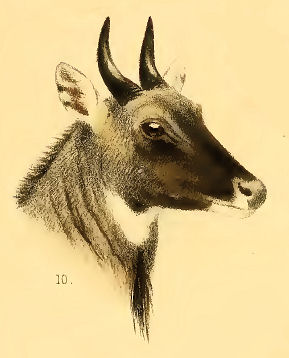
Abb.: राम: ।
Boselaphus tragocamelus Pallas, 1766 - Nilgauantilope - Nilgai
[Bildquelle: Lydekker, Richard <1849 - 1915>: The great and small game of India, Burma, & Tibet. --
London, 1900. -- Pl. 5]

Abb.: राम: ।
व्Boselaphus tragocamelus Pallas, 1766 - Nilgauantilope - Nilgai,
Keoladeo National Park - केवलादेव राष्ट्रीय उद्यान, Rajasthan
[Bildquellle: Thomas Schoch / Wikimedia. -- GNU FDLicense]
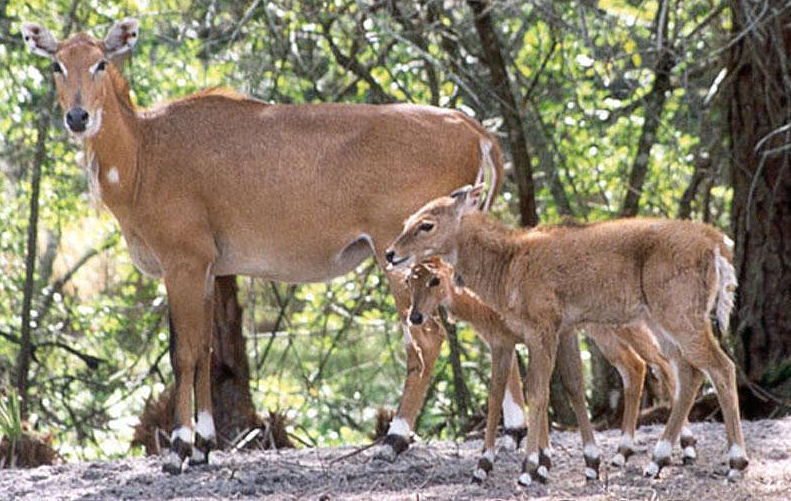
Abb.: रामाः ।
Boselaphus tragocamelus Pallas, 1766 - Nilgauantilope - Nilgai,
Weibchen mit Jungen
[Bildquelle: Lisa Purcell / Wikimedia. -- GNU FDLicense]
|
"The Nil-gai is found throughout India, from
near the foot of the Himalayas to the extreme south of Mysore, but is rare
to the north of the Ganges, and also in the extreme south of
India. It is most abundant in Central India, and in the country between
the Jumna and Sutlej, but is rare in the Punjab, according to
Adams. It does not occur in Ceylon, nor in Assam, or the countries to the
east of the Bay of Bengal. It frequents thin forests and low jungles,
and is often found in tolerably open plains with only a few
scattered bushes. It does not affect a hilly country, but does not avoid
low hills clad with thin forest. It is indifferent to the sun, except during
the hottest weather. It associates in small herds, varying from seven
or eight to twenty and upwards. It appears to go at a lumbering
ungainly pace, yet it requires a good horse and a hard run to
overtake one, and the only way to succeed certainly, is to press the
animal with the utmost speed at first and blow him.
The Nil-gai is not much sought after by the
Indian sportsman, nor is its flesh highly esteemed, yet at times it is
excellent and juicy, and gives a good beef-steak.
It is often caught young and becomes very
tame, many being allowed to wander about at large. They are apt,
however, to get vicious at times. It browses a good deal, and is very fond of
many kinds of fruit. Mr. Elliot says that those he kept used to drop
on their knees to feed, and attacked and defended themselves by butting
with the head. A very dark, almost black one, was lately seen by
more than one sportsman near Umballa. Blyth, Ogilby, and other
naturalists, consider that the Nil-gai was probably the Hippelaphus of
Aristotle, and not the Samber deer, which opinion I quite endorse."
[Quelle: Jerdon,
Thomas Claverhill <1811-1872>: The mammals of India : a natural history of
all the animals known to inhabit continental India. -- London, 1874. -- S.
272f.] |
2.9.23. सृमर - sṛmara m.: Ein großes Wildschwein (Sus scrofa
var.)
| 11. a./b.
gandharvaḥ śarabho rāmaḥ
sṛmaro
gavayaḥ śaśaḥ
गन्धर्वः शरभो रामः सृमरो
गवयः शशः ।११ क।
सृमर - sṛmara m.:
ein großes Wildschwein (Sus scrofa
var.) |
Colebrooke (1807):
Ein großes Wildschwein (Sus scrofa
var.)
|
"There are
two distinct kinds of boar in India, the black and the grey. Their
dispositions are very different, the grey being fiercer and more
pugnacious.
He
is a vicious and implacable foe when roused, and
always shows better fight than the black variety. The great
difference, however, is in the shape of the skull ; that of the
black fellow being high over the frontal bone, and not very long in
proportion to height, while the skull of the grey boar is never very
high, but is long, and receding in proportion to height. The black
boar grows to an enormous size, and the grey ones are, generally
speaking, smaller made animals than the black. The young of the two
also differ in at least one important particular ; those of the grey
pig are always born striped, but the young of the black variety are
born of that colour, and are not striped but a uniform black colour
throughout. The two kinds of pig sometimes interbreed, but crosses
are not common; and, from the colour, size, shape of the head, and
general behaviour, one can easily tell at a glance what kind of pig
gets up before his spear, whether it is the heavy, sluggish black
boar, or the veritable fiery, vicious, fighting grey tusker.
Many
stories are told of their
enormous size, and a "forty-inch tusker" is the established standard
for a Goliath among boars. The best fighting boars, however, range
from twenty-eight to thirty-two inches' in height, and I make bold
to say that very few of the present generation of sportsmen have
ever seen a veritable wild boar over thirty-eight inches high.
G. S., who has had perhaps as
much jungle experience as any man of his age in India. a careful
observer, and a finished sportsman, tells
me
that the biggest boar he ever
saw was only thirty-eight inches high ; while the biggest pig he
everkilled was a barren sow, with three-inch tusks sticking out of
her gums ; she measured thirty-nine-and-a-half inches, and fought
like a demon. I have shot pig in heavy jungle where spearing was
impracticable over thirty-six inches high, but the biggest pig I
ever stuck to
my
own spear was only twenty-eight inches, and I do
not think any pig has been killed in Chumparun, within the last ten
or a dozen years at any rate, over thirty-eight inches."
[Quelle: Inglis, James <1845 - 1908>:
Tent life in Tigerland, with which is incorporated Sport and work on
the Nepaul frontier. Being twelve years’ sporting reminiscences of a
pioneer planter in an Indian frontier district. -- London,
Low, Marston, 1892. -- xxiv, 690 S. : Ill. ; 26 cm. -- S.
444f. -- Online:
http://www.archive.org/details/tentlifeintigerl00ingliala. --
Zugriff am 2007-10-31] |
2.9.24. Bos frontalis Lambert, 1804 - Gaur
| 11. a./b.
gandharvaḥ śarabho rāmaḥ sṛmaro
gavayaḥ
śaśaḥ गन्धर्वः
शरभो रामः सृमरो गवयः शशः ।११
क। गवय - gavaya
m.: Bos frontalis Lambert, 1804 - Gaur |
Colebrooke (1807): "Bos Gavaeus, As. Res. vol. viii. p. 487."
gavaya = Bos frontalis Lambert, 1804 - Gaur
(Nepal, Indien)
Größtes (tierisches) Rindvieh der Welt
Schulterhöhe: 165 - 195 cm
Gewicht: 800 - 1200 kg
Lebensraum: West-Ghats, Zentral- und Südostindien, Westbengalen, Nordostindien
Noch in Freiheit lebende Individuen: ca. 20.000
Lebt in Herden von 5 - 30 Tieren, bzw. als Einzelgänger
Gegenüber Menschen im Allgemeinen gutmütig
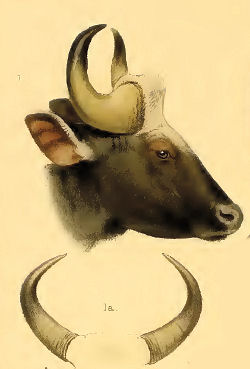
Abb.: गवयः ।
Bos frontalis Lambert, 1804 - Gaur
[Bildquelle: Lydekker, Richard <1849 - 1915>: The great and
small game of India, Burma, & Tibet. -- London, 1900. -- Pl. 2]
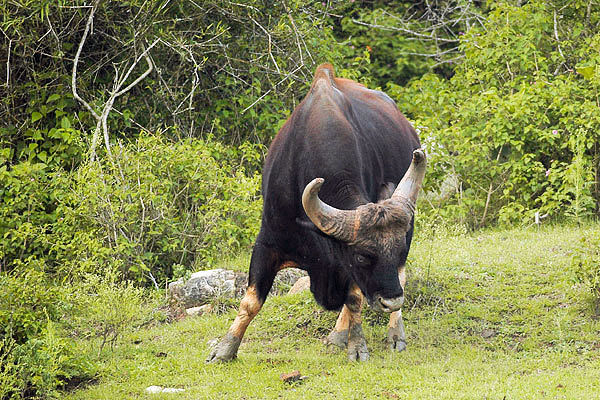
Abb.: गवयः ।
Bos frontalis Lambert, 1804 - Gaur, Bandipur National Park -
ಬಂಡಿಪುರ ರಾಷ್ಟ್ರೀಯ ಉದ್ಯಾನವನ, Karnataka
[Bildquelle: Yathin SK / Wikipedia. --
Creative
Commons Lizenz (Namensnennung)]
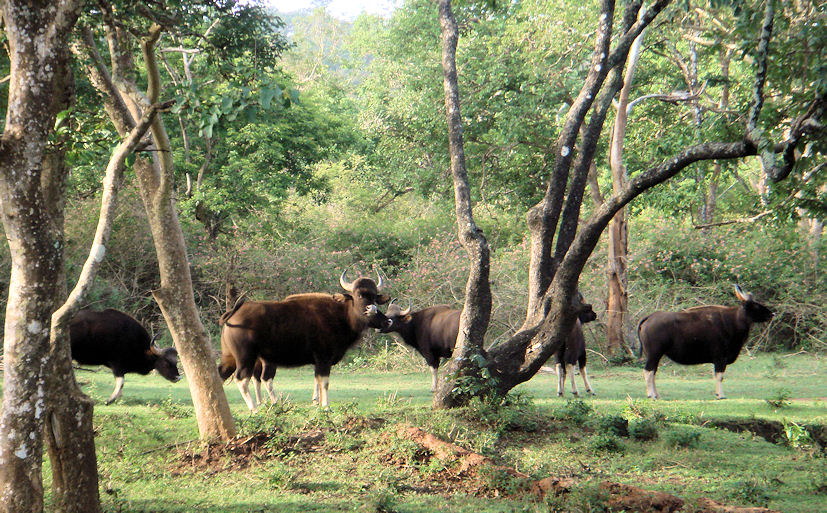
Abb.: गवयाः ।
Bos frontalis Lambert, 1804 - Gaur, Bandipur National Park -
ಬಂಡಿಪುರ ರಾಷ್ಟ್ರೀಯ ಉದ್ಯಾನವನ, Karnataka
[Bildquelle: Sumeet Mulani. --
http://www.flickr.com/photos/teemus/3810481695/. -- Zugriff am 2010-12-10.
-- Creative Commons
Lizenz (Namensnennung, keine kommerzielle Nutzung, share alike)]
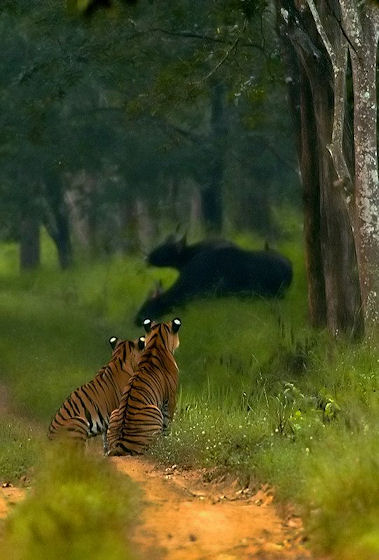
Abb.: गवयौ ।
Tiger und Bos frontalis Lambert, 1804 - Gaur, Bhadra Wildlife Sanctuary - ಭದ್ರಾ ವನ್ಯಜೀವಿ ಅಭಯಾರಣ್ಯ,
Karnataka
[Bildquelle: Yathin. --
http://www.flickr.com/photos/yathin/830539712/. -- Zugriff am 2010-12-10. --
Creative Commons
Lizenz (Namensnennung, keine kommerzielle Nutzung, keine Bearbeitung)]
|
"The Gaur is an inhabitant of all the large
forests of India, from near Cape Comorin to the foot of the Himalayas. On
the west coast of India it is abundant all along the Syhadree range
or Western Ghats, both in the forests at the foot of the hills, but more
especially in the upland forests, and the wooded country beyond the crest of the
Ghats. The Animally hills, the Neelgherries, Wynaad, Coorg, the
Bababooden hills, and the Mahableshewur hills, are all favourite haunts of this fine
animal. North of this it occurs, to my own knowledge, in the jungles
on the Taptee river, and neighbourhood, and, north of the Nerbudda, a
few on the deeper recesses of the Vindhian mountains. On the eastern
side of the peninsula it is found in the Pulney and Dindigul hills, the
Shandamungalum range, the Shervaroys, and some of the hill-ranges near
Vellore and the borders of Mysore. North of this, the forest being too
scanty, it does not occur till the Kishna and Godavery rivers ; and hence it
is to be found in suitable spots all along the range of Eastern Ghats to
near Cuttack and Midnapore, extending west far into Central India, and
northwards towards the edge of the great plateau which terminates
south of the Gangetic valley. According to Hodgson, it also occurs in the
Himalayan Terai, probably however only towards the eastern portion, and
here it is rare, for I have spoken to many sportsmen who have hunted in
various parts of the Terai, from Sikim to Rohilcund, and none have ever
come across the Gaur at the foot of the Himalayas.
It also occurs in the countries to the east
of the Bay of Bengal, from Burmah to the Malayan peninsula. Horsfield,
in his Catalogue, considered that a distinct race which he named Bibos
Asseel, from the native name Asseel gayal, i.e. the genuine gayal, in
contradistinction to the ordinary Gayal, Gavaeus frontalis. Blyth, however,
states that he knows the individual specimen on which this supposed race was
founded, and that it is only a female Gaur.
It was also formerly an inhabitant of Ceylon,
but has been extinct there for above 50 years.
Hodgson states in the Sub-Himalayan forests
it does not ascend the hills, and that it is not a mountain race at
all. Sportsmen in Southern India could tell Mr. Hodgson a different
account of its habits there, for it undoubtedly prefers hilly and even
mountainous countries, and I have seen it killed at above 6,000 feet of
elevation.
The Gaur associates in herds of various
numbers up to thirty and forty or more, though perhaps generally met in
smaller numbers, and a bull is often seen alone. The herd generally consist
of from ten to fifteen cows and a bull. They feed mostly at night, or
early in the morning, chiefly on grass, but also browsing on the tender
shoots of the bamboo, and during the heat of the day retire to some cool and
shady spot, the thick bed of a dry nullah, a dense clump of bamboos, or long
grass. Hodgson states that they never venture into the open Terai
to depredate on the crops, as the wild buffaloes constantly do. In southern
India, however, they do occasionally at least, according to Mr.
Fisher, as quoted by Mr. W. Elliot. "The chief food of the bison seems to be
various grasses, the castor-oil plant, and a species of convolvulus; but they
will eat with avidity any species of grain commonly cultivated in the hills or
plains, as the ryots find to their cost. The Bison is particularly fond of
the Avary cotty (Dolichos lablab) when in blossom; that they will invade
and destroy fields of it in open daylight, in despite of any resistance
the villagers can offer. In other respects it is a very inoffensive
animal, rarely attacking any one it encounters, except in the case of a single
bull driven from the herd. Such a one has occasionally been known to
take up his location in some deep bowery jungle, and deliberately quarter
himself on the cultivation of the adjacent villages. The villagers,
though ready to assist Europeans in the slaughter of bison, will not
themselves destroy them (the inviolability of the cow extending to the bison), and so
bold does this freebooting animal become in consequence, that he has
been known to drive the ryots from the fields, and deliberately devour the
produce. But in general it is a timid animal, and it is difficult to get
within gun-shot of them."
The same observer also remarks: "The bison
ordinarily frequents the hills, seeking the highest and coolest
parts, but during the hottest weather, and when the hills are parched by
the heat, or the grass consumed by fire, the single families in which they
commonly range the hills, congregate into large herds, and strike deep
into the great woods and valleys ; but after the first showers, and
when verdure begins to reappear, they again disperse and range about freely.
In wet and windy weather they again resort to the valleys to
escape its inclemency, and also to avoid a species of fly or gnat, which
harasses them greatly. In the months of July and August they regularly
descend to the plains for the purpose of licking the earth impregnated
with natron or soda, which seems as essential to their well-doing
as common salt is to the domestic animal when kept in hilly tracts."
The breeding season appears to be in the cold
weather, and the young are born from June to October, the greatest
number in August. The old male drives the others from the herd at the
breeding season, and the single ones seen in the jungle are young
males of this description : it is probable the very old bulls are sometimes
expelled also by younger and stronger males. The period of gestation is
said to be the same as with the cow or buffalo. Hodgson was informed that
it was longer.
The Gaur is, in general, one of the most
timid and wary of animals, and requires to be stalked most carefully. Where
the hills are grassy, with tracts of dense forest, they may be
discovered occasionally, early in the morning, feeding outside the forest, or even
lying down, in pretty close proximity, however, to the wood, and if very
carefully approached against the wind, and perfectly noiselessly, the
sportsman may get a favourable shot. Now and then too they are stalked in
the depth of the forest, a good tracker following them to their mid-day lair.
When disturbed, the first who perceives the intruder stamps loudly with
his foot to alarm the rest, and the whole rush through the forest,
breaking down every obstacle, and forcing their way with a terrible crash. When
suddenly approached in the night, they start off with a loud hissing
snort. The Gowlees say that they see great numbers of bison when
pasturing their herds in the neighbouring forest. They describe them as very timid and
watchful, more so than any other wild animal, always
reposing in a circle, with their heads turned outside, ready to take alarm.
The bison is generally driven towards the
sportsman by a line of beaters, he remaining concealed behind a tree.
A wounded bison will occasionally charge, and several fatal
instances are recorded ; but in general he will turn and seek safety in
flight. Hodgson says that "in the Tarai, the Gaur will pursue his
assailant, and if he climb a tree, will watch for a whole day," but this account is
evidently from native shikarees, and such conduct must be perfectly
exceptional. Mr. Elliot remarks that "the persevering ferocity of
the bison of the Sub-Himalayan range," described by Mr. Hodgson, "is quite foreign to the character of the animal in southern forests."
Various attempts have been made to rear the
young Gaur, but they have all failed, the young animal never living
over his third year. Blyth had a young calf at Calcutta, procured near
Singapore, which he shipped for England, but it died on the voyage. An
engraving of a photograph of this calf was published in the "Illustrated
London News." "It was tame and tractable," says Blyth, "yet full of life and frolic." The natives of Malabar, according to Buchanan Hamilton's
MSS., assert that bisons take up stones with their nostrils, and
discharge them at their adversaries with the force of a musket-ball, and that the
wound is always mortal !
The flesh of the Gaur is excellent if not too
old, and the marrow-bones and tongue are delicacies always preserved by
the successful sportsman.
The Gayal or Mtihun, Gavaeus frontalis, is
found in the hilly tracts to the east of the Burrampooter, and at the head
of the valley of Assam, the Mishmi hills and their vicinity, probably
extending north and east into the borders of China. It is domesticated
extensively and easily, and has bred with the common Indian cattle. It is a heavy,
clumsy -looking animal compared with the Gaur, the wild animal similarly
coloured and with white legs. It browses more than the Gaur, and, unlike
that, it has a small but distinct dewlap. The domesticated race extends south
as far as the Tippera and Chittagong hills, and northwards, has been
seen grazing in company with the Yak, close to the snows. It is better
adapted for rocky and precipitous ground than the Gaur. Gayals have often been
taken alive to Calcutta.
The Bos Sylhetanus, figd. by M. F. Cuvier, is
a hybrid with the Zebu.
The Banteng, or Burmese wild cow, Gavaeus
sondaicus, extends northwards as far as the interior of the Chittagong
hills, where all three species meet, according to the testimony of
the Rev. M. Barbe. South it extends through Burmah and the Malayan
peninsula to the larger islands. The young and the cow are red in
this species, which resembles the Gaur more than the Gayal, and it wants
the dewlap. It is the Tsoing of the Burmese, the Gaur being the Pyaung. A
young male is now living in the London Zoological Gardens."
[Quelle: Jerdon,
Thomas Claverhill <1811-1872>: The mammals of India : a natural history of
all the animals known to inhabit continental India. -- London, 1874. -- S.
303ff.] |
Siehe:
Carakasaṃhitā: Ausgewählte Texte aus der Carakasaṃhitā
/ übersetzt und erläutert von Alois Payer <1944 - >. -- Anhang B: Tierbeschreibungen. --
Bos frontalis. -- URL:
http://www.payer.de/ayurveda/tiere/bos_frontalis.htm
2.9.25. Hasen und Kaninchen
| 11. a./b.
gandharvaḥ śarabho rāmaḥ sṛmaro gavayaḥ
śaśaḥ गन्धर्वः
शरभो रामः सृमरो गवयः शशः ।११ क।
शश - śaśa m.: Hase, Kaninchen |
Colebrooke (1807): "A hare."
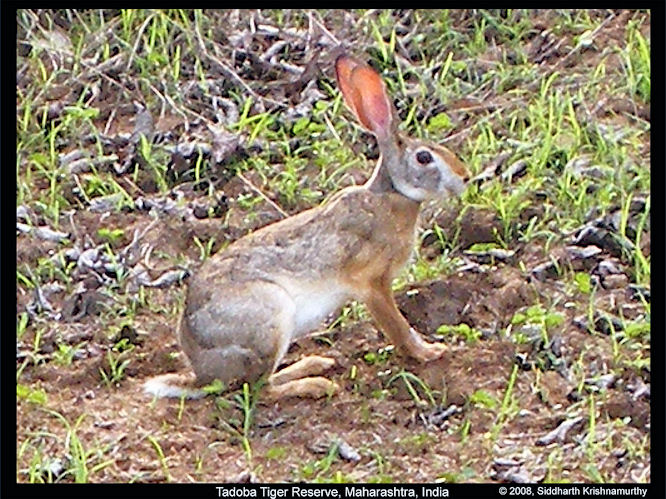
Abb.: शशः ।
Wildhase / Wildkaninchen, Tadoba Andhari Tiger Project - ताडोबा राष्ट्रीय
उद्यान, Maharashtra
[Bildquelle: Siddharth Krishnamurti. --
http://www.flickr.com/photos/scid/2669750699/. -- Zugriff am 2010-12-16. --
Creative
Commons Lizenz (Namensnennung, keine kommerzielle Nutzung, keine
Bearbeitung)]
In Indien kommen u.a. folgende Arten von Hasen / Kaninchen vor
- Caprolagus hispidus
Pearson, 1839 - Borstenkaninchen - Hispid
Hare (Fuß des Himalaya)
- Lepus nigricollis F. Cuvier, 1823
- Schwarznackenhase - Indian Hare (Blacknaped Hare)
(ganzer Subkontinent)
- Lepus oiostolus Hodgson, 1840 -
Tibetanischer Wollhase - Wooly Hare (Nepal)
Caprolagus hispidus
Pearson, 1839 - Borstenkaninchen - Hispid
Hare
Körpergröße: 40 - 50 cm
Gewicht: 2 - 3 kg
Lebensraum: Terai und Himalayavorberge
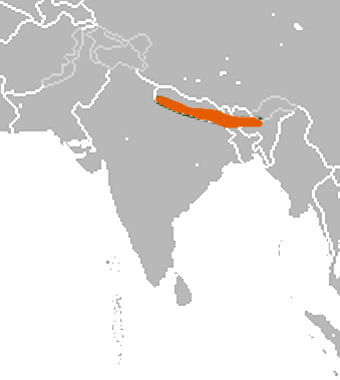
Abb.: Lebensraum von Caprolagus hispidus
Pearson, 1839 - Borstenkaninchen - Hispid
Hare
[Bildquelle: Chermundy - IUCN / Wikipedia. --
Creative Commons
Lizenz (Namensnennung, share alike)]
|
"This curious hare is of a very dark hue, of a
heavy make, with small eyes, make more rabbit-like, with small eyes,
short and stout limbs, and short whiskers. It is popularly called
the black rabbit at Dacca and elsewhere, and it is said to burrow in the
ground like rabbits. It inhabits the Terai at the foot of the Himalayas, from
Goruckpore to Assam, extending south to Dacca, and probably still further,
and even it is said to the Rajmahal hills. It frequents jungly
places, long grass, bamboos, &c., shunning observation ; and, from its
retired habits, is very difficult to observe and obtain ; and it perhaps has a
more extended distribution through lower Bengal than that noted above. I
have only seen it near Dacca. The flesh is stated to be white, like that of the
rabbit."
[Quelle: Jerdon,
Thomas Claverhill <1811-1872>: The mammals of India : a natural history of
all the animals known to inhabit continental India. -- London, 1874. -- S.
226.] |
Lepus nigricollis F. Cuvier, 1823
- Schwarznackenhase - Indian Hare (Blacknaped Hare)
Hat 13 Unterarten.
Körpergröße: 40 - 50 cm
Gewicht: 2 - 4 kg
Lebensraum: ganz Indien (außer Mangroven), bis 2400 m ü. M.
Mäncchen verteidigt bis zu 10 ha Territorium gegen andere Männchen
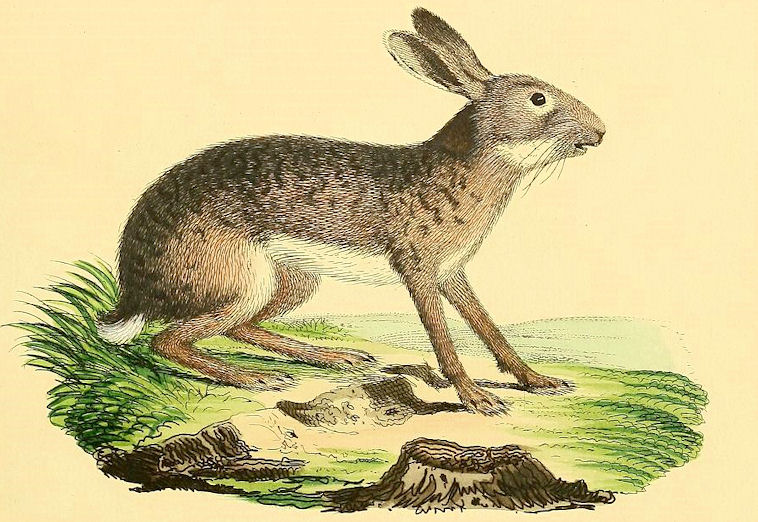
Abb.: Lepus nigricollis F. Cuvier, 1823
- Schwarznackenhase - Indian Hare / Blacknaped Hare
[Bildquelle: Die Säugthiere in Abbildungen nach der Natur,
mit Beschreibungen von Johann Christian Daniel von Schreber ... Fortgesetzt von
d. August Goldfuss ..., 1797 - 1861. -- Tafel CCXXXIII.F]
|
"This hare is found from the foot of the
Himalayas southwards to the Godavery river on the east, and on the west
as far south as the Taptee river at all events, perhaps further. It
extends from the Punjab to Assam. It is stated by the Rev. H. Baker also
to occur in South Malabar along with the next species, but no
specimens appear to have been sent, and I rather doubt its occurrence
there. It is also supposed to extend into Afghanistan, the skull of a
hare from Kandahar being very similar to that of our hare ; perhaps,
however, Mr. Blyth suggests, that of a nearly allied species.
Hares are very abundant in parts of the
North-west Provinces, and excellent coursing is had near Delhi, and
especially in Hurriana. They are less common in the Punjab.
Both this and the next species take to earth
readily when pursued, and appear to be well acquainted with all the
fox-holes in their neighbourhood."
[Quelle: Jerdon,
Thomas Claverhill <1811-1872>: The mammals of India : a natural history of
all the animals known to inhabit continental India. -- London, 1874. -- S. 224.] |
|
"The black-naped hare is found throughout the
South of India, extending north to the Godavery river on the east, and
on the west coast as high as the Taptee river, and perhaps further,
for Adams states it to be found in Sindh, and parts of the Punjab ; but
this much requires confirmation. It is the hare of Ceylon also, and has been
introduced into Java and the Mauritius. It is very abundant in
many parts of the Madras Presidency, more especially on the east coast and in parts
of the Deccan."
[Quelle: Jerdon,
Thomas Claverhill <1811-1872>: The mammals of India : a natural history of
all the animals known to inhabit continental India. -- London, 1874. -- S.
225.] |
Lepus capensis Linnaeus 1758 - Kaphase - Cape Hare
Körpergröße: 40 - 50 cm
Gewicht: 1 - 3.5 kg
Lebensraum: Jammu und Kashmir
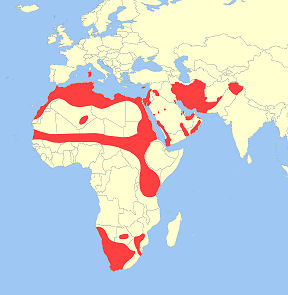
Abb.: Lebensräume von Lepus capensis Linnaeus 1758 - Kaphase - Cape Hare
[Bildquelle:
Mysid & IUCN / Wikipedia. --
Creative Commons
Lizenz (Namensnennung, share alike)]
Lepus oiostolus Hodgson, 1840 -
Tibetanischer Wollhase - Wooly Hare
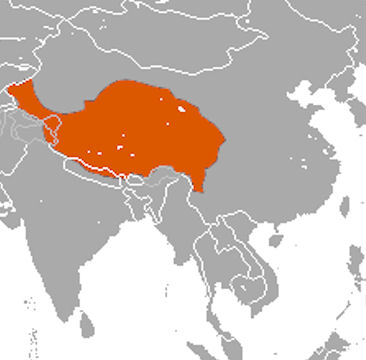
Abb.: Lebensraum von Lepus oiostolus Hodgson, 1840 -
Tibetanischer Wollhase - Wooly Hare
[Bildquelle: Chermundy - IUCN / Wikipedia. --
Creative Commons
Lizenz (Namensnennung, share alike)]
Siehe:
Carakasaṃhitā: Ausgewählte Texte aus der Carakasaṃhitā
/ übersetzt und erläutert von Alois Payer <1944 - >. -- Anhang B: Tierbeschreibungen. -- Leporidae. -- URL:
http://www.payer.de/ayurveda/tiere/leporidae.htm
2.9.25.1. Der Hase im Mond
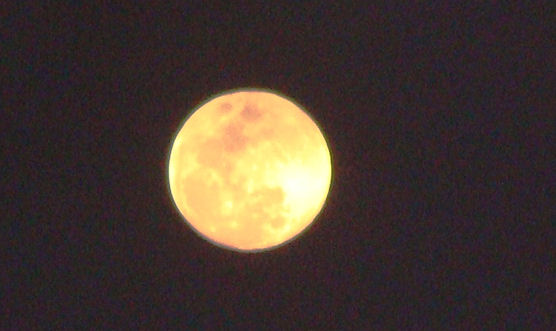
Abb.: शशी । śaśī (śaśin) - der durch einen besonderen Hasen Gekennzeichnete =
der Mond (beachten Sie die helle Fläche rechts!), Chennai -
சென்னை, Tamil Nadu
[Bildquelle: Arun.blue / Wikimedia. --
Creative Commons
Lizenz (Namensnennung, share alike)]
2.9.26. Vieh
| 11.c./d. ityādayo mṛgendrādyā gavādyāḥ paśujātayaḥ
इत्यादयो मृगेन्द्राद्या गवाद्याः पशुजातयः ॥११ ख॥
Die Genannten, der Löwe usf., Rinder usf.
sind Arten von पशु - paśu m.: Vieh, Tier |
Colebrooke (1807): "A beast in general. The preceeding, as
well as the lion and other wild beasts, and domestic cattle, are so denominated."
2.9.26.1. Paśupati, der Herr der Tiere

Abb.: Paśupatināth - पशुपतिनाथ, der Tempel des Śiva Paśupati, des
Herrn der Tiere, Kathmandu - काठमांडौ,
Nepal
[Bildquelle: Thapa.laxman / Wikipedia. -- Public domain]
2.9.27. Ratten und Mäuse
| 12. a./b. undurur mūṣiko 'py ākhur girikā bālamūṣikā
उन्दुरुर् मूषिको ऽप्य्
आखुर्
गिरिका बालमूषिका ।१२ क।
[Bezeichnungen für Ratten und Mäuse:]
- उन्दुरु - unduru m.: Unduru
- मूषिक - mūṣika m.:
Maus, Ratte
- आखु - ākhu m.:
Maulwurf, Maus
Eine junge (kleine) Ratte oder Maus
(बालमूषिका -
bālamūṣikā) heißt गिरि्का - girikā f.: "Bergbewohnerin". |
Colebrooke (1807): "A rat." [b:] "A mouse or small rat."
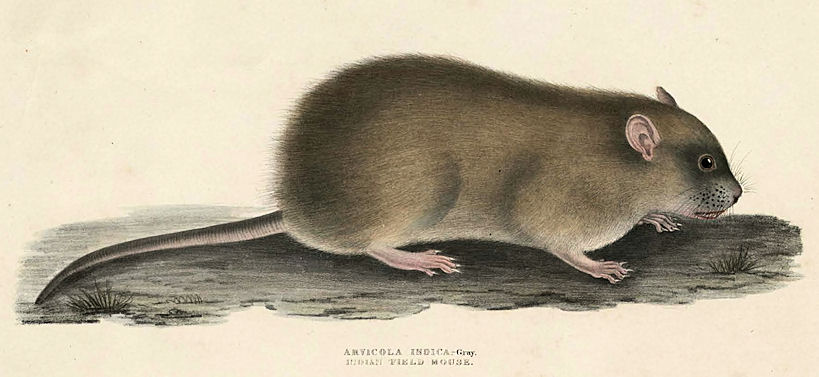
Abb.: मूषिकः ।
Indian Field Mouse
[Bildquelle: Hardwicke I, 1830. -- S. 34.]
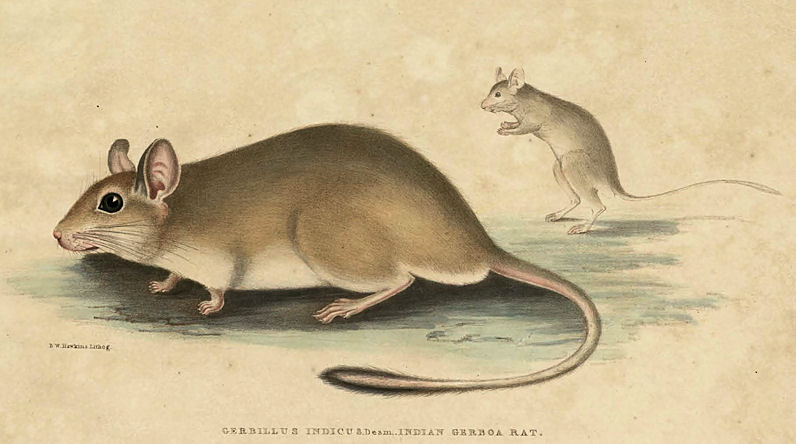
Abb.: मूषिकः ।
Indian Gerboa Rat
[Bildquelle: Hardwicke I, 1830. -- S. 32.]
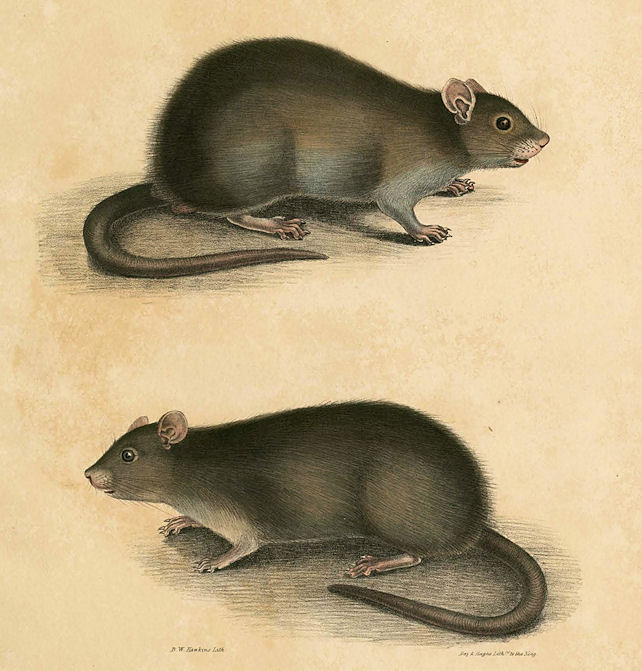
Abb.: Bengalische Schermaus
[Bildquelle: Hardwicke II, 1833. -- S. 50.]
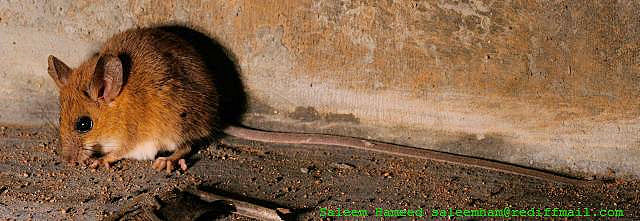
Abb.: बालमूषिका
।
Vandeleuria oleracea Bennett, 1832 - Indomalayan Vandeleuria (Asiatic Long-tailed Climbing
Mouse), Bannerghatta National Park - ಬನ್ನೇರುಘಟ್ಟ ನ್ಯಾಷನಲ್ ಪಾರ್ಕ್, Karnataka
[Bildquelle: Saleem Hameed / Wikipedia. --
Creative Commons
Lizenz (Namensnennung)]

Abb.: बालमूषिका
।
Meriones hurrianae Jerdon, 1867 - Indian Desert Jird, Pokaran -
पोखरण, Rajasthan
[Bildquelle: AshLin / Wikipedia. --
Creative Commons
Lizenz (Namensnennung, share alike)]
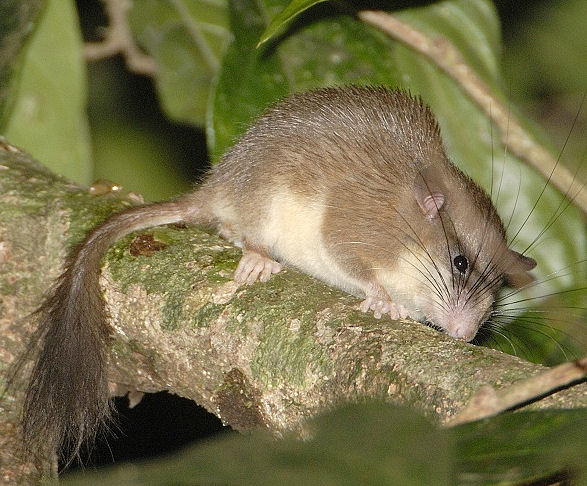
Abb.:बालमूषिका
। Platacanthomys lasiurus Blyth, 1859 - Spiny Tree Mouse,
Chalakudi Reserve Forest
[Bildquelle: Kalyanvarma / Wikipedia. --
Creative Commons
Lizenz (Namensnennung, share alike)]
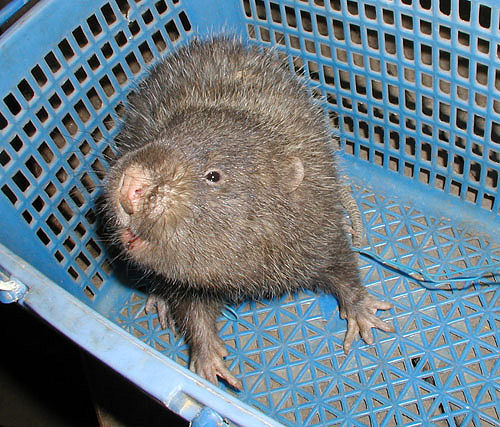
Abb.: उन्दुरुः । Cannomys badius Hodgson, 1841 - Lesser Bamboo Rat, Phongsali -
ຜົ້ງສາລີ, Laos
[Bildquelle: Roadnottaken / Wikipedia. -- GNU FDLicense]
Zu siṃhādivargaḥ
III. (Vers 12c - 14b): Echsen, Spinnen, Tausendfüßler, Raupen, Skorpione



























































































































